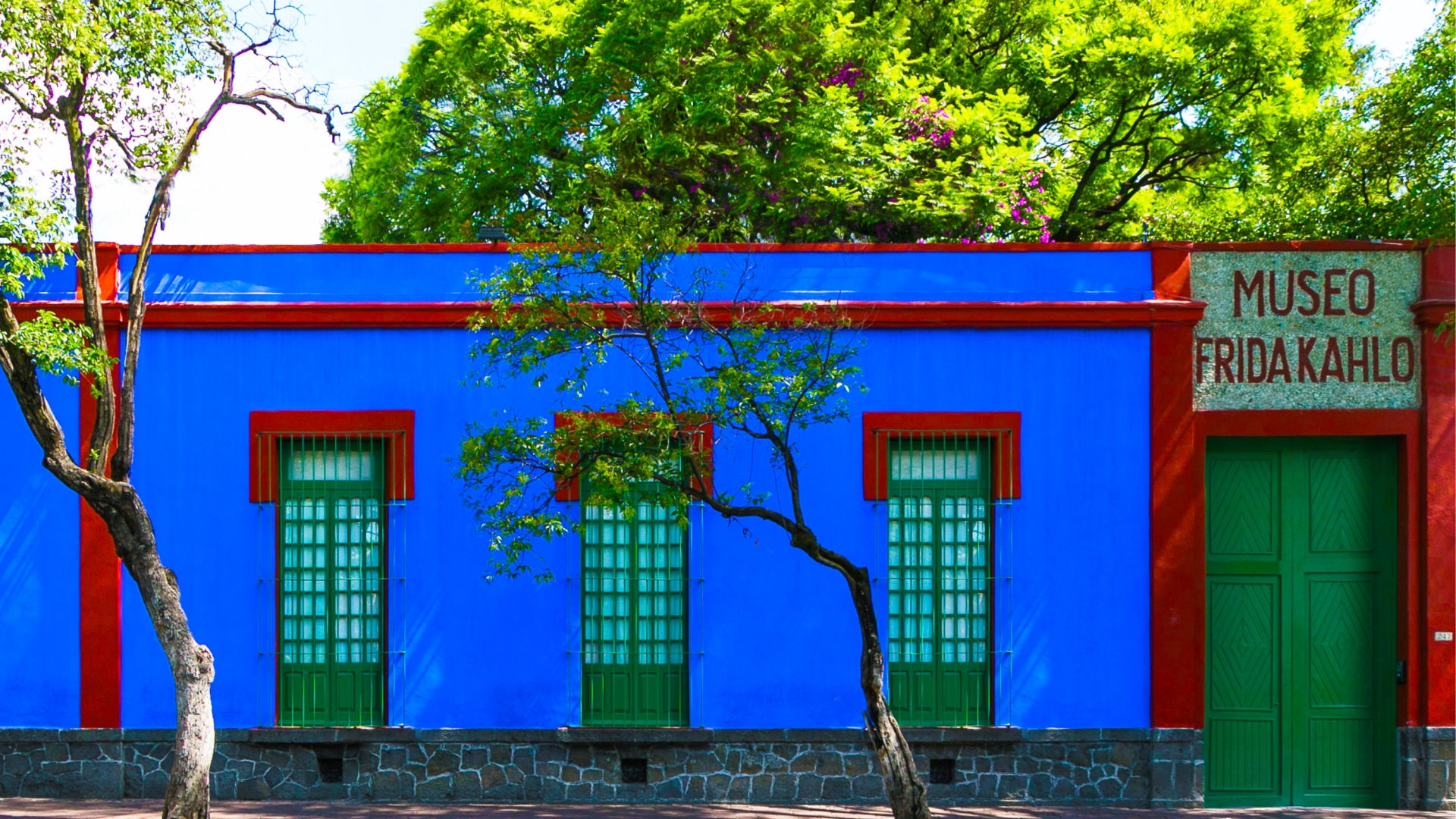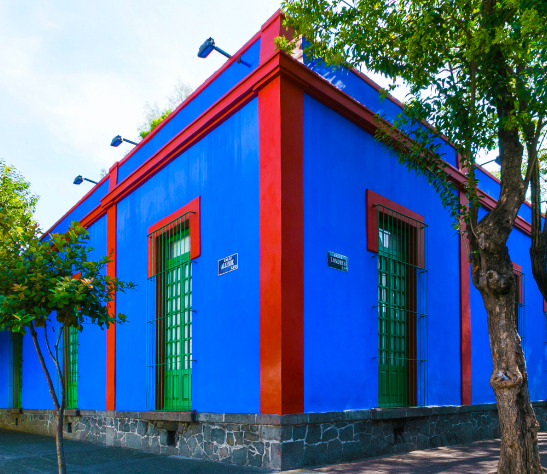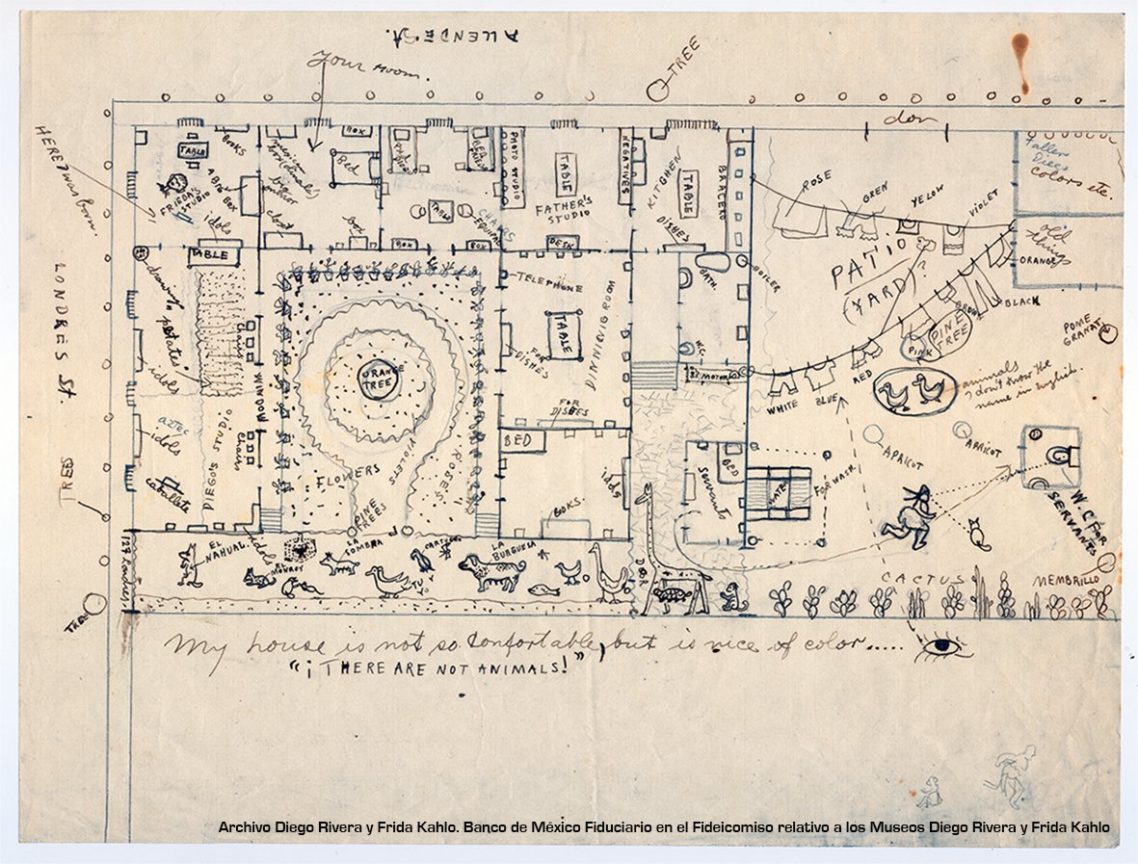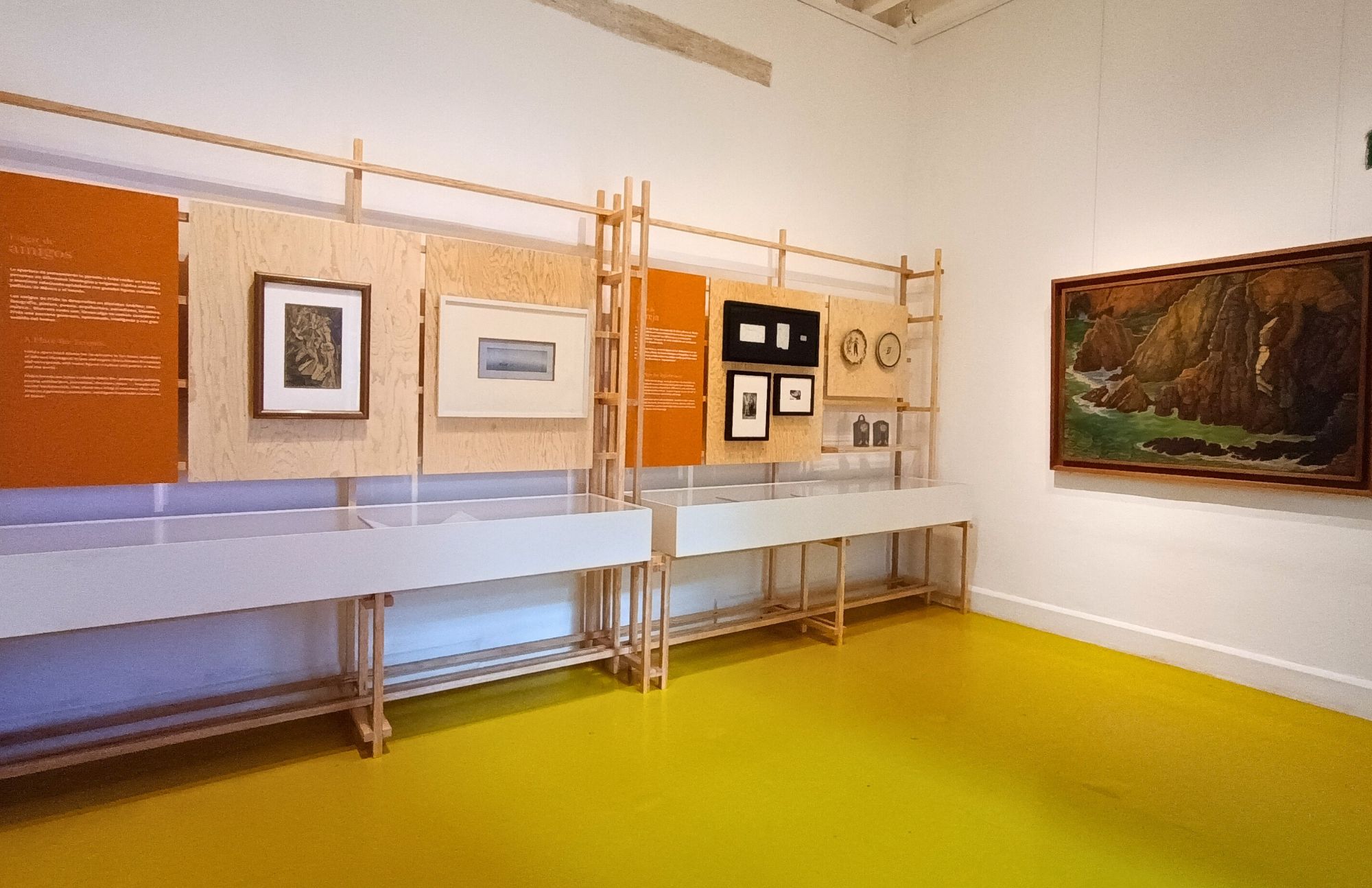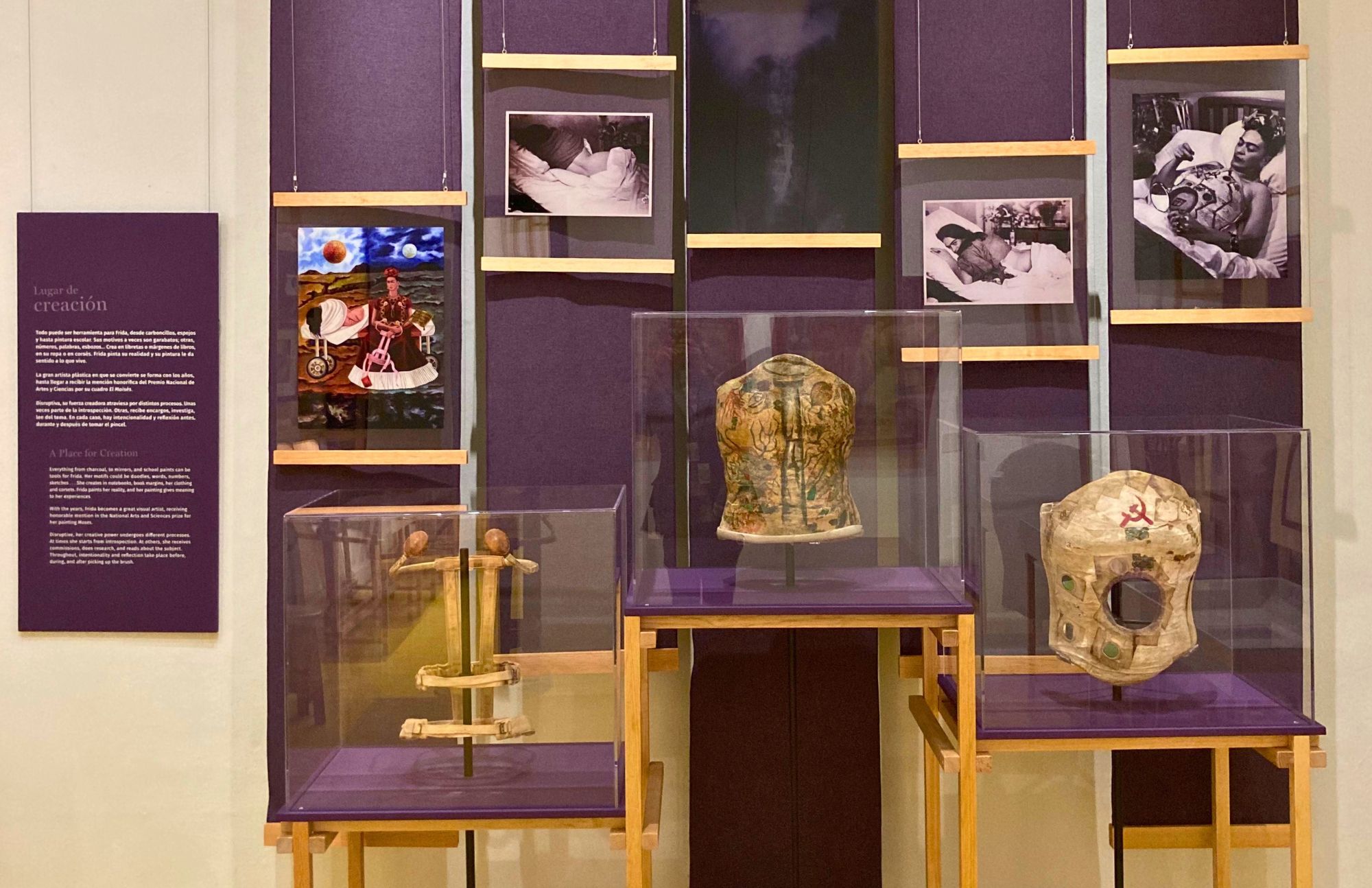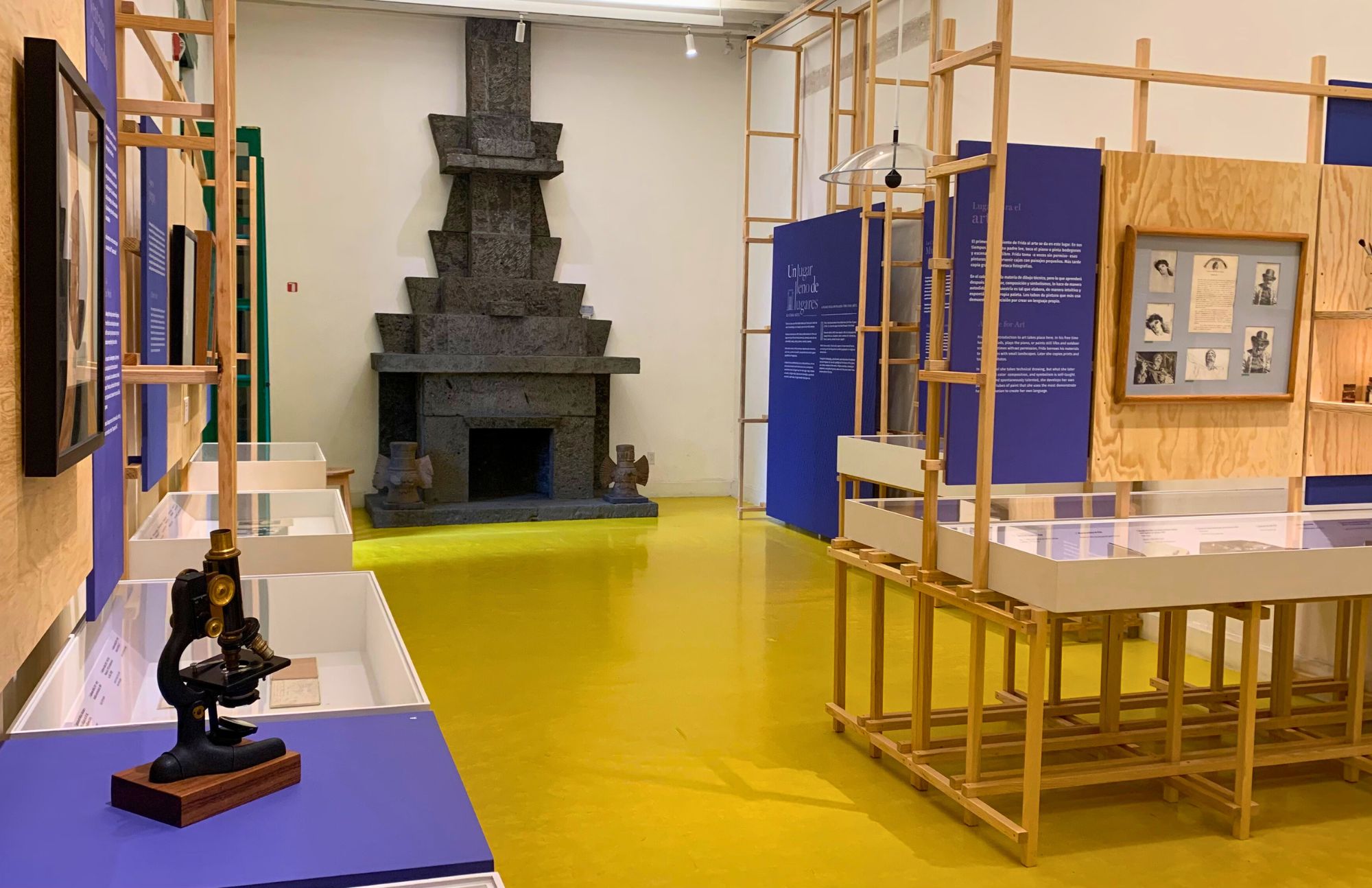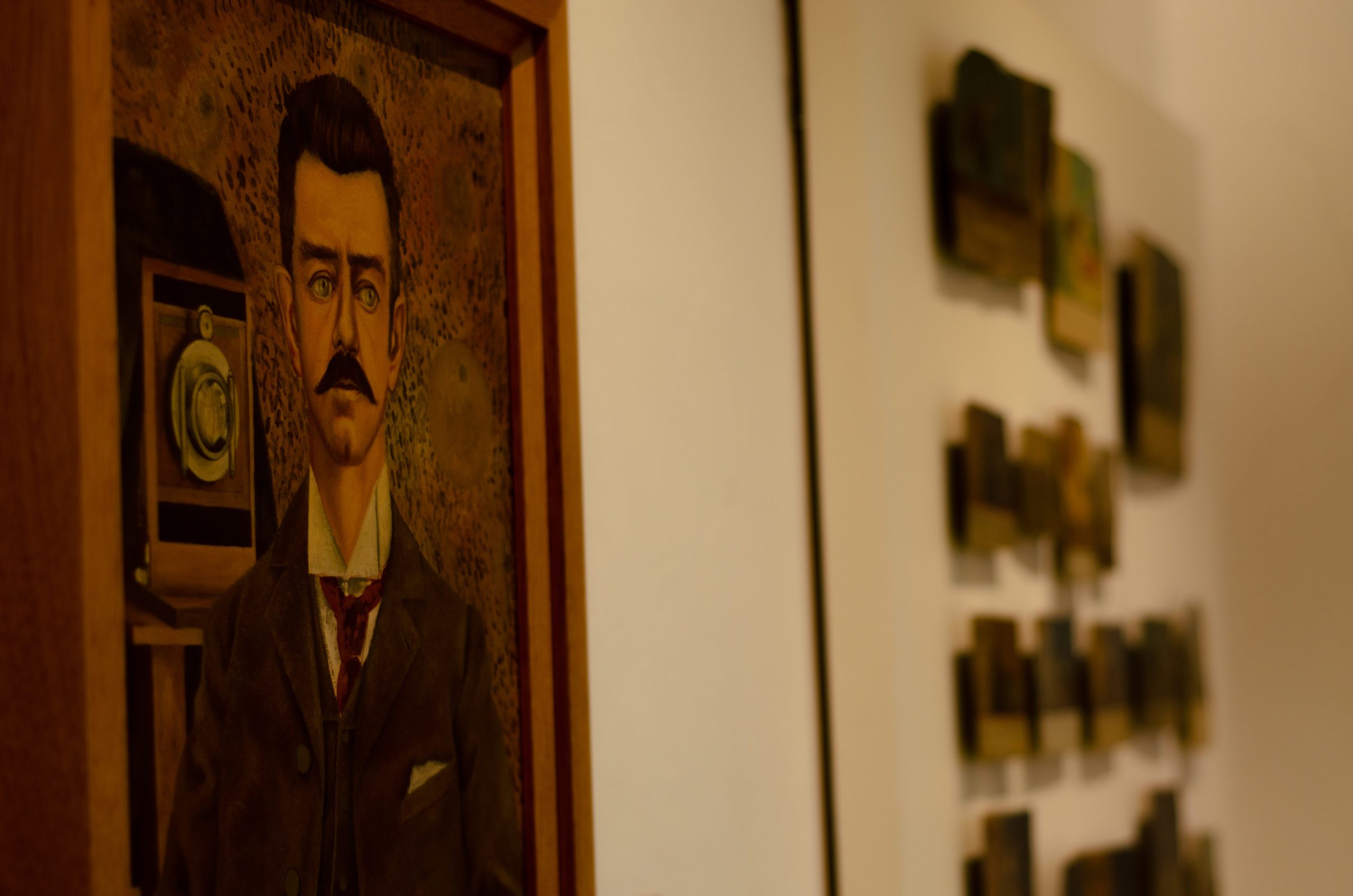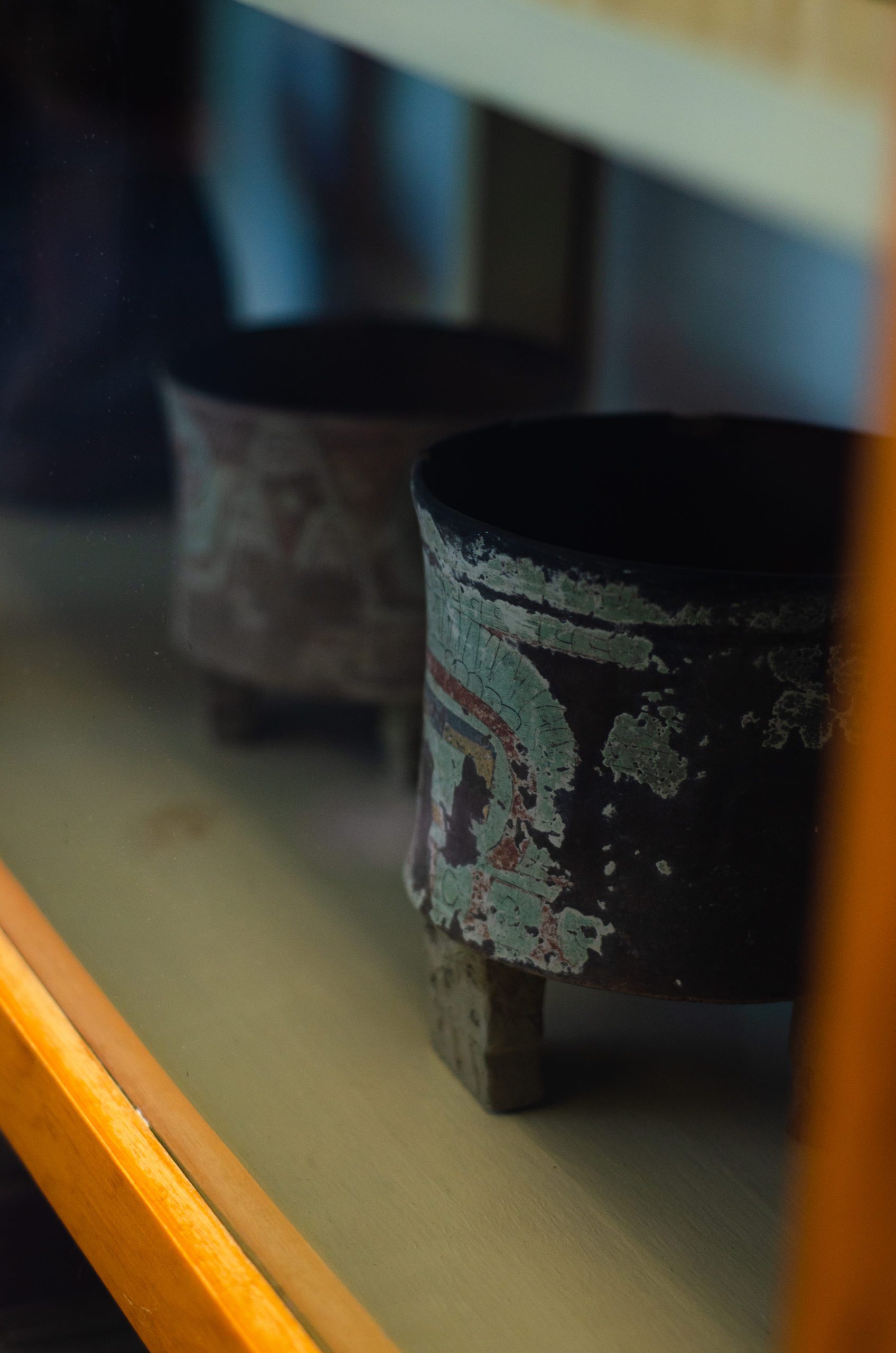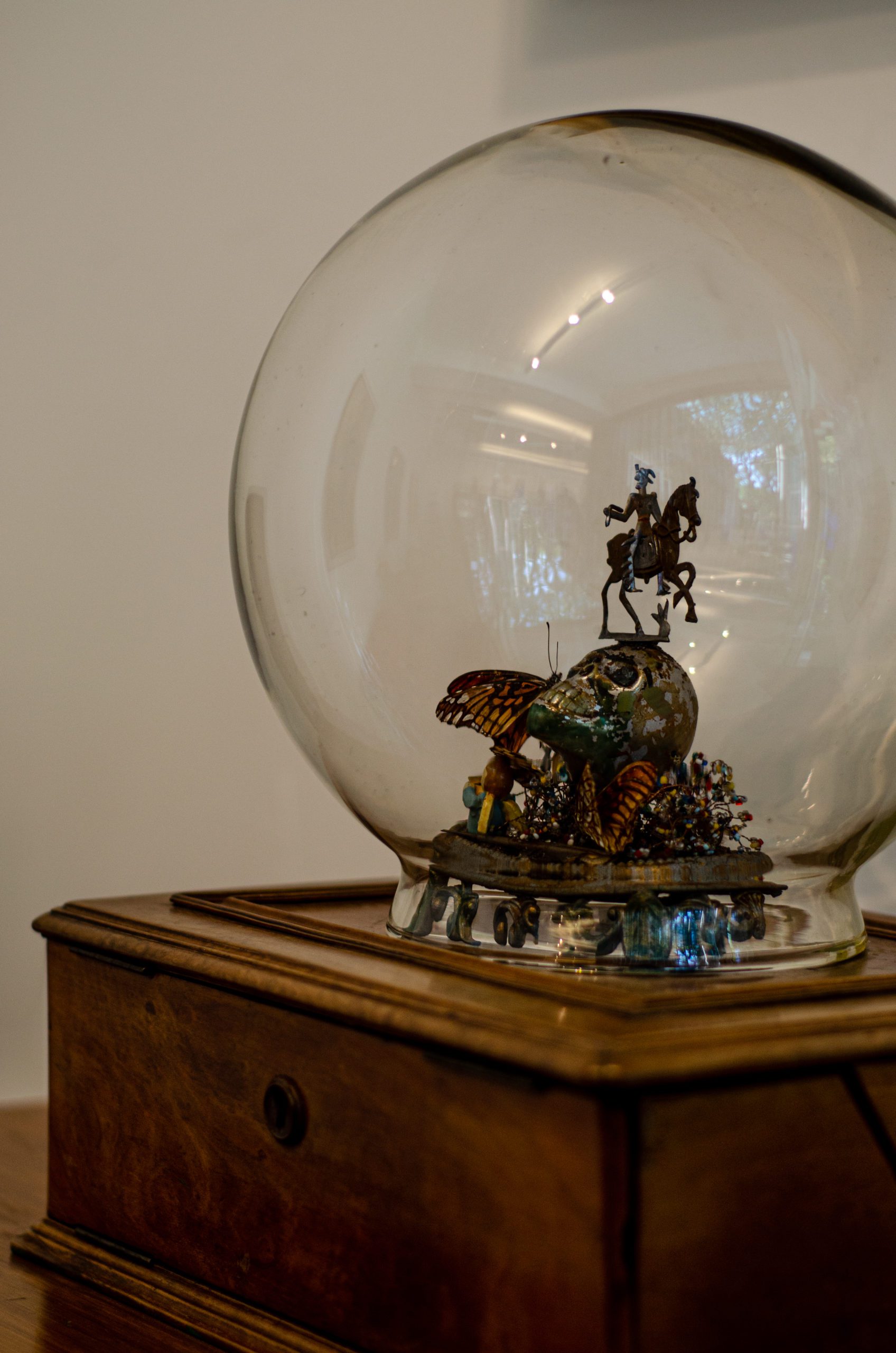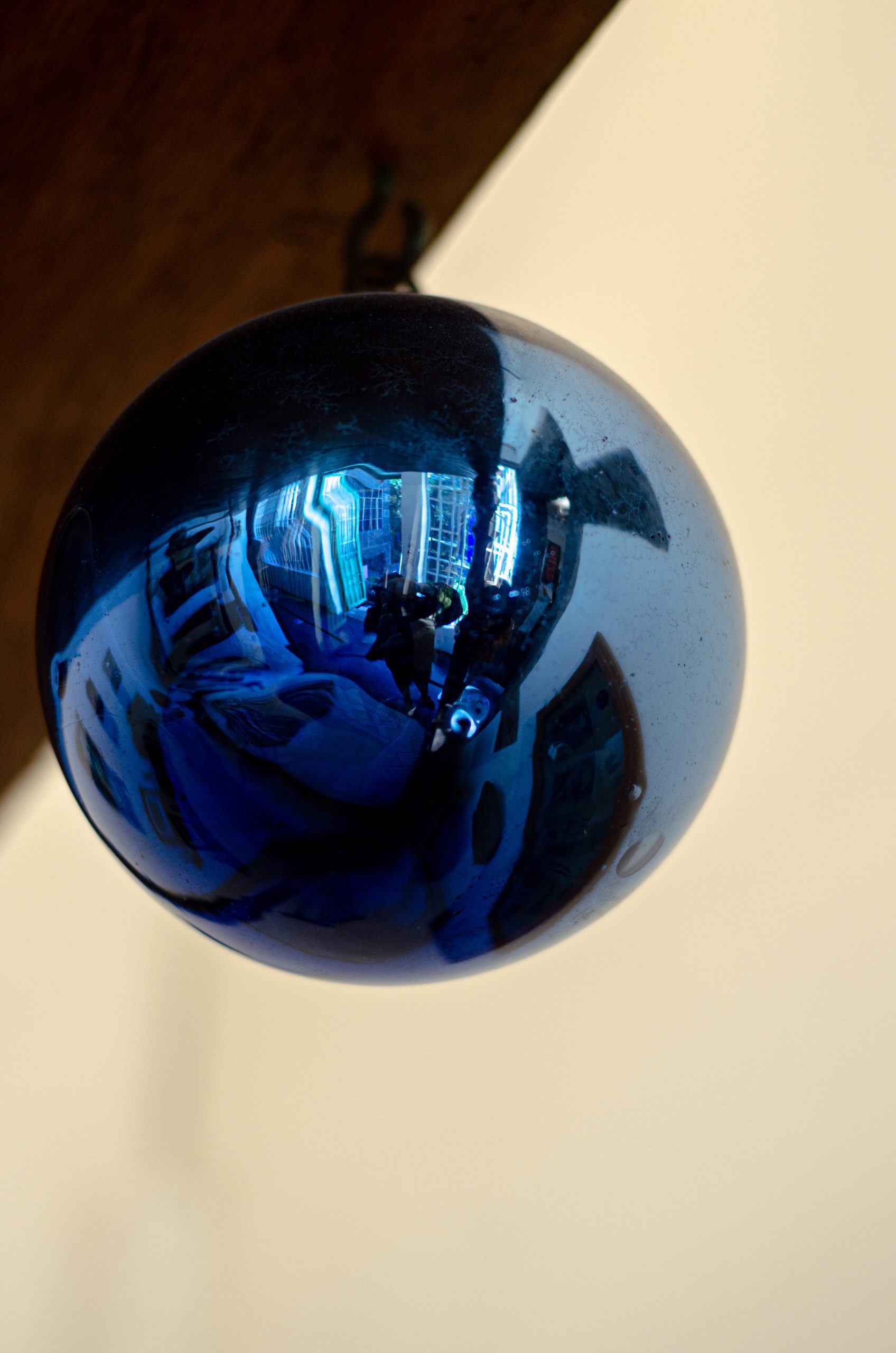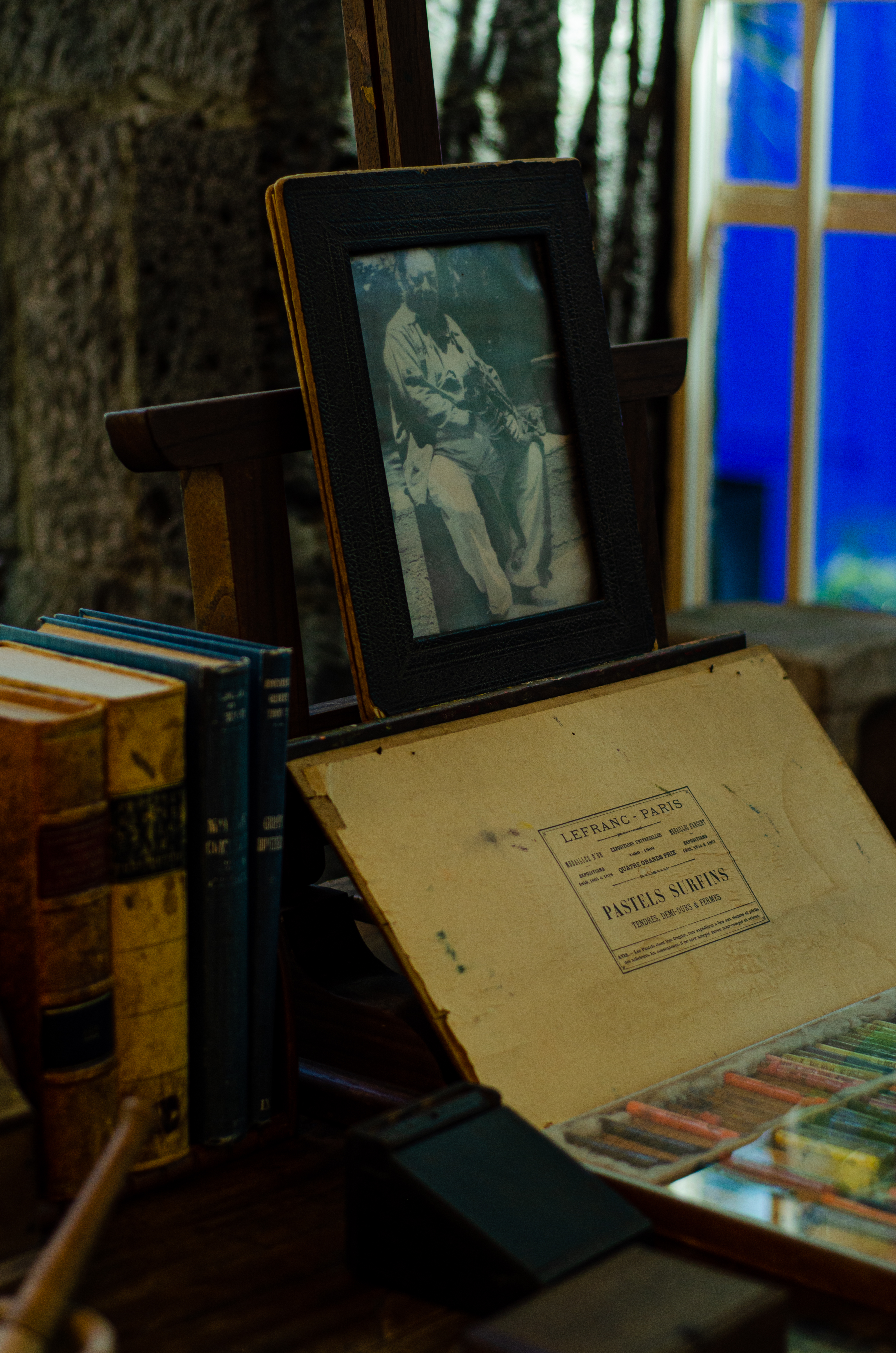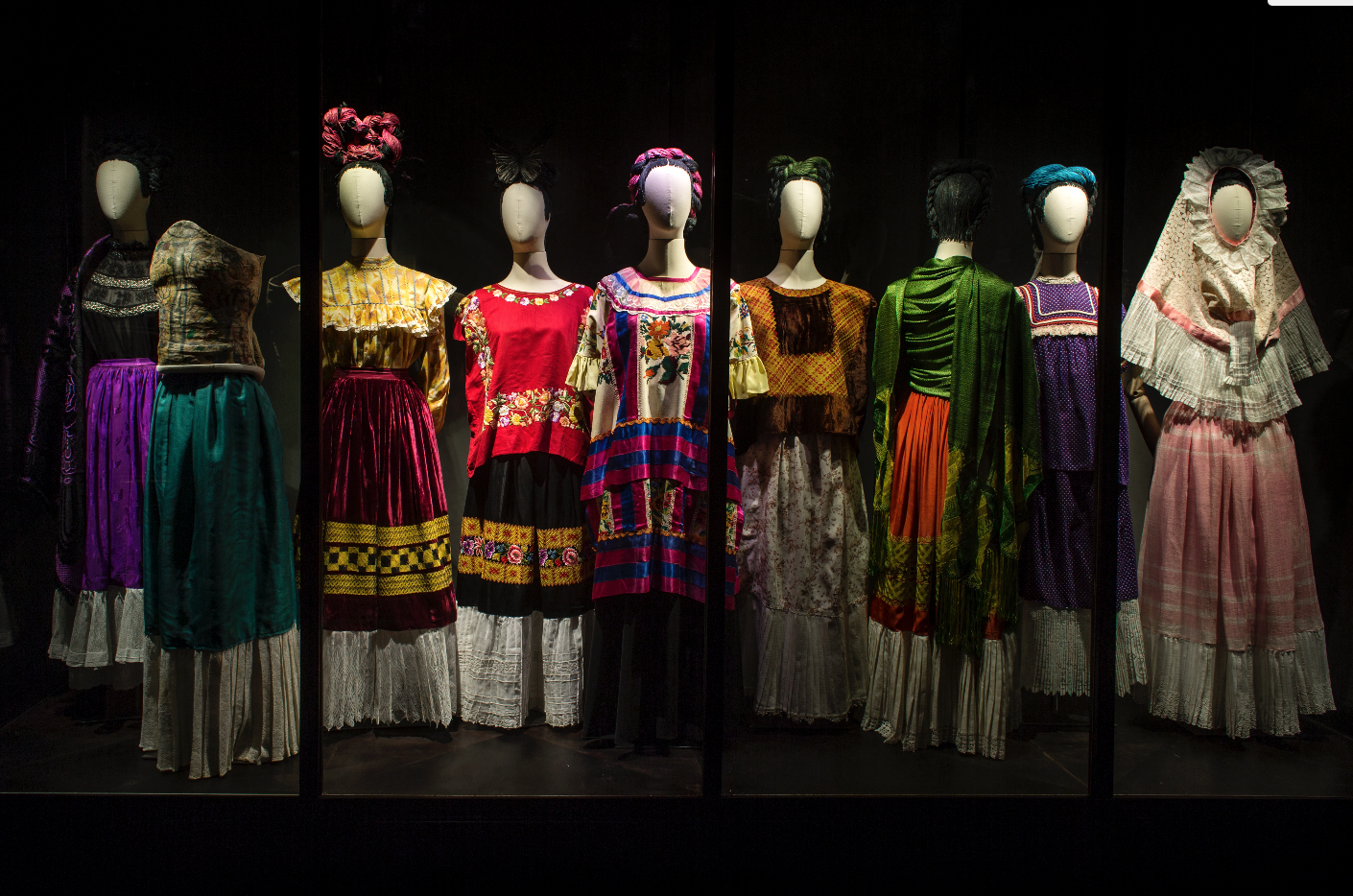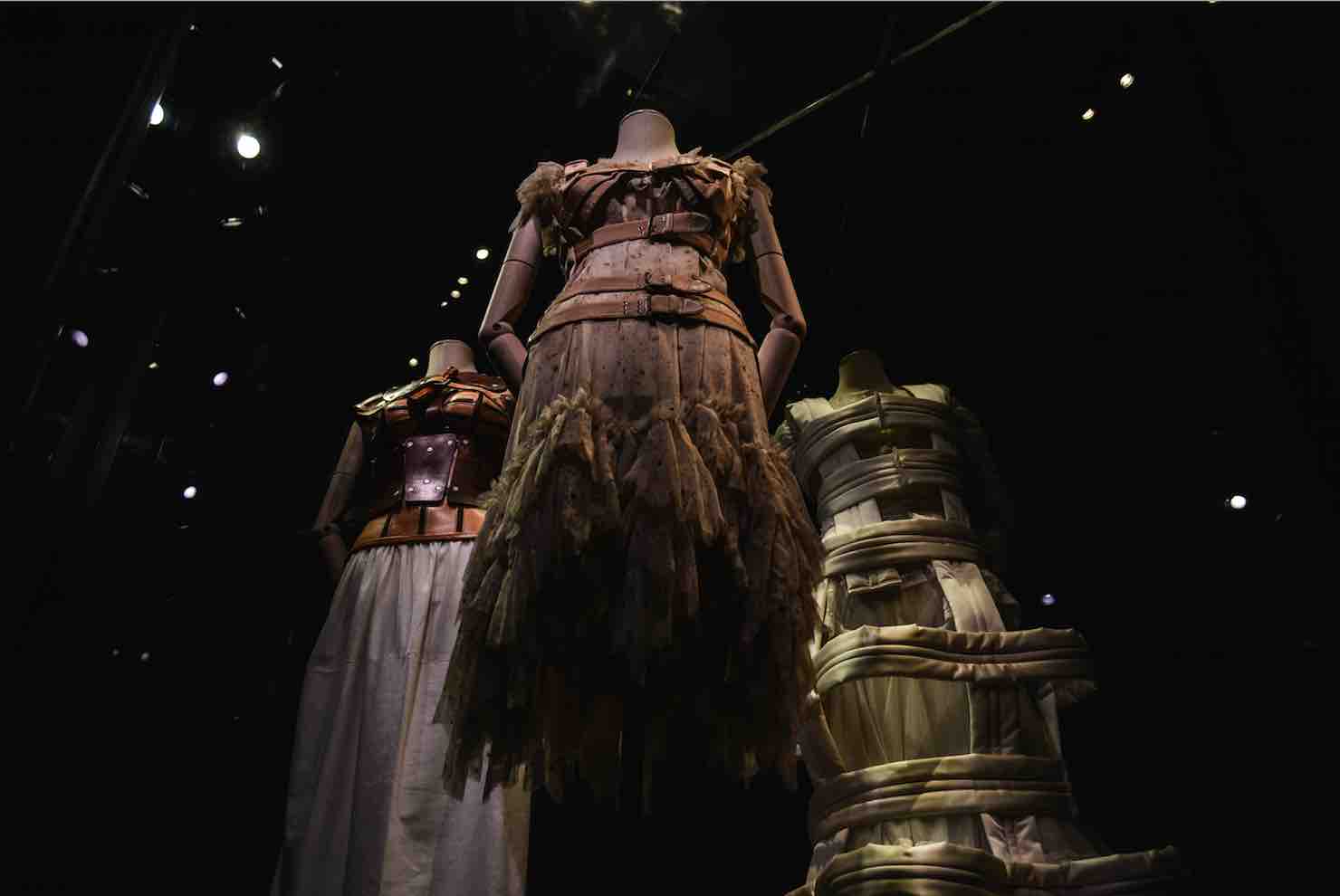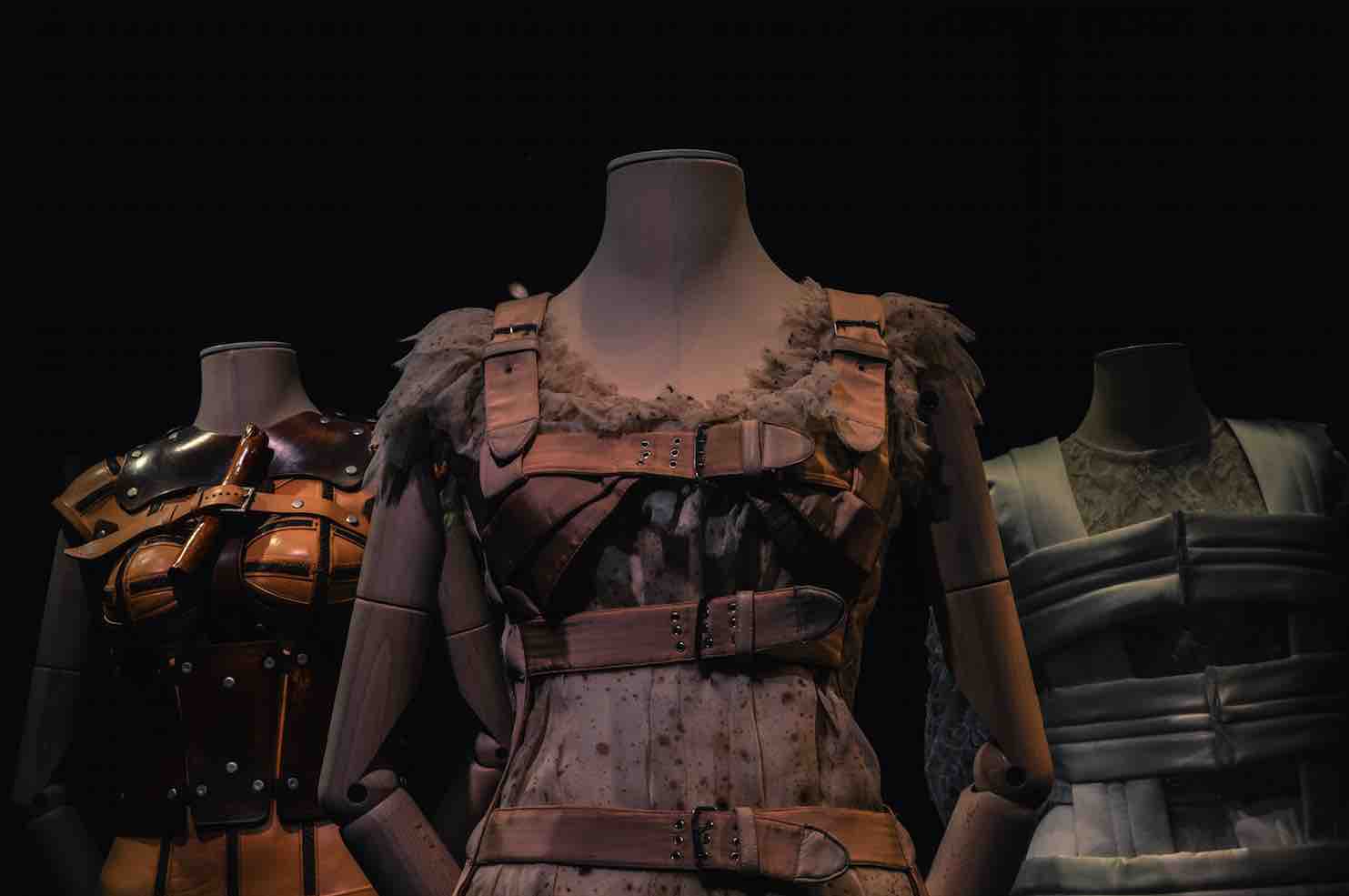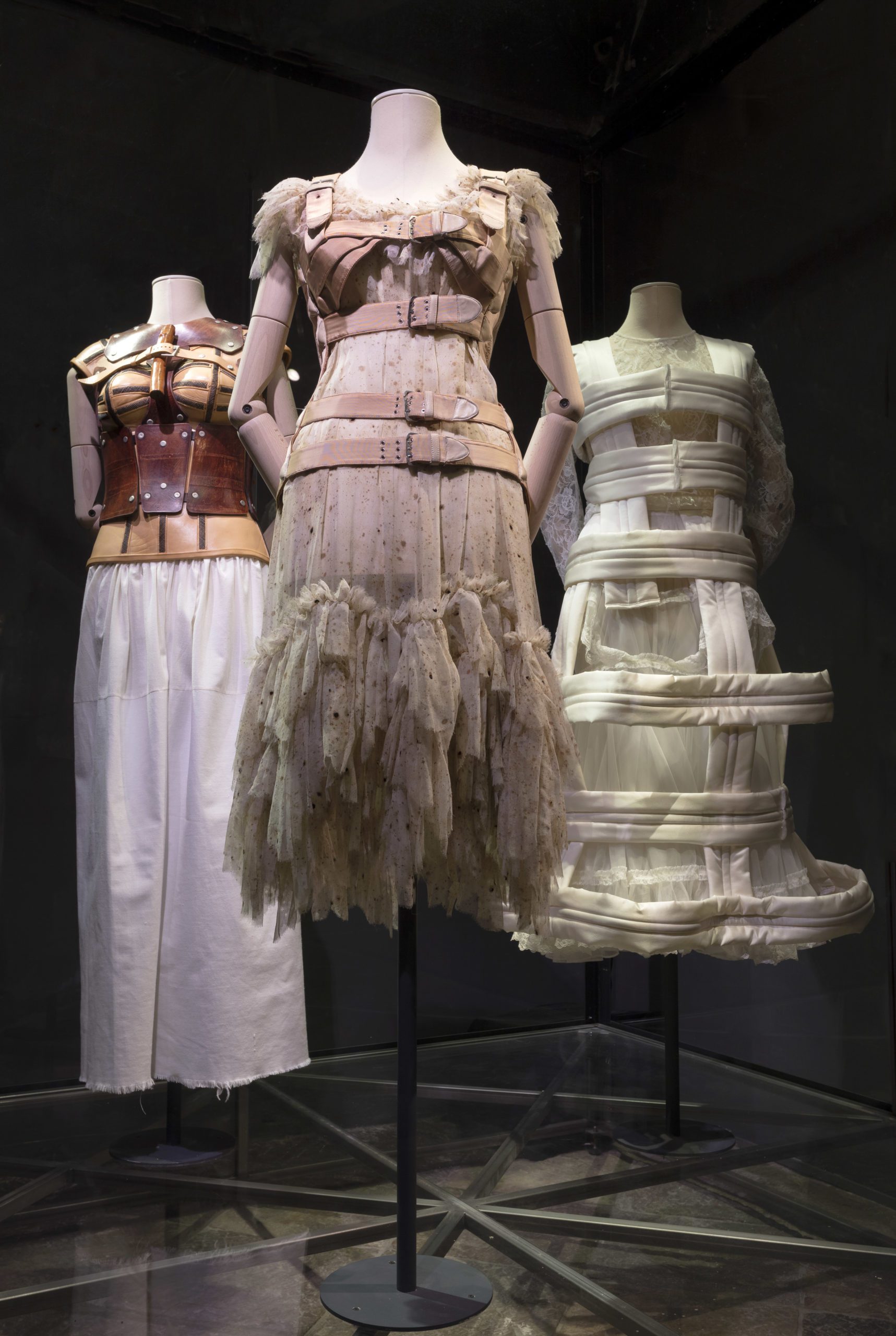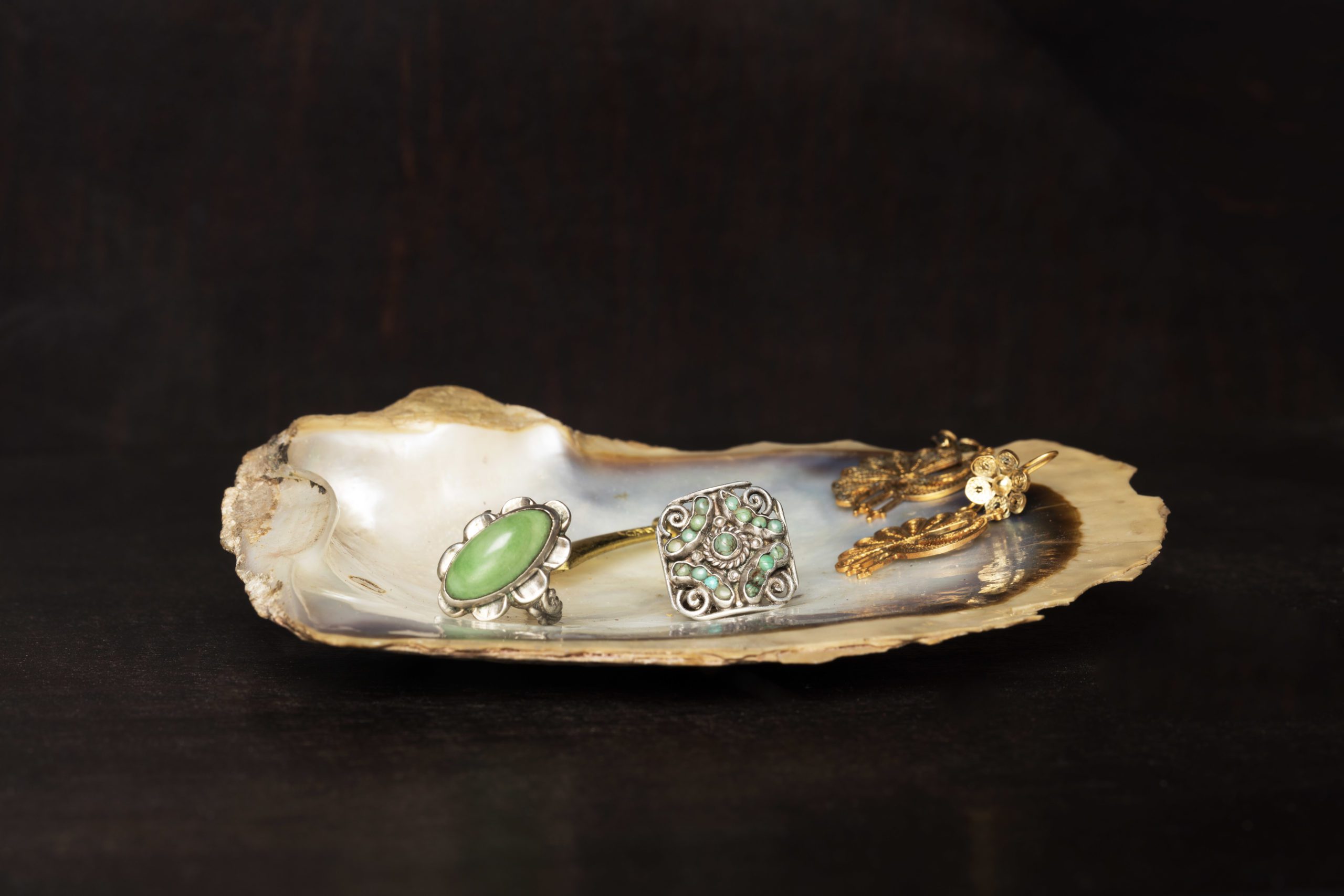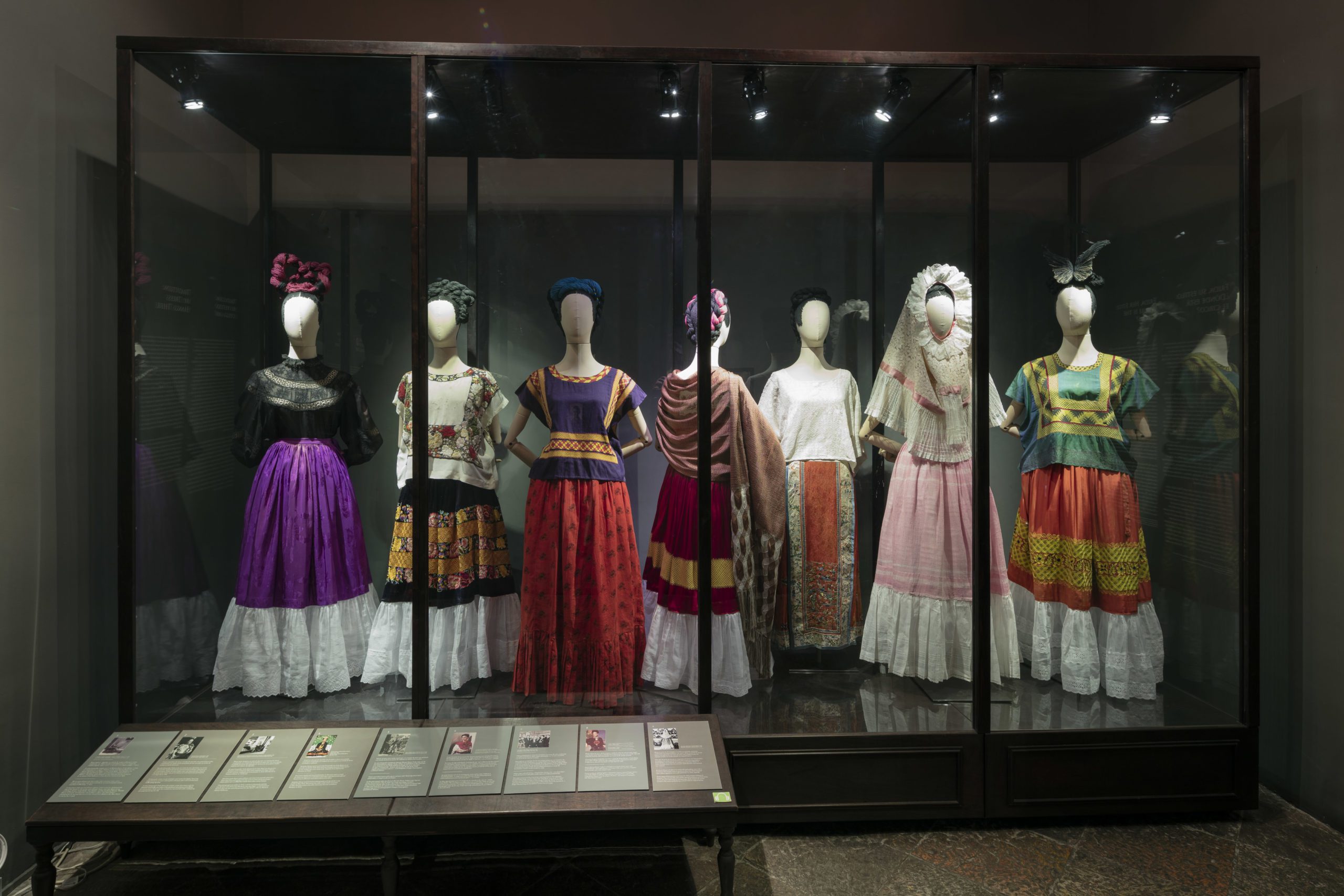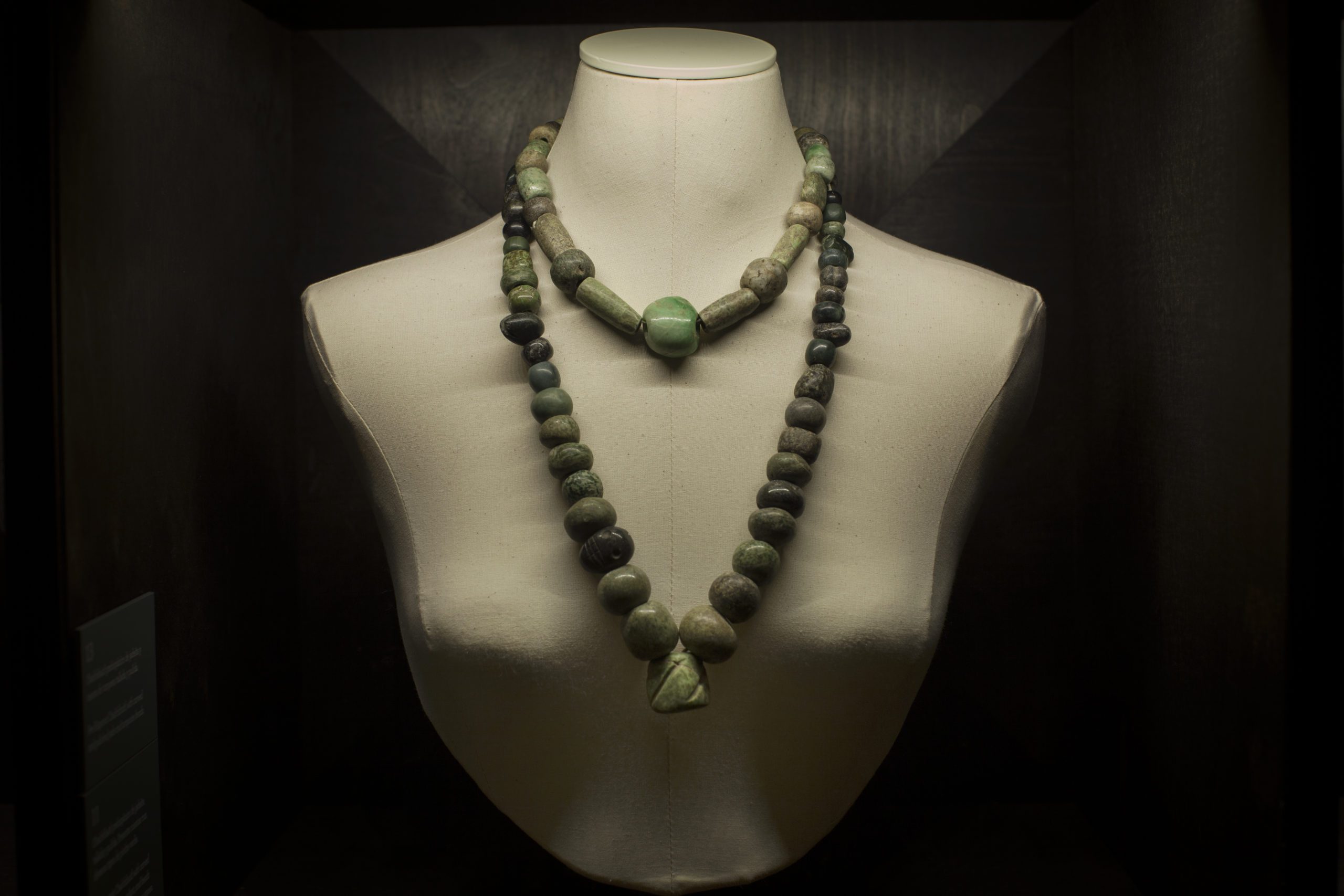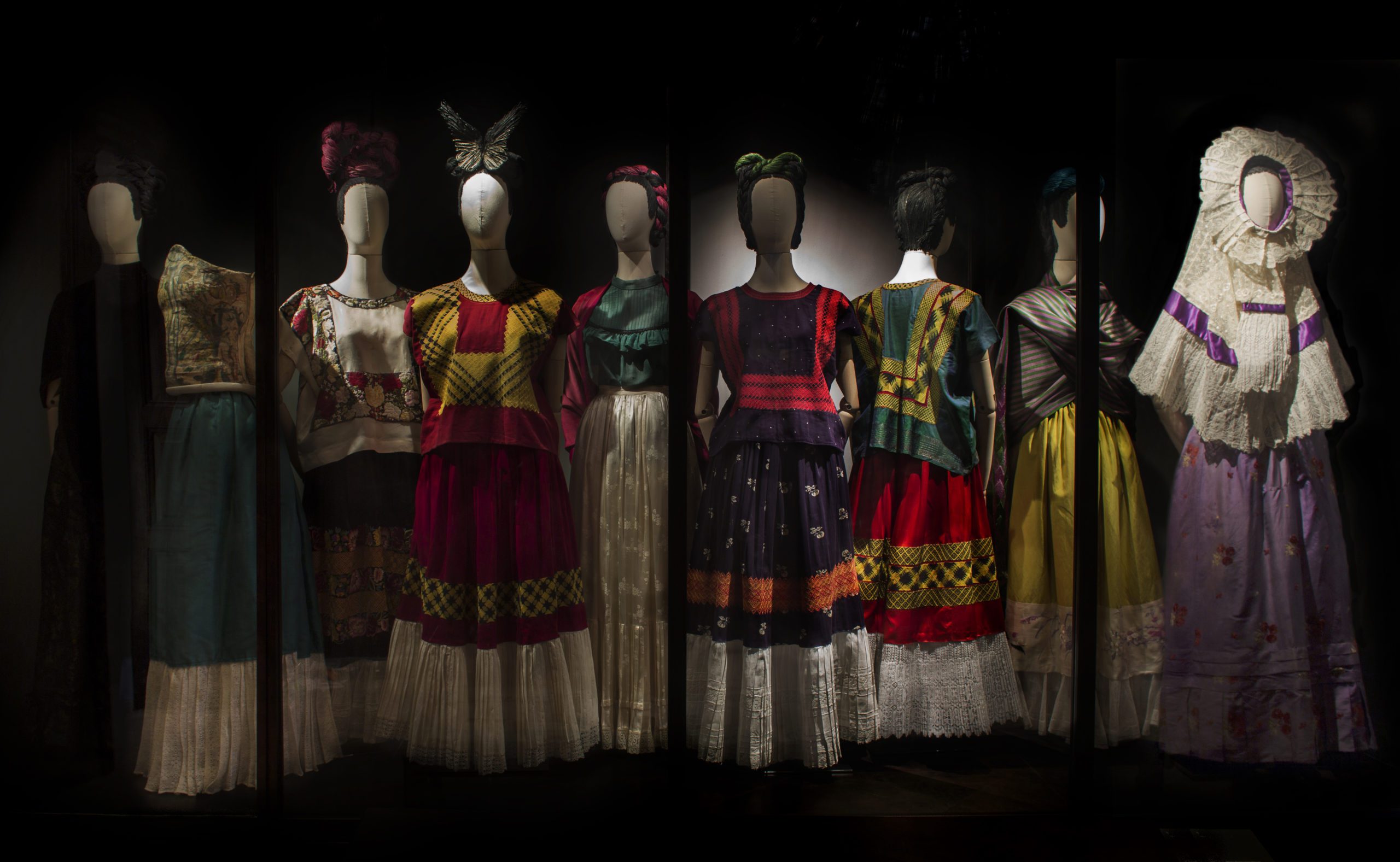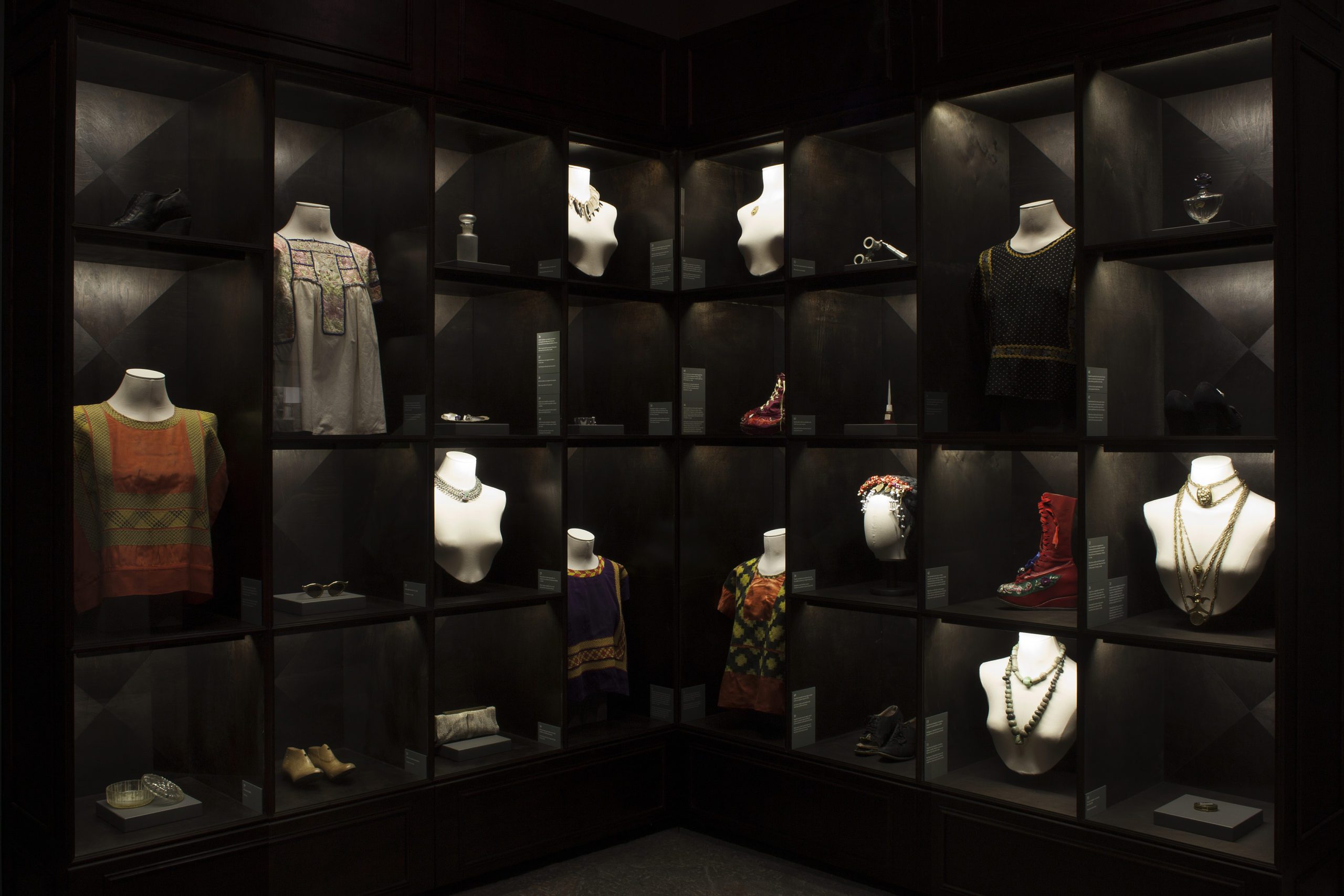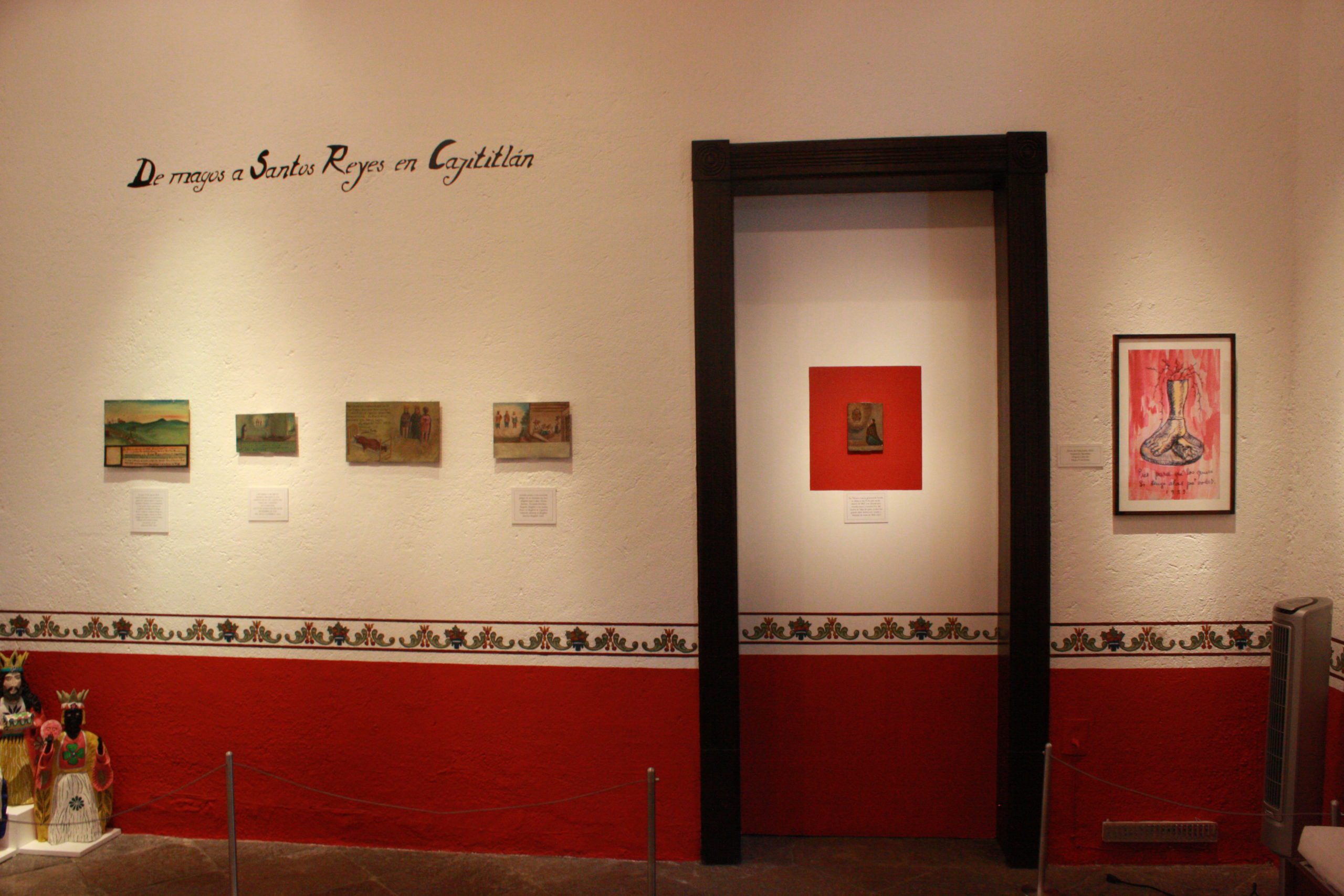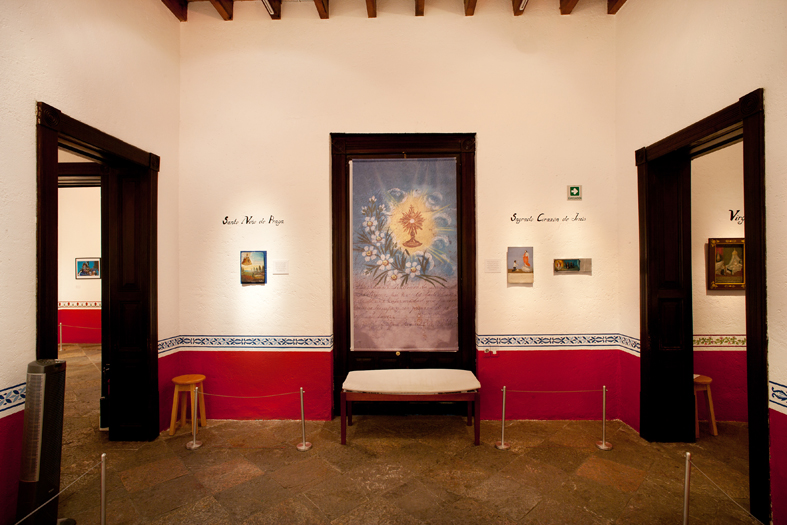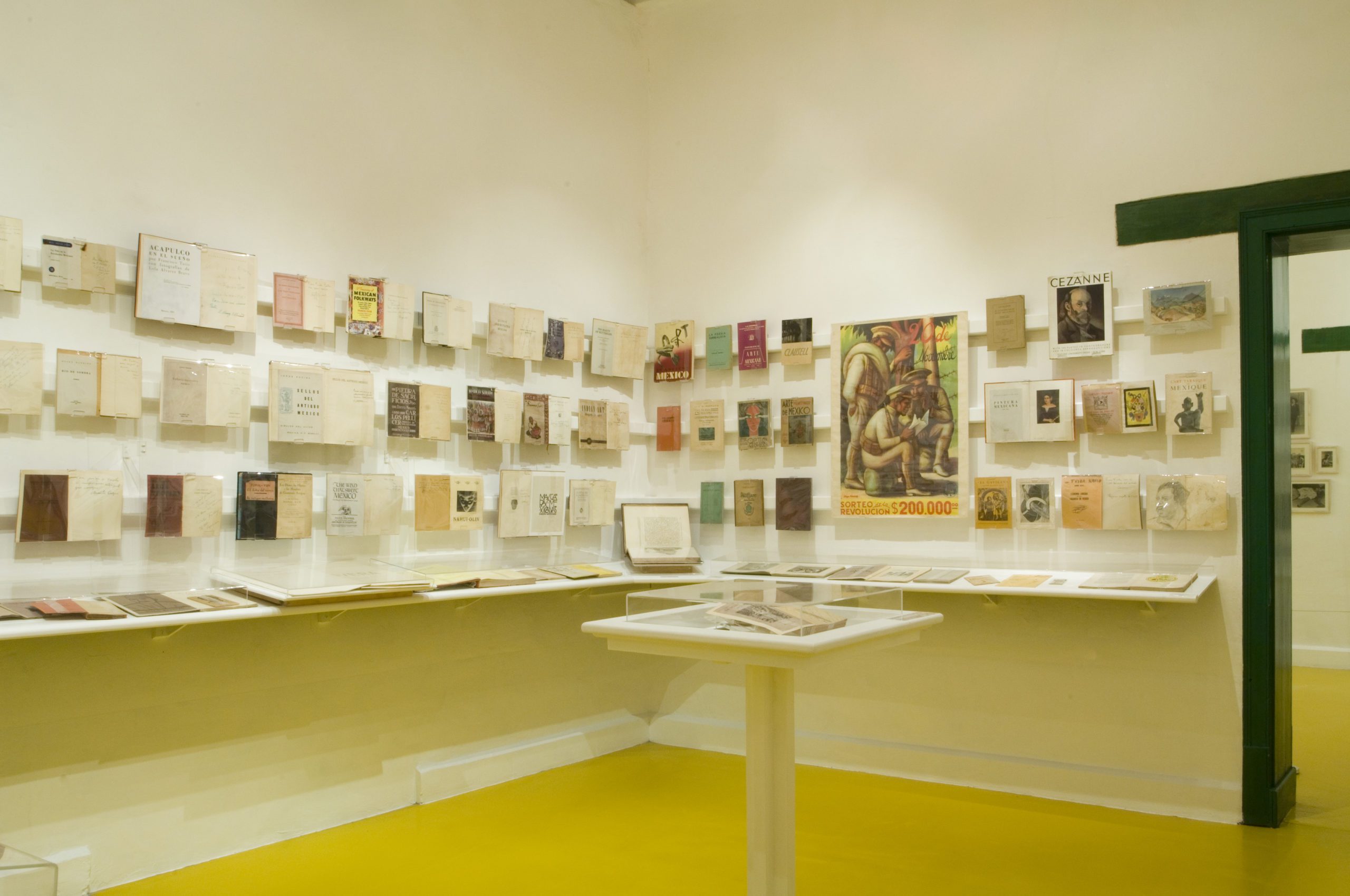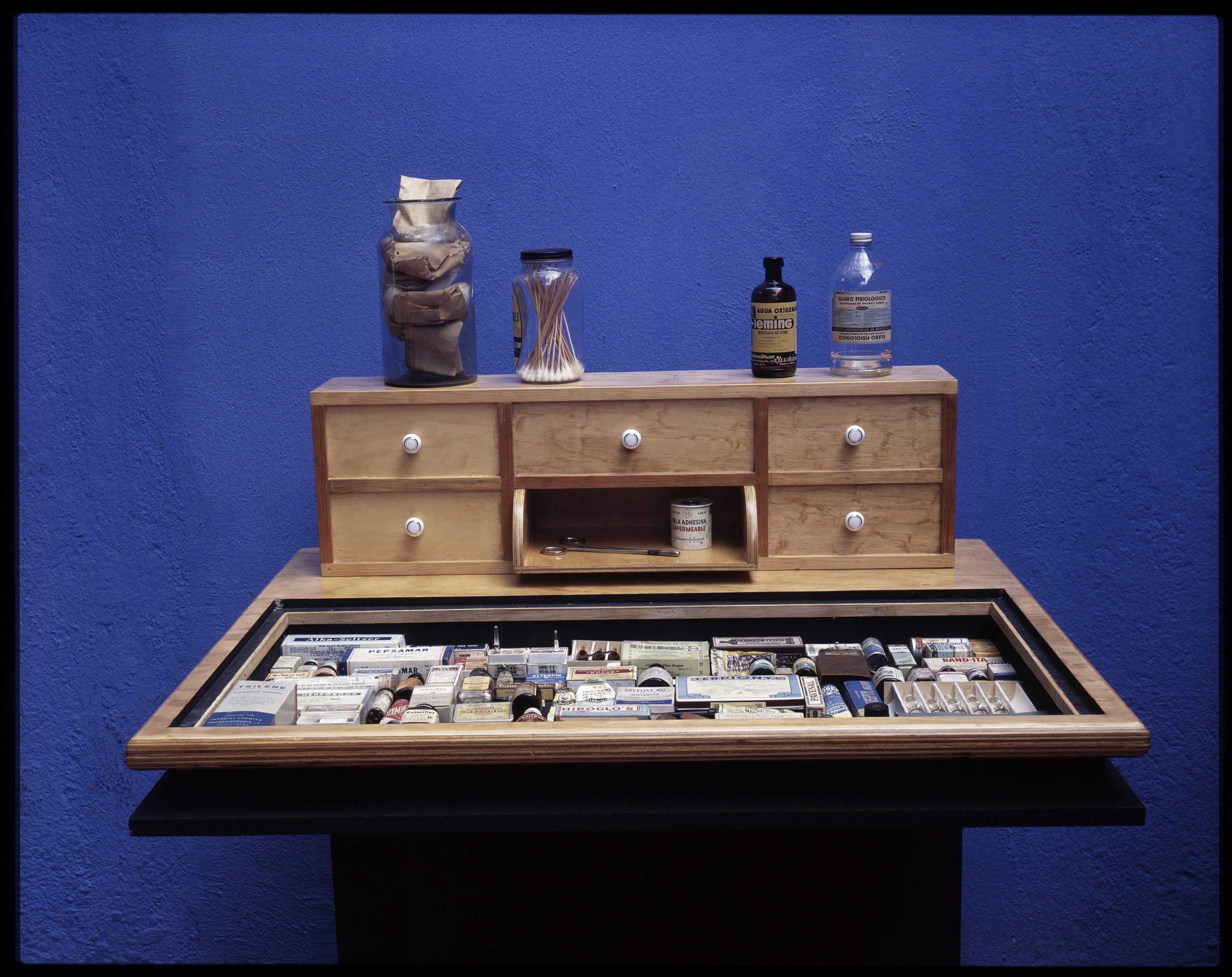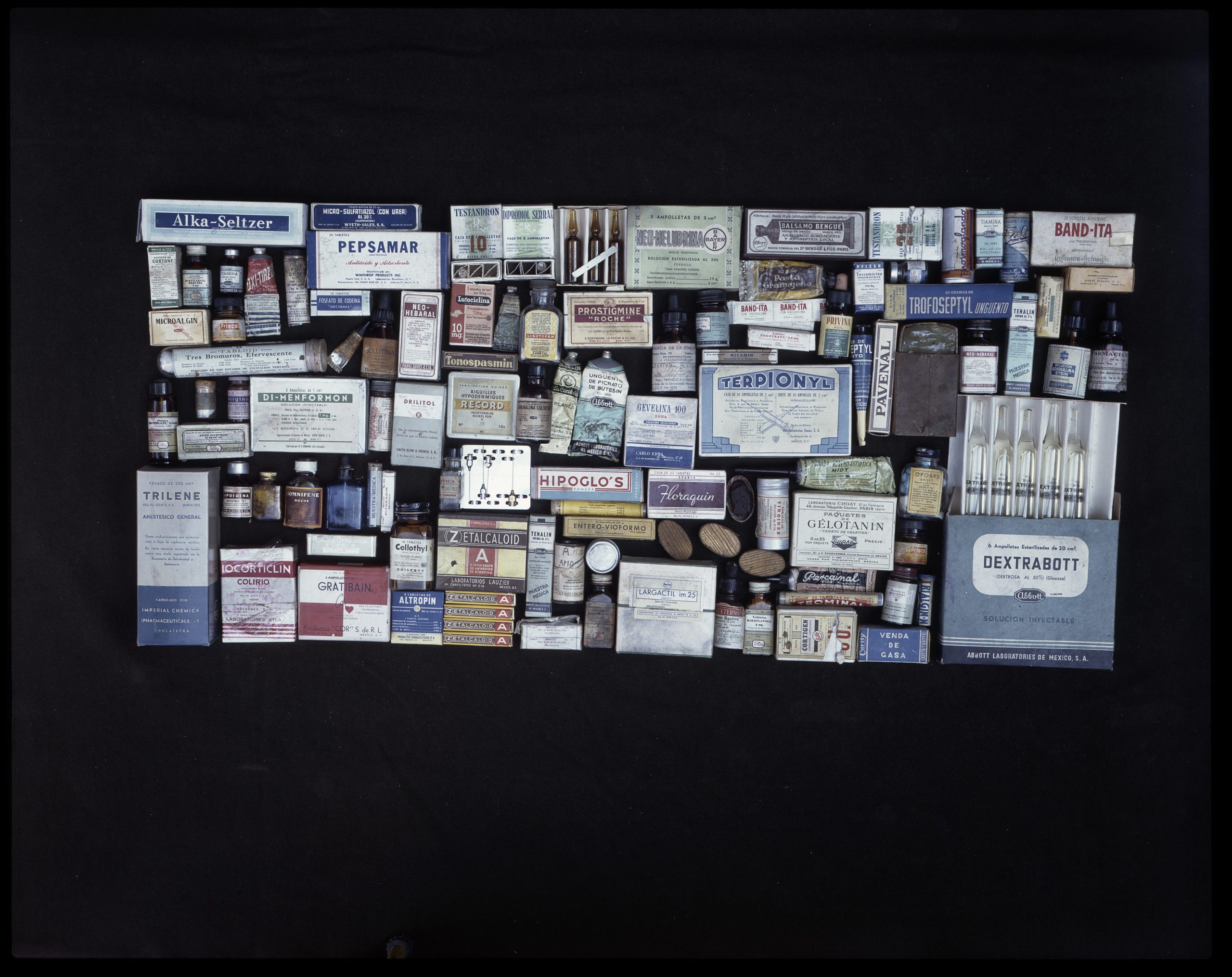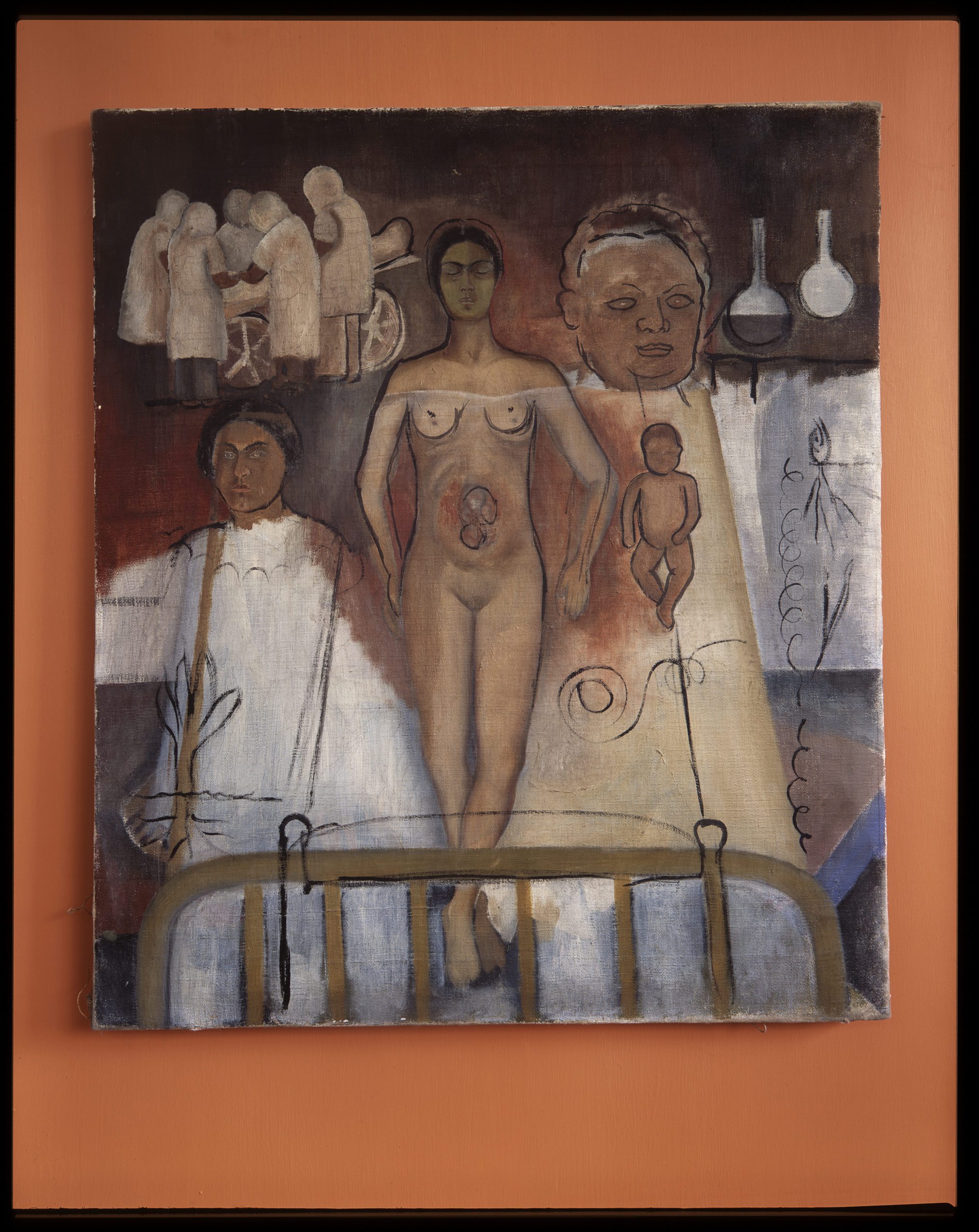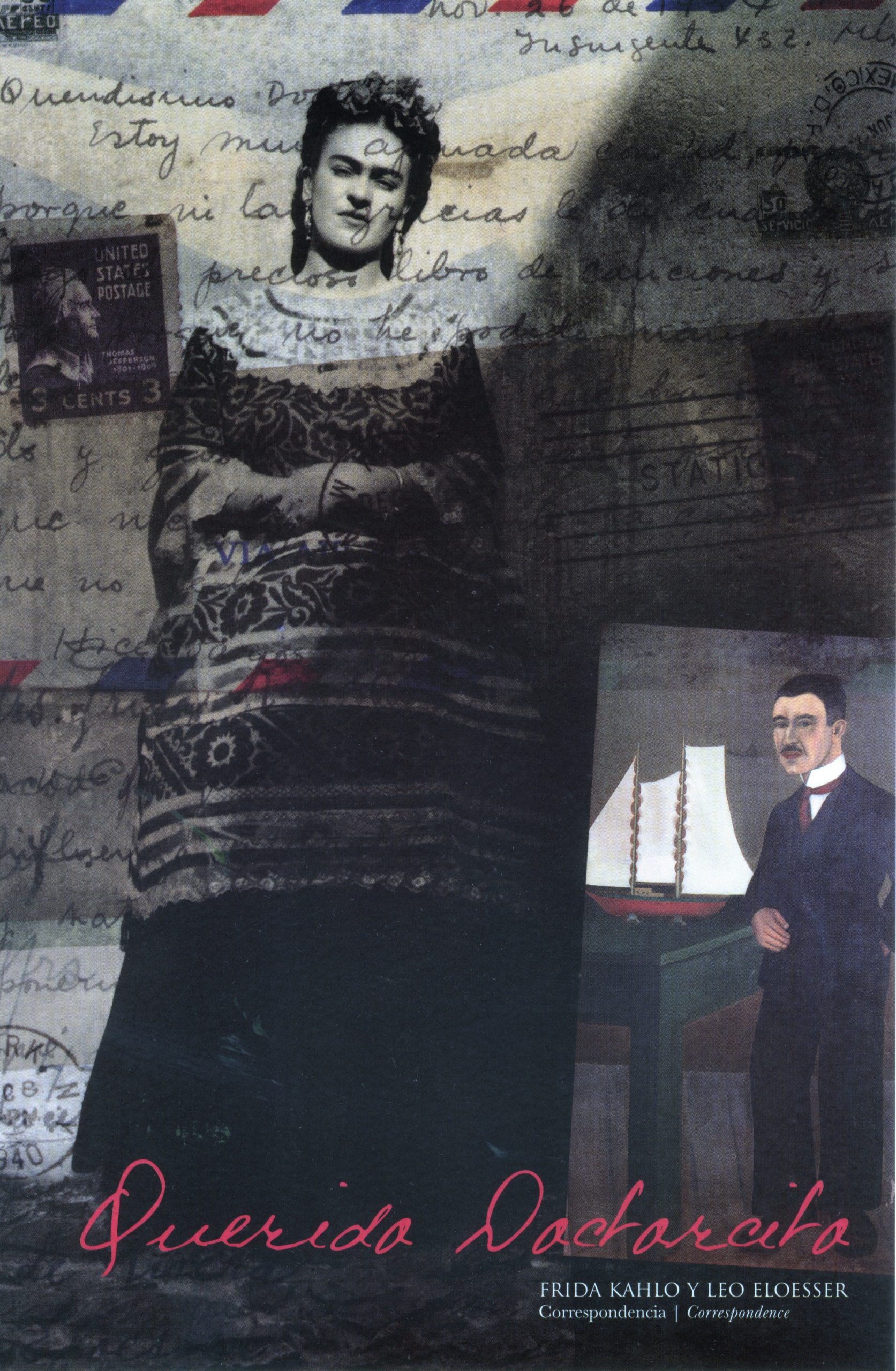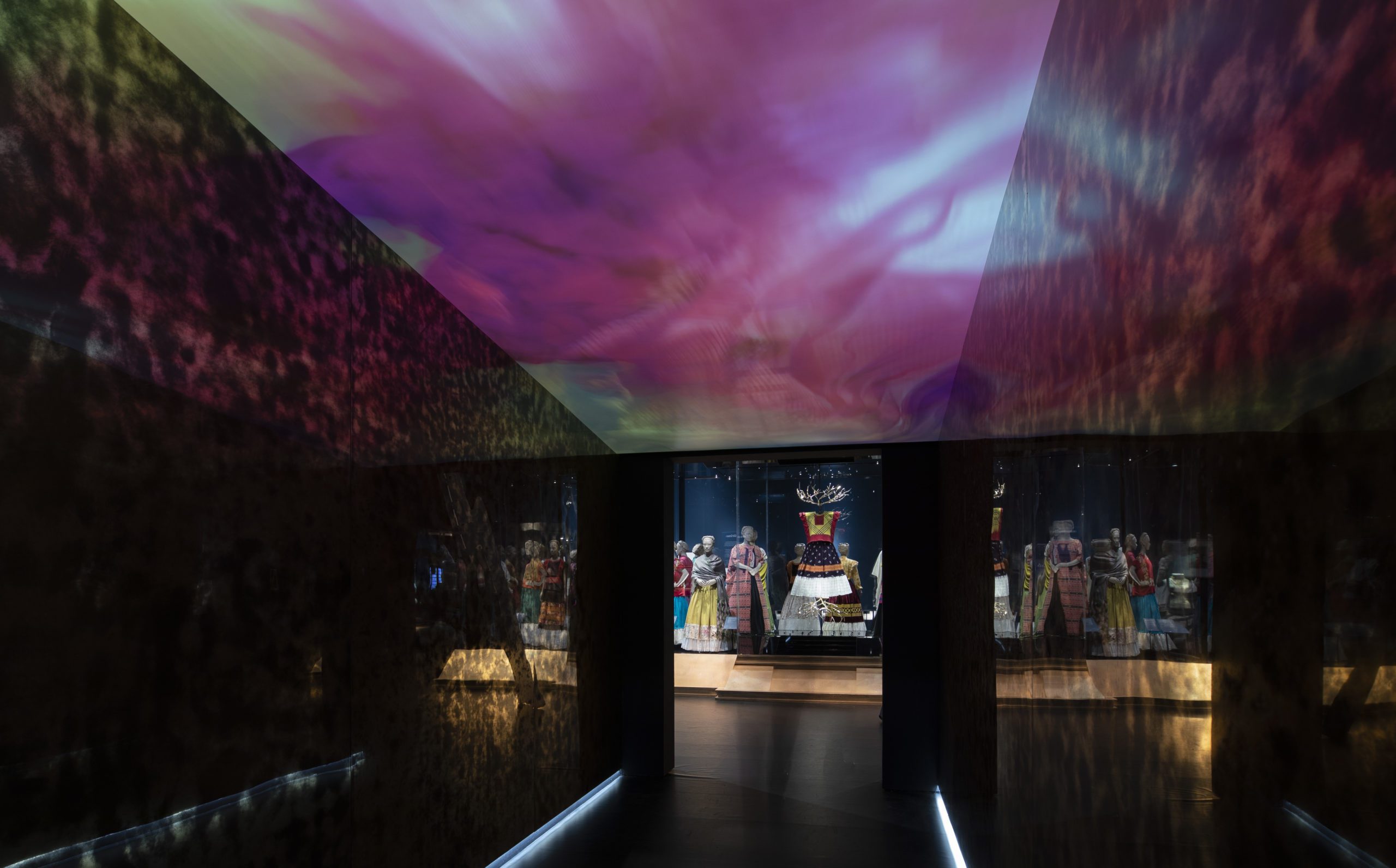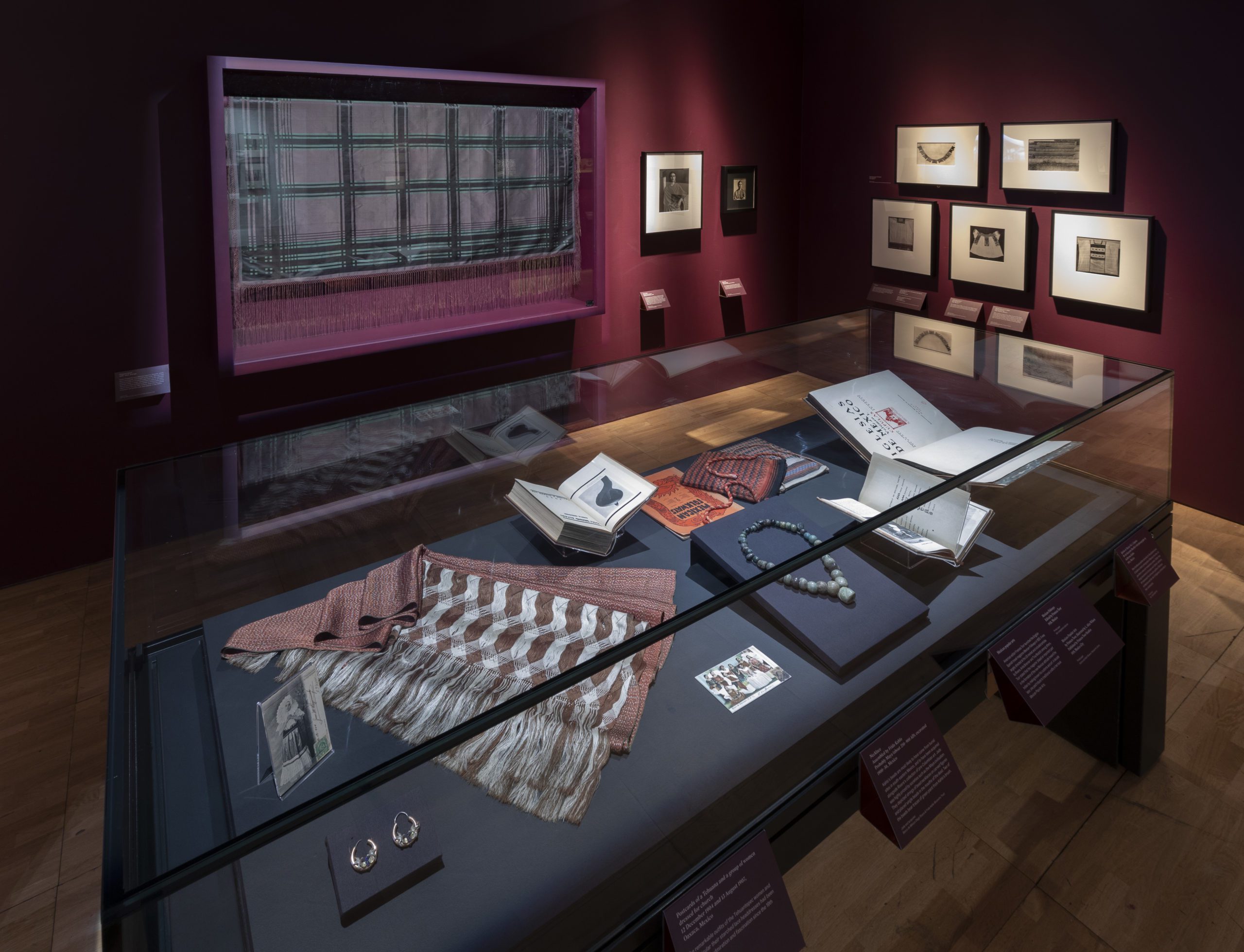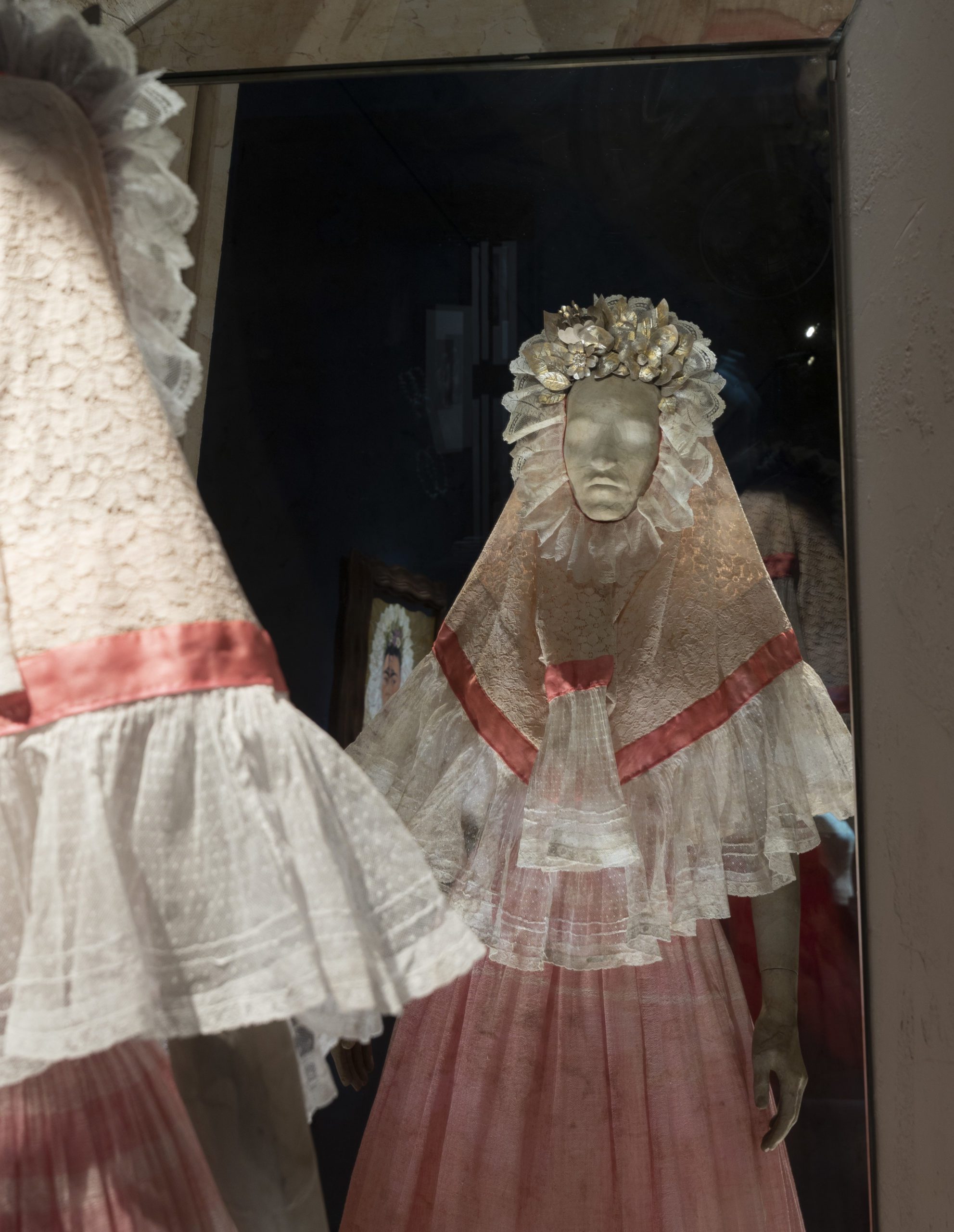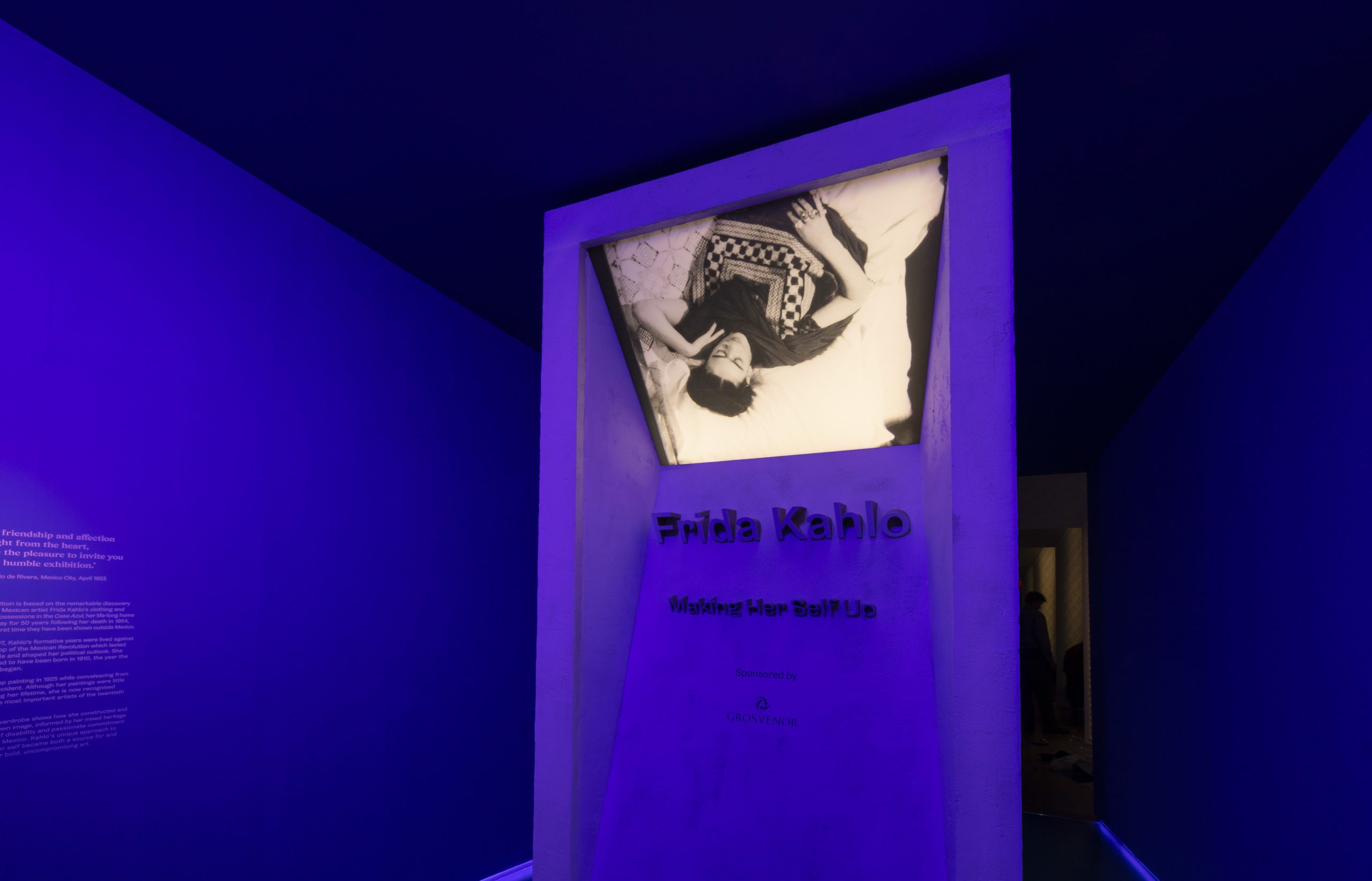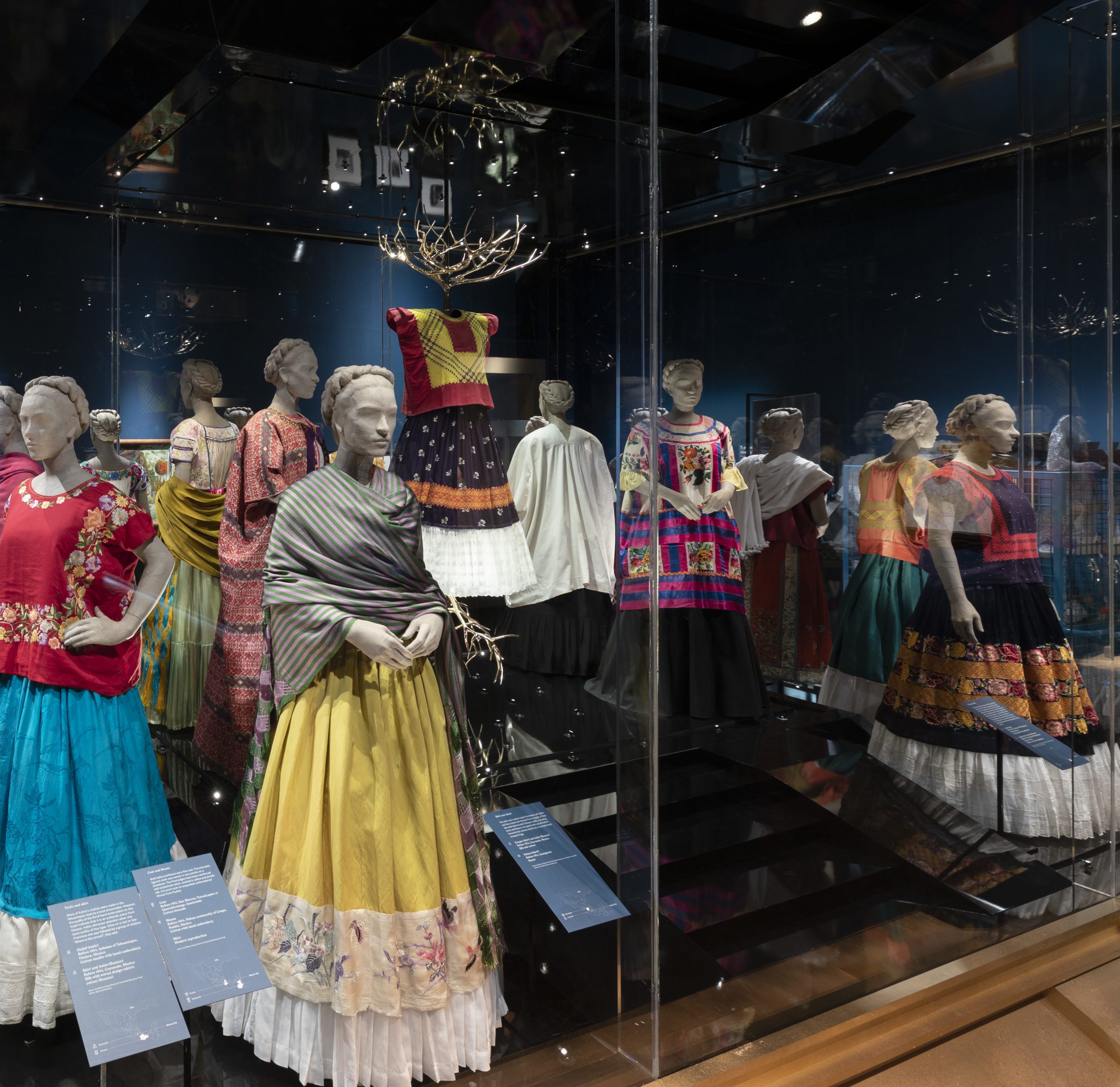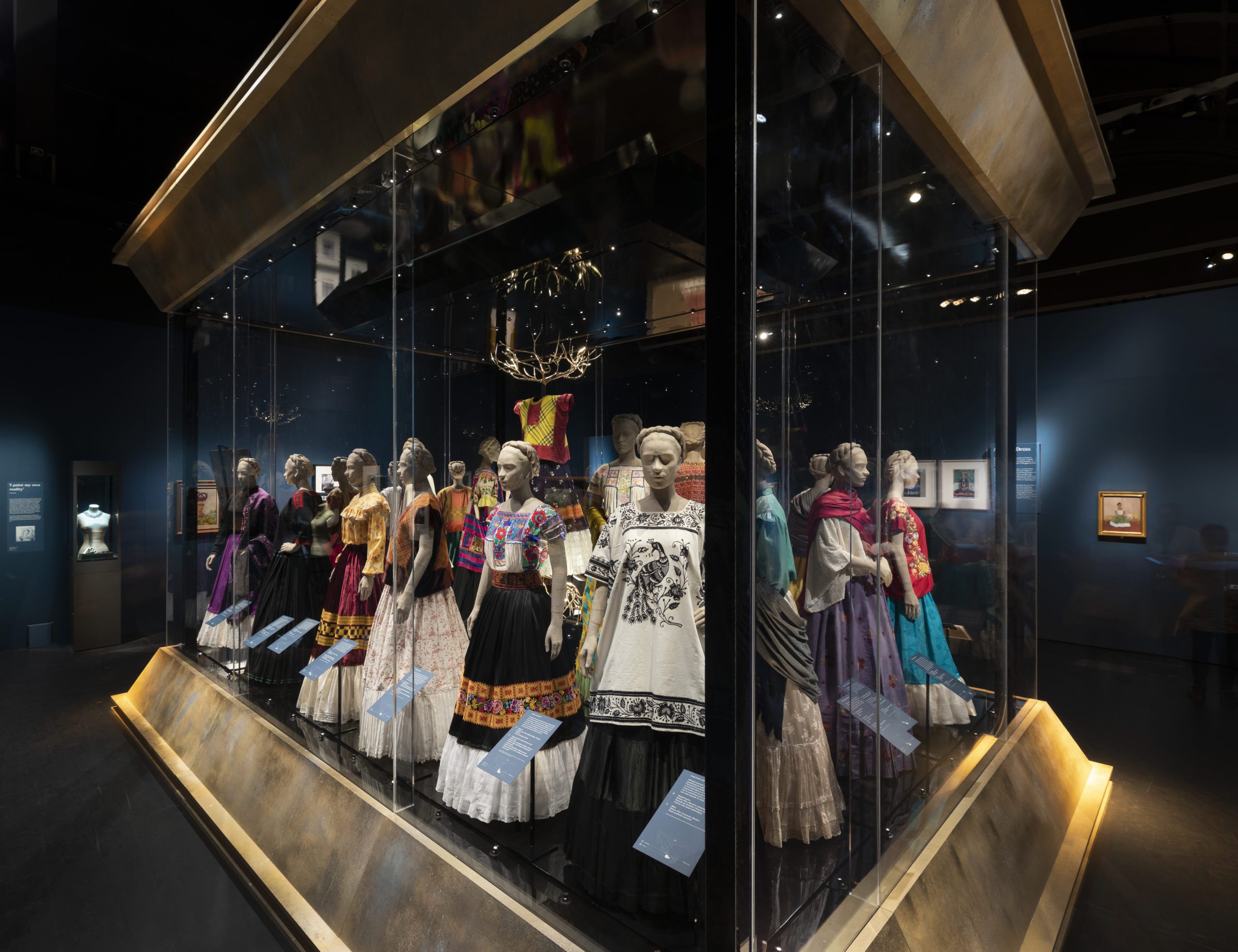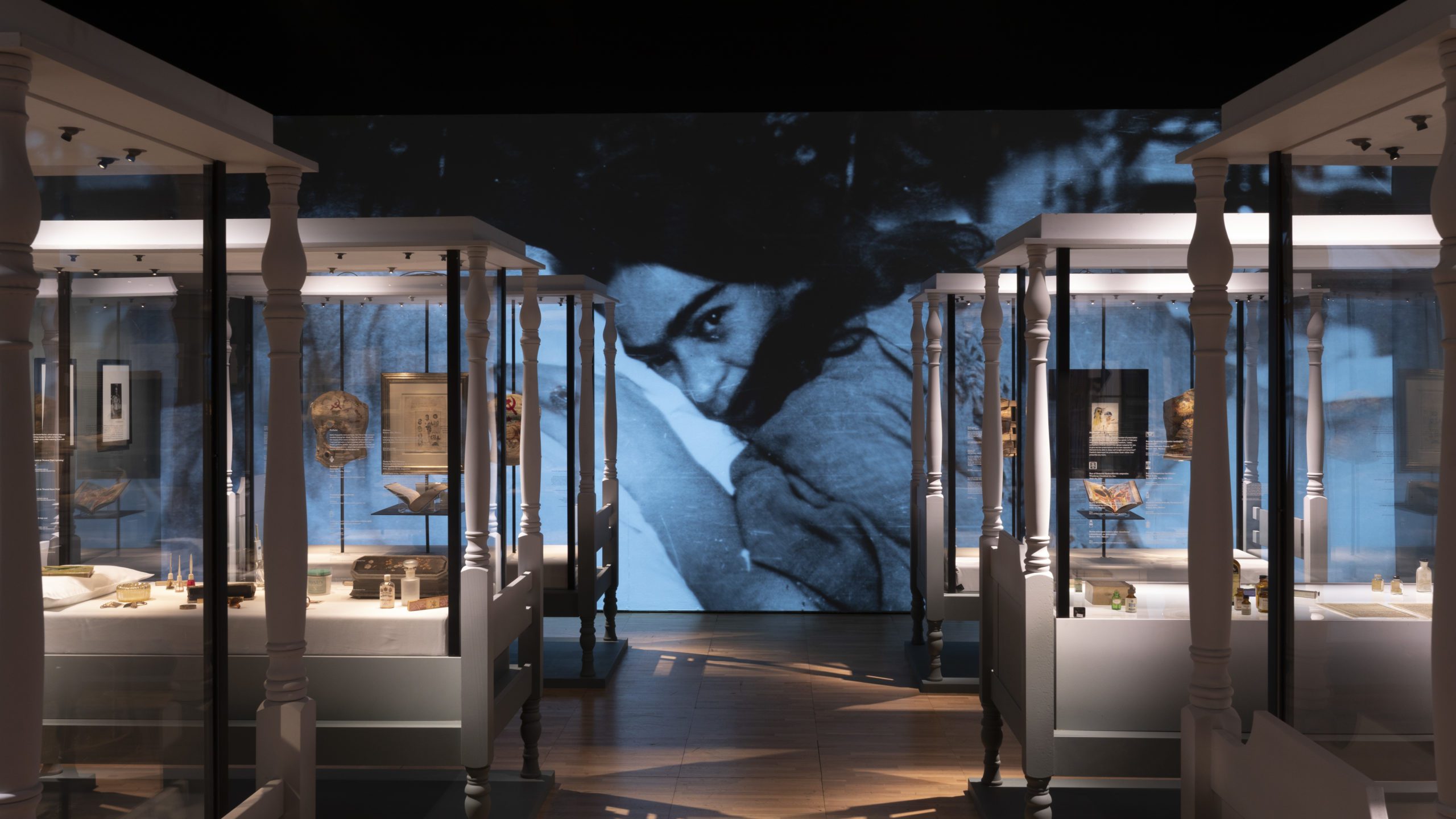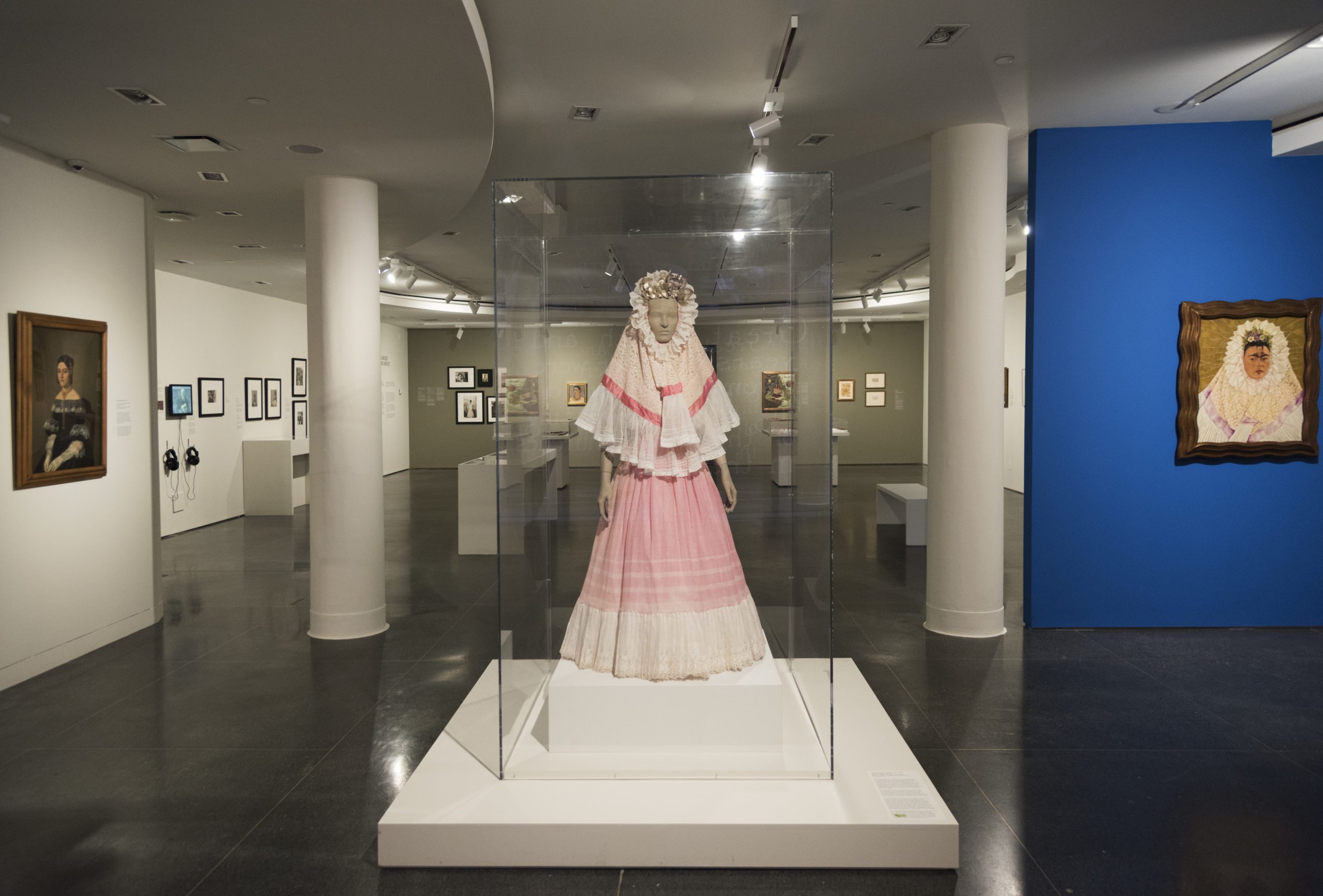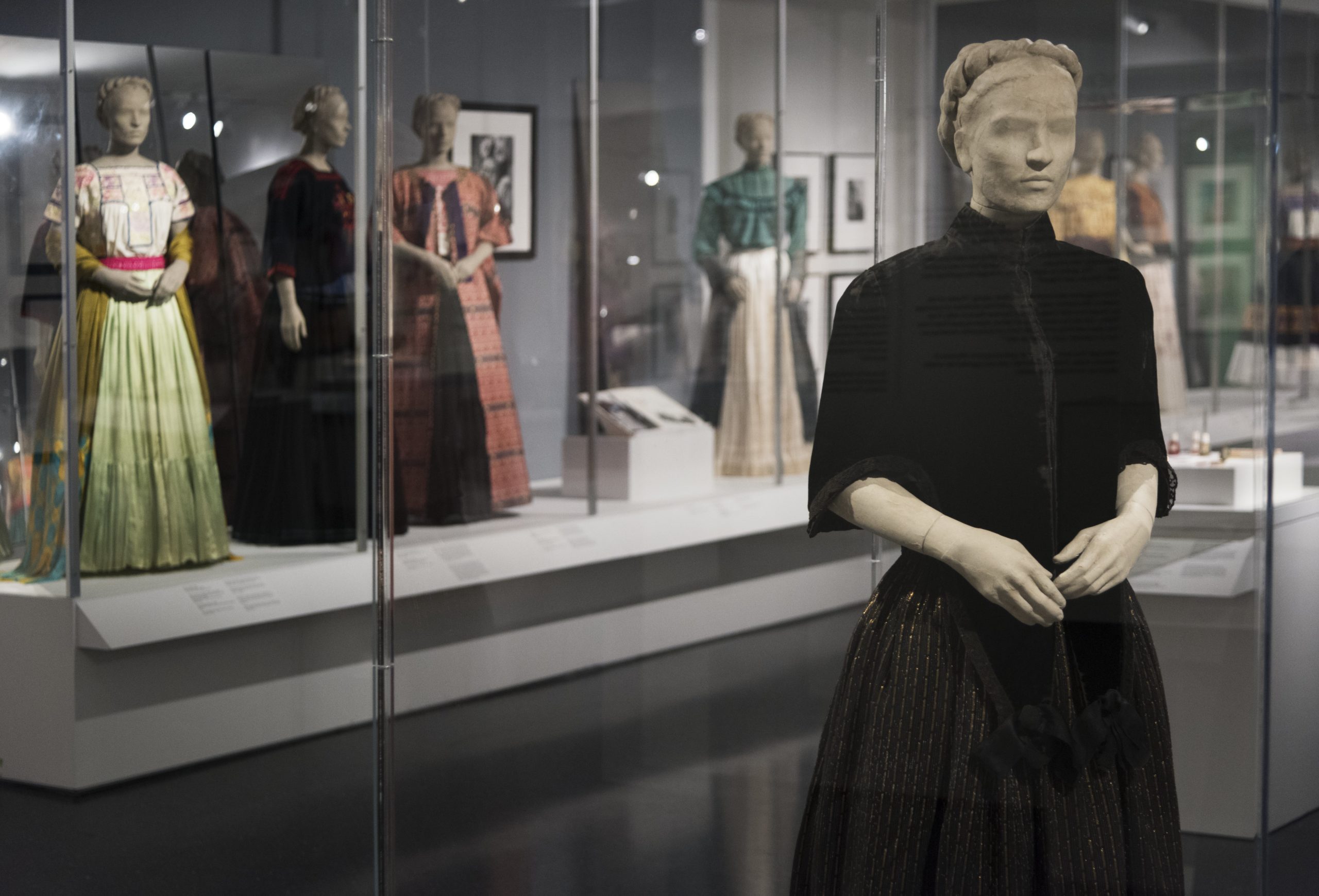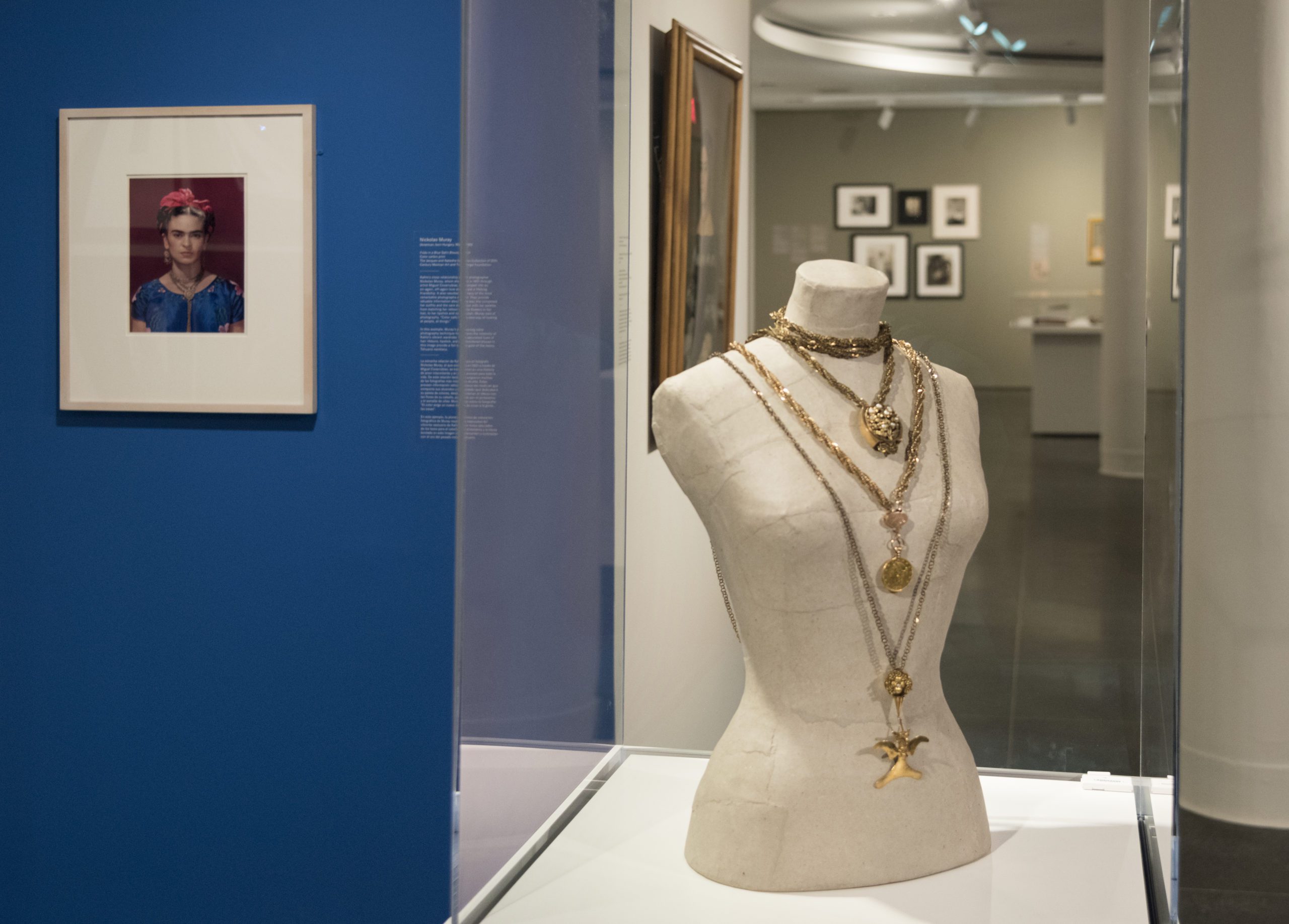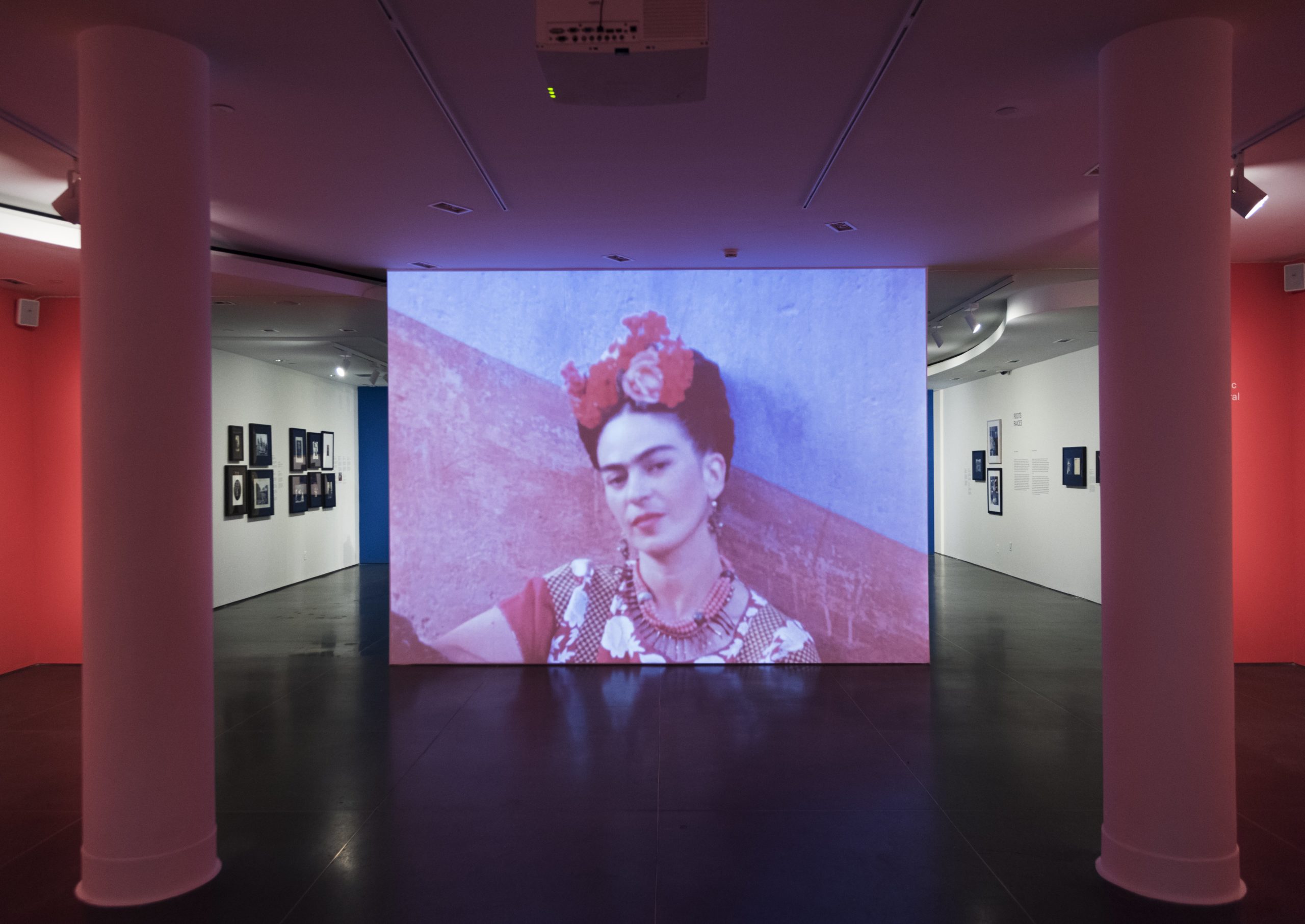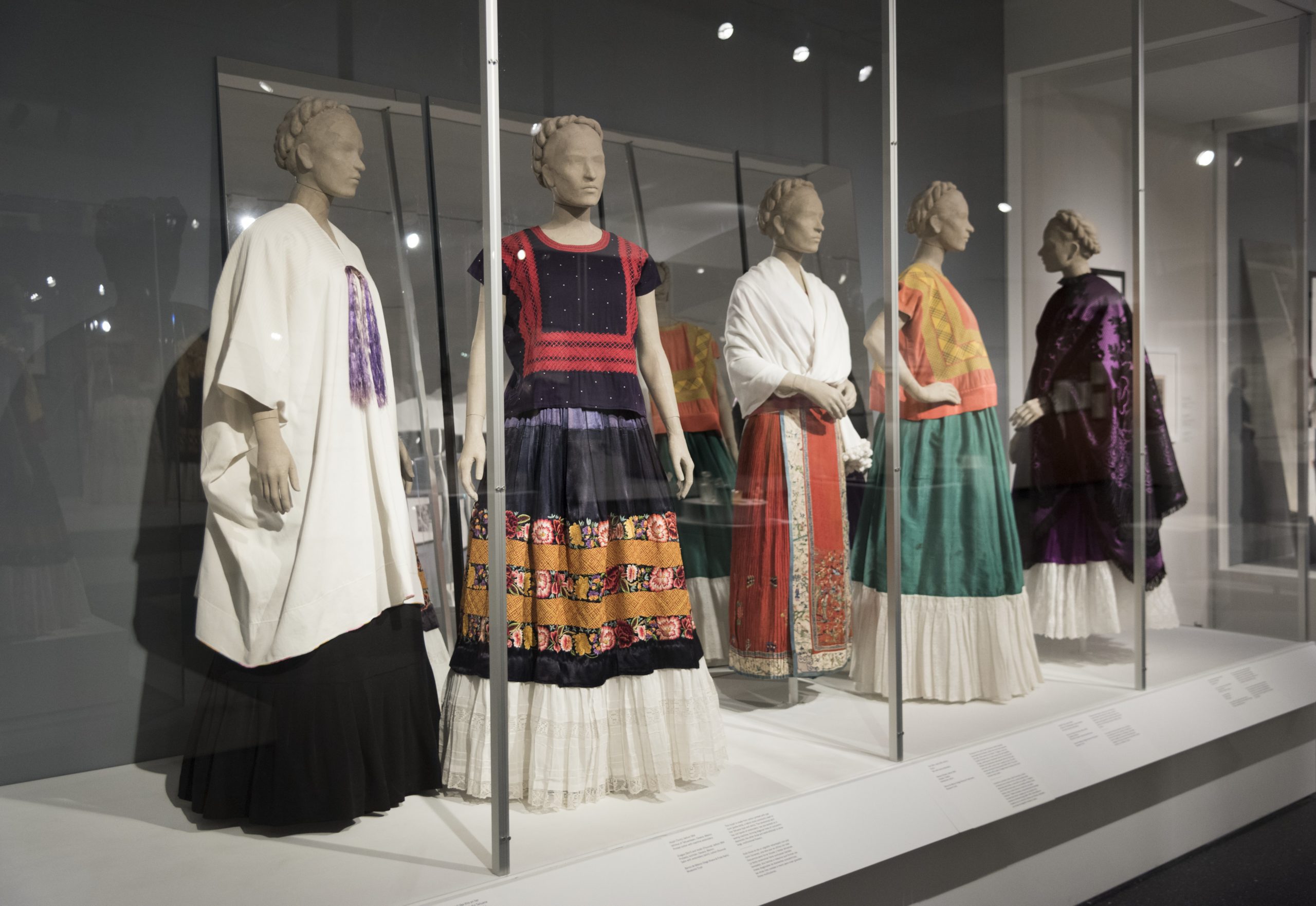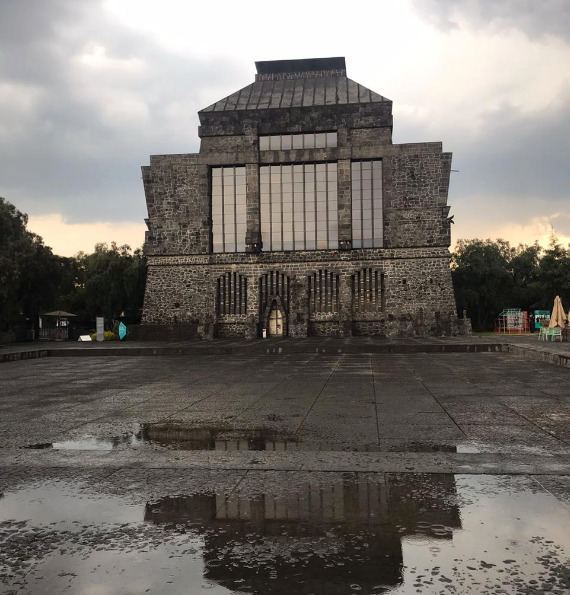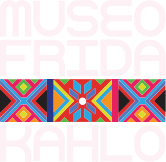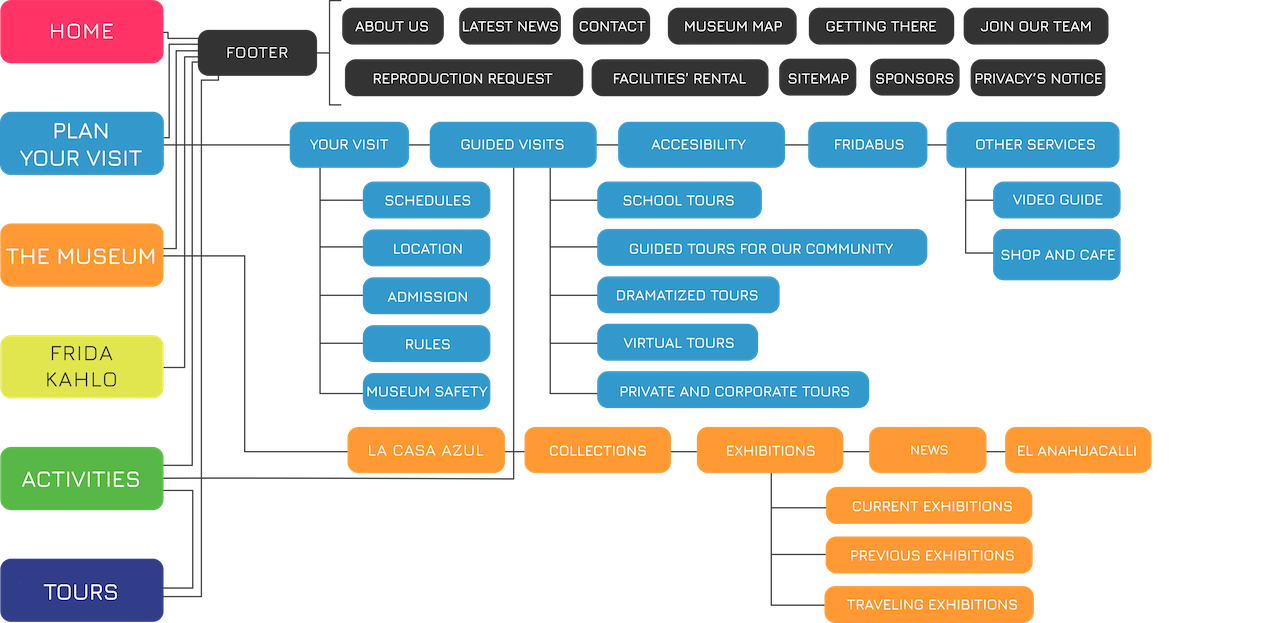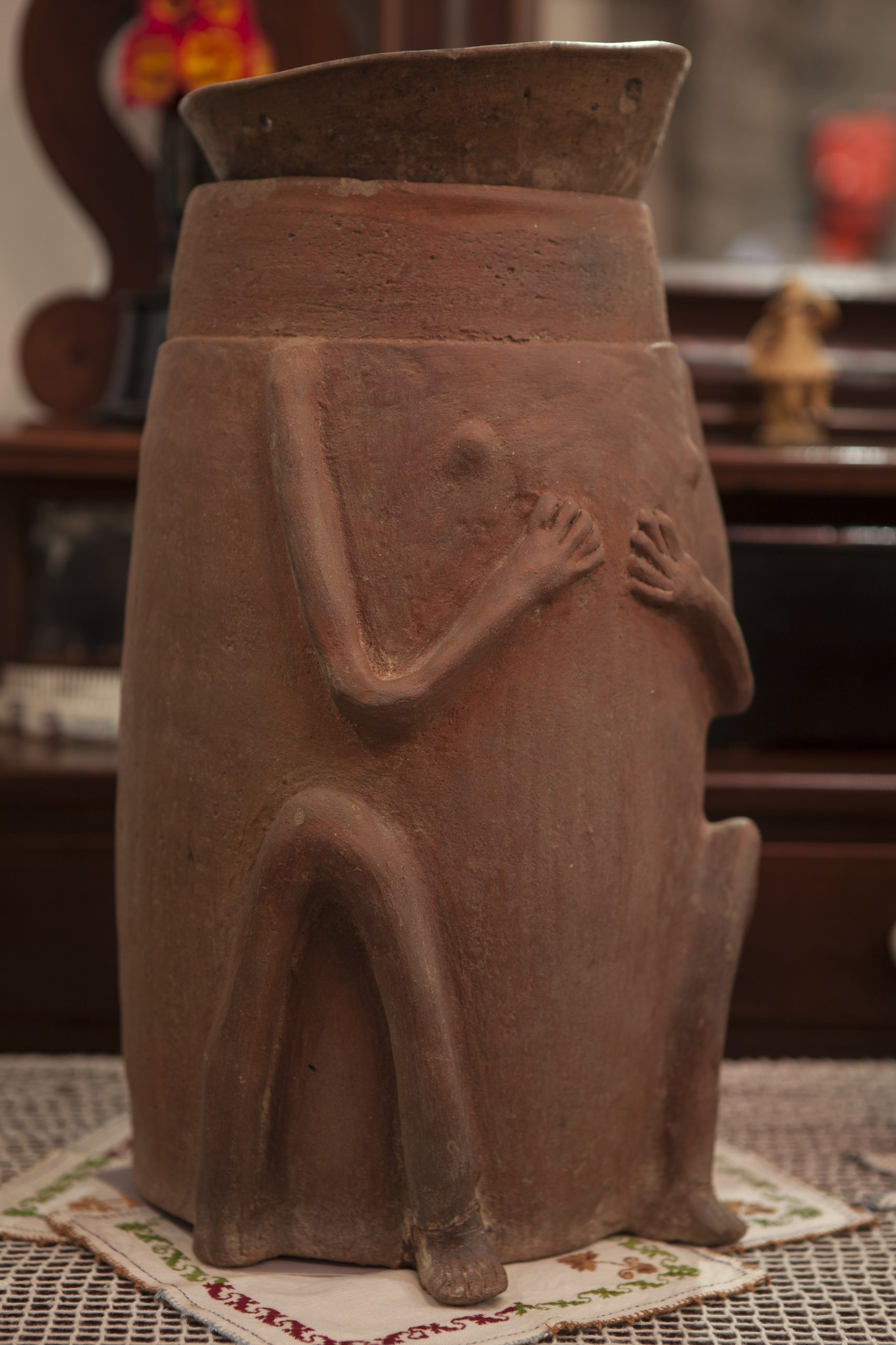
Pre-Hispanic urn containing Frida’s ashes
Frida’s ashes rest in this pre-Hispanic urn. Two years after her death, Diego dedicated one of his works to her with these loving words:
"To the little girl Fridita Kahlo, the wonderful . . . [for] two years she has slept in ashes alive in my heart.”

Long Live Life, (1954), the last canvas Frida was working on before she died.
Frida painted these iconic watermelons around 1950. Years later and a few days before her death, she added the phrase by which she wished to be remembered: Long Live Life.
© D.R. Banco de México, fiduciario en el Fideicomiso Museos Diego Rivera y Frida Kahlo
© D.R. Banco de México, Fiduciario en el Fideicomiso relativo a los Museos Diego Rivera y Frida Kahlo

Self-Portrait (with Velvet Suit), (1926), Frida’s first self-portrait
Frida dedicated this first self-portrait to her boyfriend Alejandro Gómez Arias. Before giving it to him, she took this photo that she colored to look the same as the painted version. With this photographic image, Frida recorded the start of her career as an artist.
© D.R. Banco de México, fiduciario en el Fideicomiso Museos Diego Rivera y Frida Kahlo
© D.R. Banco de México, fiduciario en el Fideicomiso Museos Diego Rivera y Frida Kahlo

Still Life (1942), work and frame full of symbolism
Early in the 1940s, the president of Mexico at that time commissioned Frida to paint a still life. The artist had a frame made that represents a womb. The canvas was deemed too suggestive by the First Lady, so the work was returned to the Casa Azul.
© D.R. Banco de México, fiduciario en el Fideicomiso Museos Diego Rivera y Frida Kahlo

Portrait of My Father, Guillermo Kahlo (1952), a work that Frida did based on a photo of her father as a young man
Frida’s father suffered from epilepsy. At that time, this nervous system disorder was a real disability. With Guillermo as her role model, Frida learned to cope with the hardship of physical difficulties. Years after her father’s death, the artist dedicated this portrait to him in tribute.
© D.R. Banco de México, fiduciario en el Fideicomiso Museos Diego Rivera y Frida Kahlo

My Family (unfinished) (1949), work that illustrates Frida’s German and indigenous heritage
In this portrait, Frida recreates her family tree and conveys her pride in the diversity of her ethnic origin. Love for Mexico is one of the artist’s distinctive features, expressed in both her physical appearance and her work.
© D.R. Banco de México, fiduciario en el Fideicomiso Museos Diego Rivera y Frida Kahlo

Frida Kahlo’s diary (1944–1954), where she wrote statements such as: “The dove erred. It was erring . . . ”
Frida filled her diary with spontaneous thoughts and honest statements such as these, alluding to the amputation of her right foot. In contrast, in her drawing she gives herself wings to fly when she can no longer walk.
© D.R. Banco de México, fiduciario en el Fideicomiso Museos Diego Rivera y Frida Kahlo

Plaster corset on which Frida drew a Greek column to represent her own spinal column
Frida drew a shattered Ionic column on this corset, alluding to her physical frailty. This act reflects how the artist’s creativity, sense of humor, and honesty prevailed throughout her many bouts of convalescence and despite the pain she endured.
© D.R. Banco de México, fiduciario en el Fideicomiso Museos Diego Rivera y Frida Kahlo

Plaster corset, intervened by Frida with mirrors and the Communist Party symbol (ca. 1941)
Not all post-surgery corsets that Frida used have the same shape; this one has an opening in the center, perhaps to allow air flow to reach her skin. Frida incorporated mirrors—elements that she used frequently—as well as the symbol of the hammer and sickle, proclaiming her political affiliation.
© D.R. Banco de México, fiduciario en el Fideicomiso Museos Diego Rivera y Frida Kahlo

Metal prosthesis for her right leg that was intervened by Frida, 1954
Frida used this prosthesis since 1953, when her right leg had to be amputated when gangrene set in. Decorated to her tastes, the prosthesis has a very modern design for the times. Days before the surgery, Frida wrote in her diary:
"Hopefully, once [I’m] walking, I can give it all I’ve got . . . ”

Pink “resplandor,” worn by women in Tehuantepec as a headpiece typical of women’s attire in Oaxaca
This “resplandor” or headdress that Frida wore in portraits and photos is used on special occasions by women in Tehuantepec. This head “huipil,” as it is also known, focuses attention on the face of Tehuana women and is one of the most distinctive accessories of attire on the isthmus.

Cotton huipil (tunic) with machine-embroidered chain-stitch; stamped cotton skirt, with embroidery and flounce
The wide, square, loose cut of this blouse from Oaxaca—known as a
huipil—allowed Frida to wear her often intervened orthopedic corsets to support her back beneath them, giving her a degree of comfort.

Machine-embroidered velvet huipil with chain stitch; cotton skirt with stamped floral pattern and flounce
At the age of six, Frida came down with polio. As a result, her right leg was thinner and shorter. Long skirts of traditional Mexican clothing allowed her to hide asymmetries in her body. However, Frida understood the power of clothing, beyond covering physical imperfections.

Cotton coat from Guatemala; Mazatec huipil and long, plain skirt
Frida developed a preference for traditional attire, not only of Mexican inspiration, but also from diverse sources, as in this Guatemalan coat. This multicolored garment framed her entire body, projecting a strong presence and a more robust look.

Pair of black shoes, the right shoe intervened after the amputation of several phalanges from the toes of that foot
Frida suffered persistent weakness in her right foot, first from her childhood bout with polio, aggravated at the age of eighteen by the accident she was in that led to eleven fractures. Four years before her death in 1950, doctors had to amputate several toes from her right foot. Her intervened shoe attests to this.

Plaited gold necklace, probably designed by Frida from separate pieces
This solid gold necklace is composed of pendants from different origins. Frida combined them into a single piece because her creativity spilled over into everything she touched, from clothing to jewelry. So, Frida often created new accessories using different pieces that she received as gifts.

Rings made from different materials
Frida’s style also extended to her hands. In several photos, she appears wearing multiple rings and bright red nail polish.

Pre-Hispanic necklaces, masterpieces of Pre-Columbian fine metalwork
This necklace from Frida’s wardrobe is made of jade, an ornamental stone of particular significance for Mesoamerican cultures. Diego gave her these pre-Hispanic beads because they both admired the skill of Pre-Columbian metalsmiths and artists.

Silver bracelet with inlaid stone
Heavy bracelets gave Frida’s delicate, slender frame the impression of greater physicality, which underscored her personality. In this way, the artist drew the observer’s attention to the areas of her body that she wished to highlight.
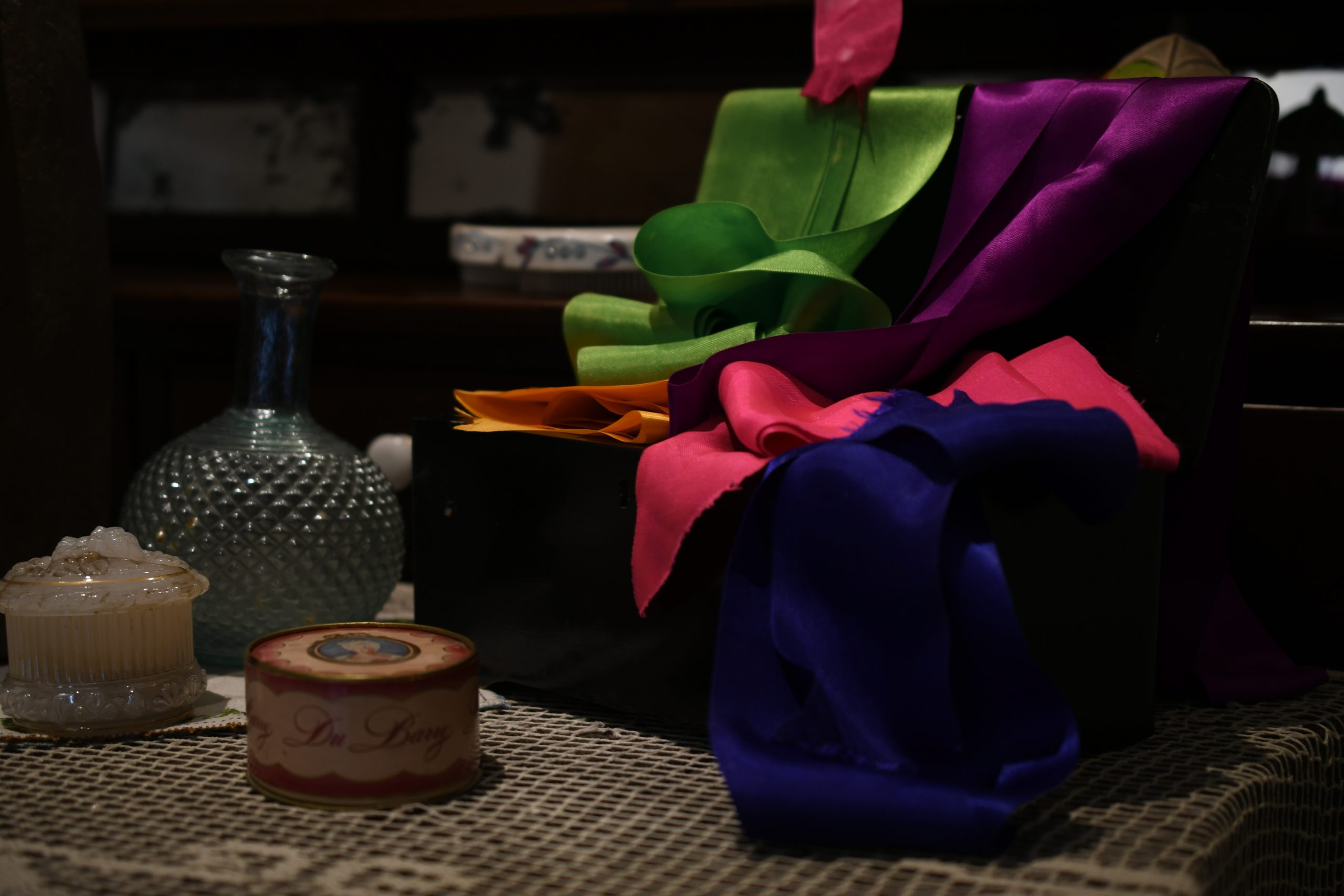
Ribbons that Frida used to decorate her hair
Frida often arranged her hair in two braids wound around her head. On special occasions, she joined them on the upper part of her head, decorating them with ribbons. This hairstyle made her look taller and seemed to ceremoniously crown her.
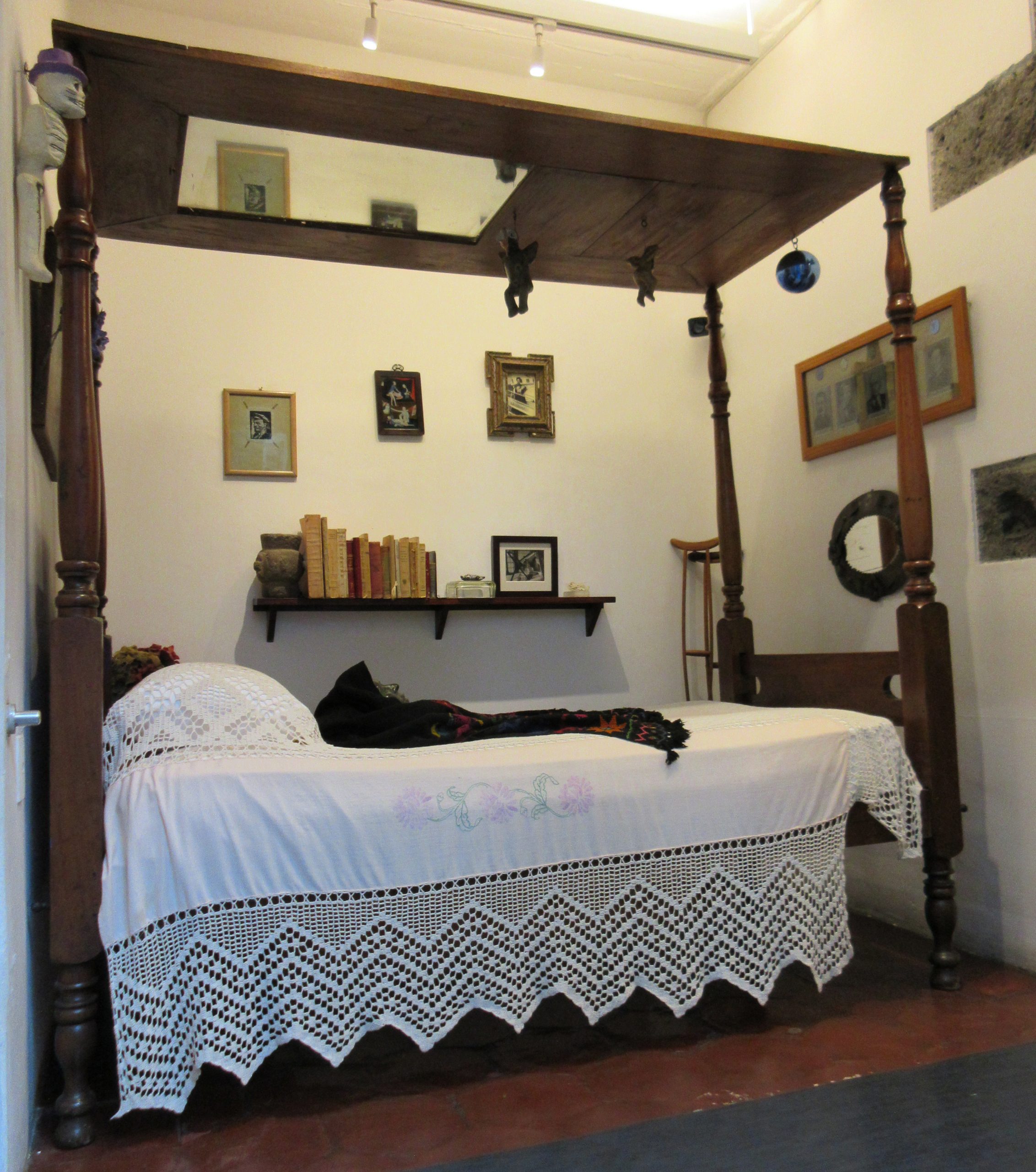
Bed with mirror that her mother had placed on the underside of the canopy after the accident allowing Frida to paint herself
Frida’s bed is one of the most important pieces in our collection in the Casa Azul. The artist spent key moments of her life in her bed: she recovered from polio in 1913; she convalesced after the bus accident in 1925; and she died in the early hours of July 13, 1954.
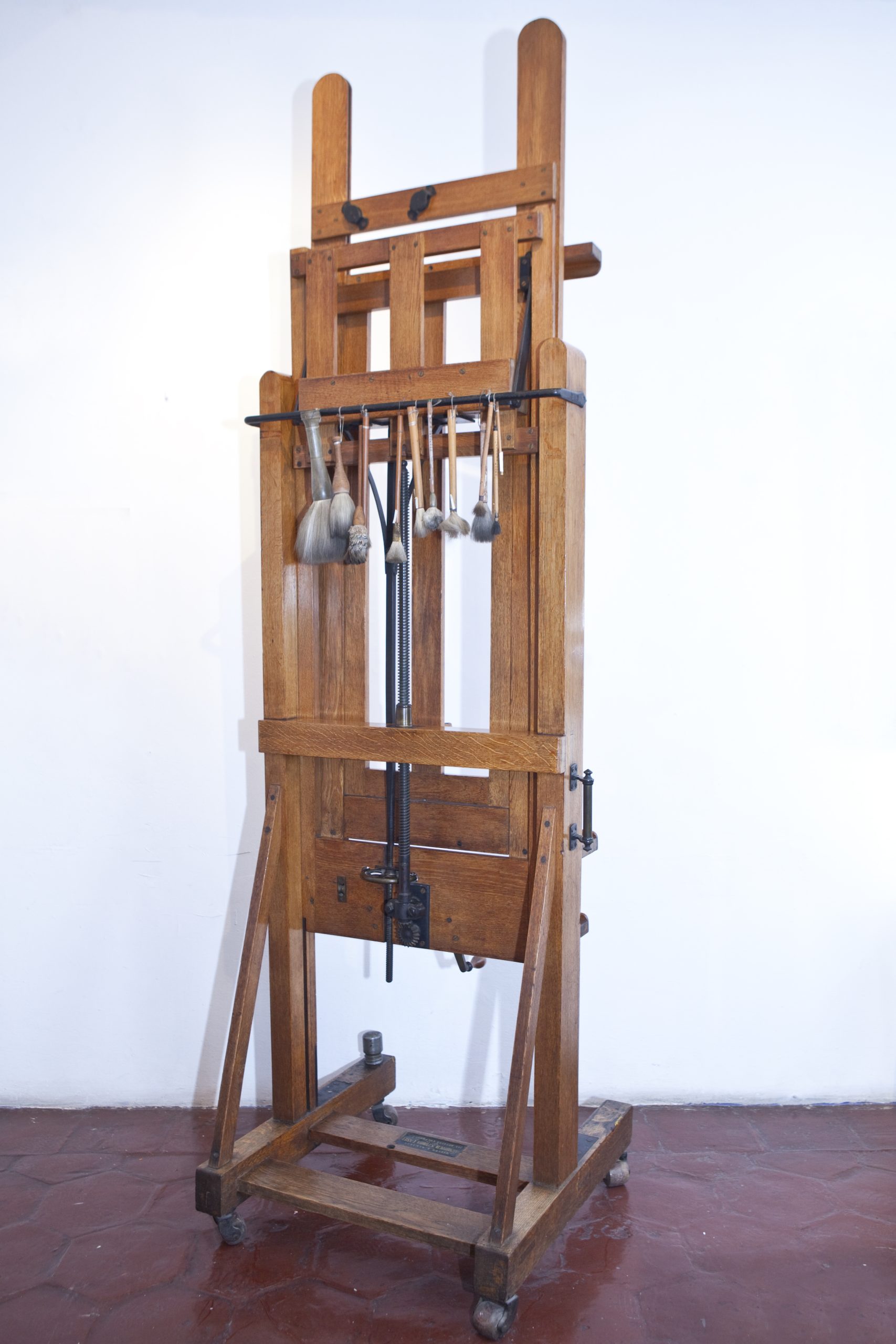
Easel, a gift from United States millionaire Nelson A. Rockefeller
In 1930, Diego and Frida lived in New York. While Rivera was designing the Rockefeller Center mural, the young Frida painted in her wheelchair. Nelson Rockefeller, son of John D. Rockefeller, the magnate who had commissioned the Rockefeller Center mural, decided to give Frida a special easel for artists with limited mobility.
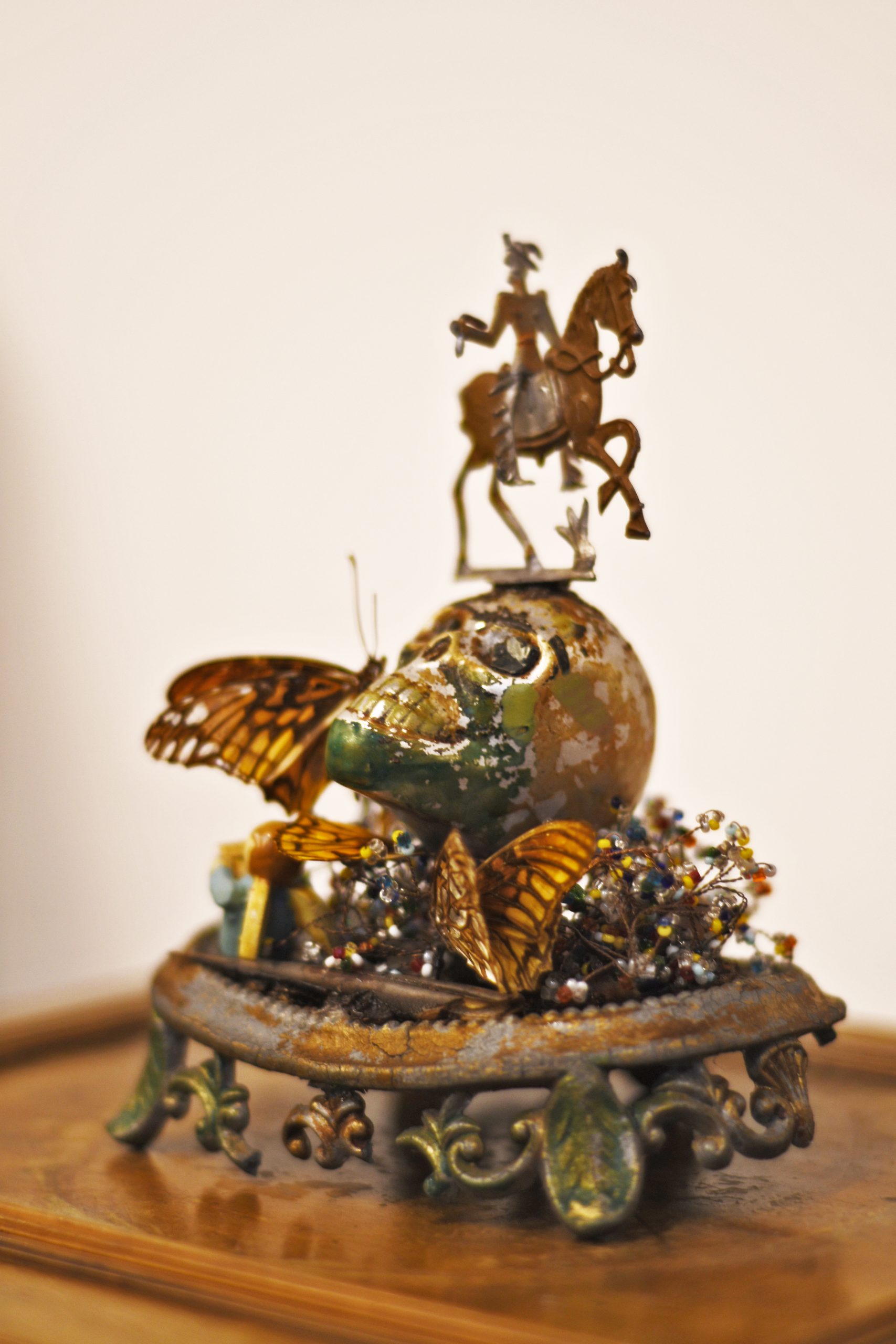
Sculpture made with pieces of metal, butterfly wings, and miniature decorative elements
This interesting small-scale sculpture is composed of the assemblage of several miniature figures. It is one of the pieces in the collection that stands out for its modern, highly personalized design, and is the result of her unique creativity.
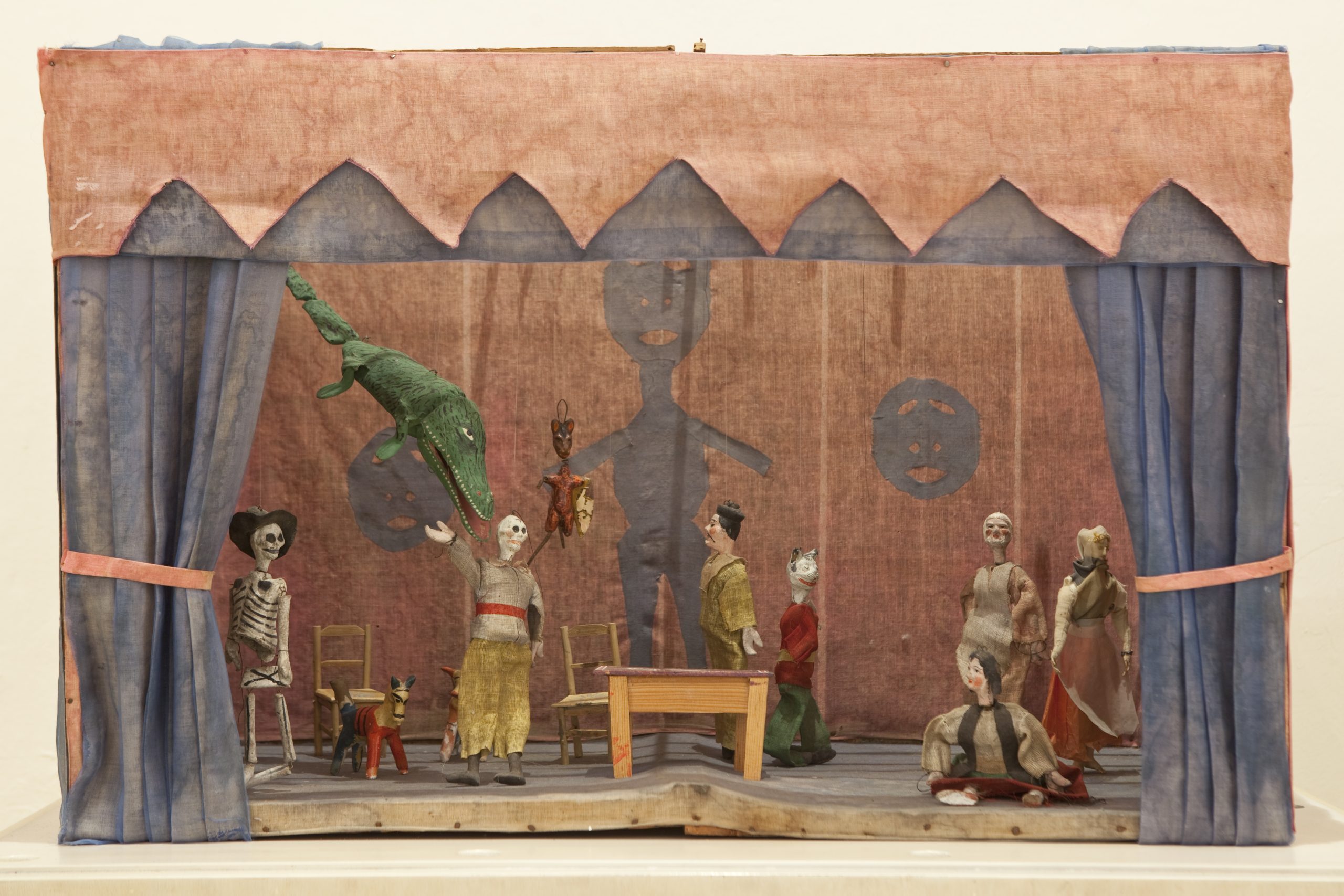
Puppet theater, toy created by Frida using wood, fabric, and wire
Ever creative, the artist played with this miniature theater during her convalescence after her multiple surgeries. Frida also invented tales that she performed to entertain her beloved niece and nephew, Isolda and Antonio, Cristina’s children, who often visited the painter.
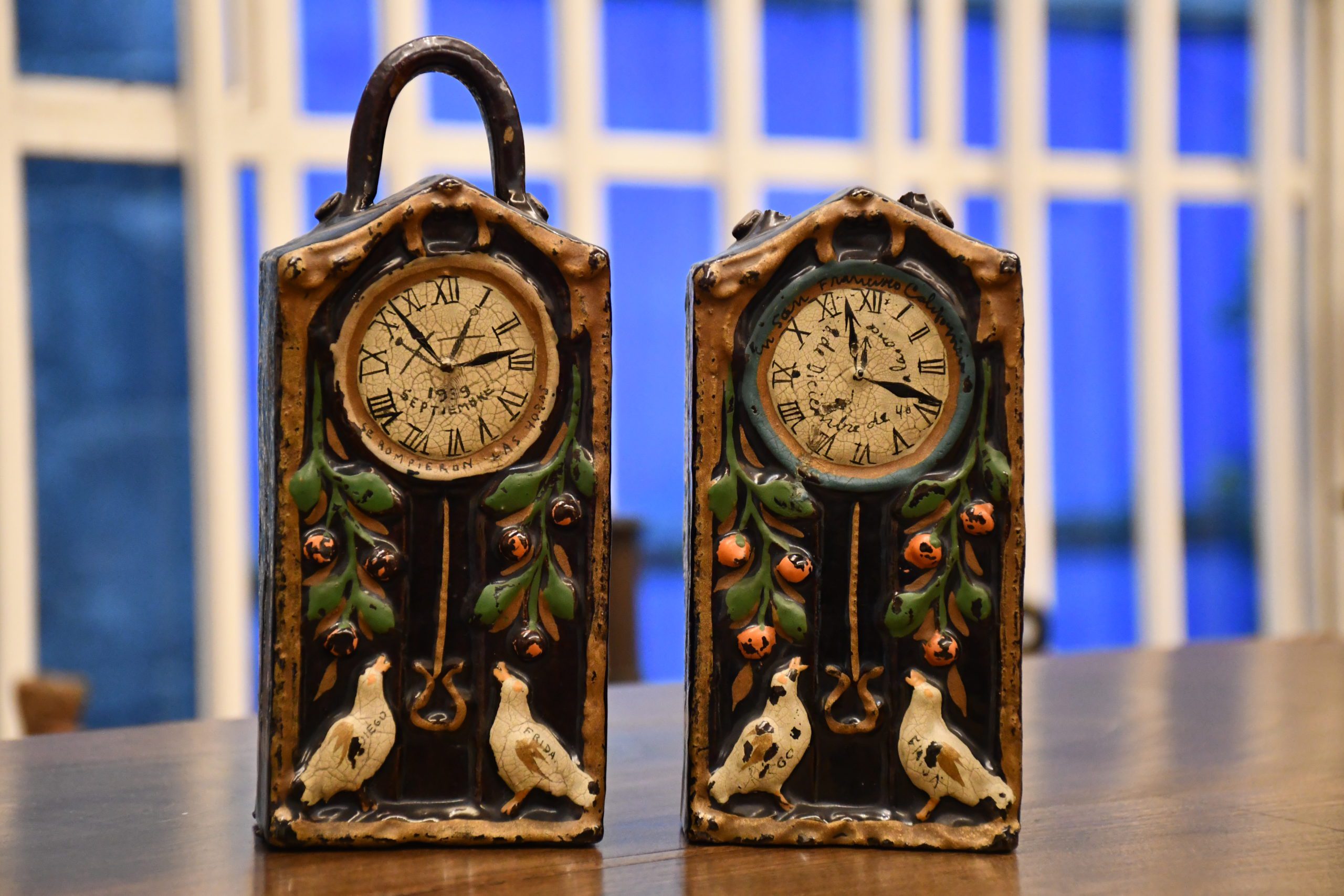
Ceramic clocks intervened by Frida Kahlo
These ornamental clocks were intervened by Frida to indicate the date when she divorced Diego in 1939, and the day and hour when they remarried:
“December 8, 1940, at eleven o’clock.” In her highly personal way, the artist documented two decisive moments in her personal life.
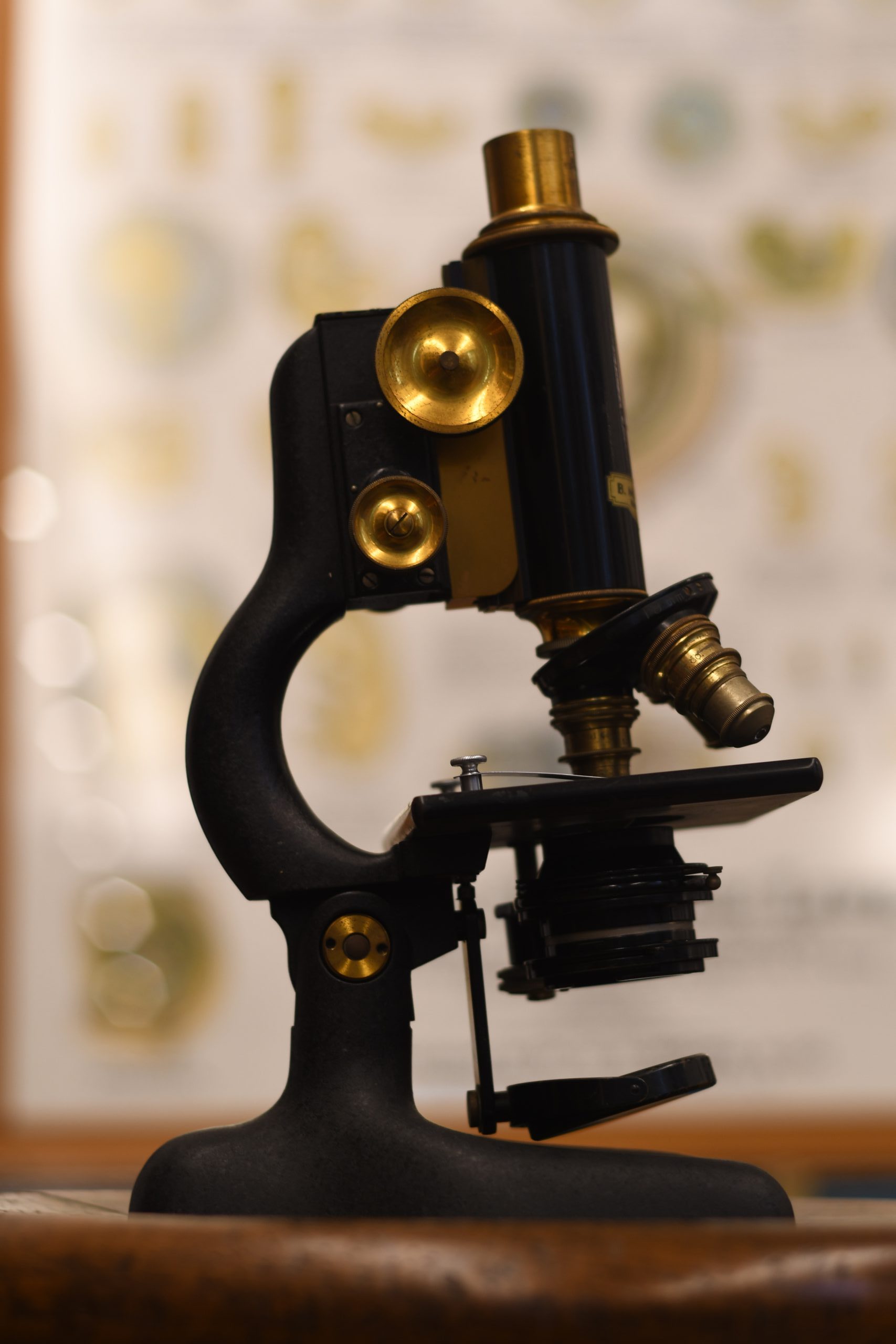
Microscope
Frida used this microscope since she was a child. The artist took walks with her father and returned laden with plants and insects, which she observed under this lens. As an adult, she used it to examine cellular tissue that she included in some of her paintings, as in the background of
Portrait of My Father, Guillermo Kahlo (1952).
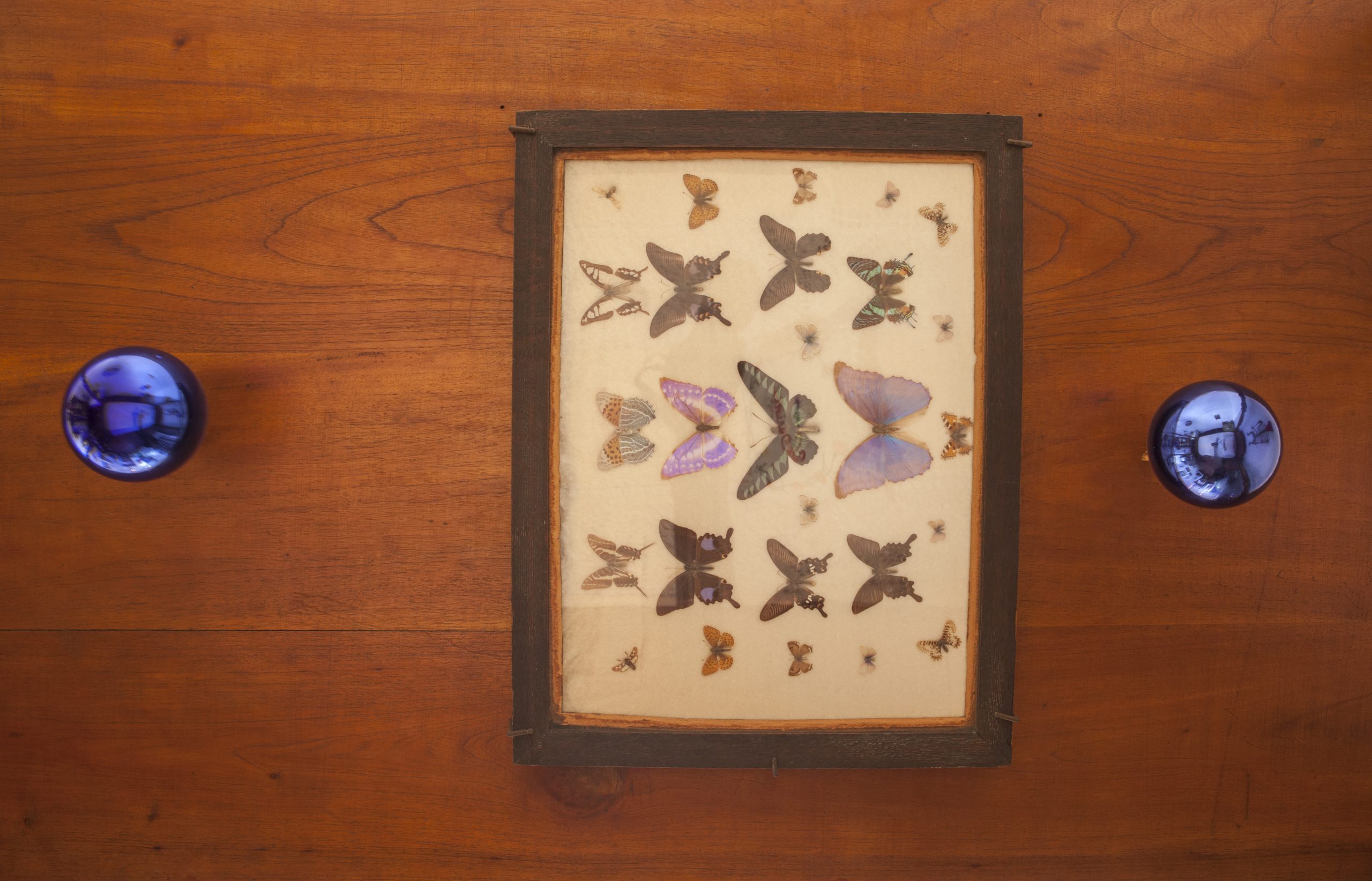
Butterfly collection, gift of the sculptor Isamu Noguchi
Various butterflies from this collection are Xerces blue (
Glaucopsyche xerces), originally from California and extinct since 1941. This unusual collection of butterflies was a gift from the American sculptor, Isamu Noguchi, to Frida.
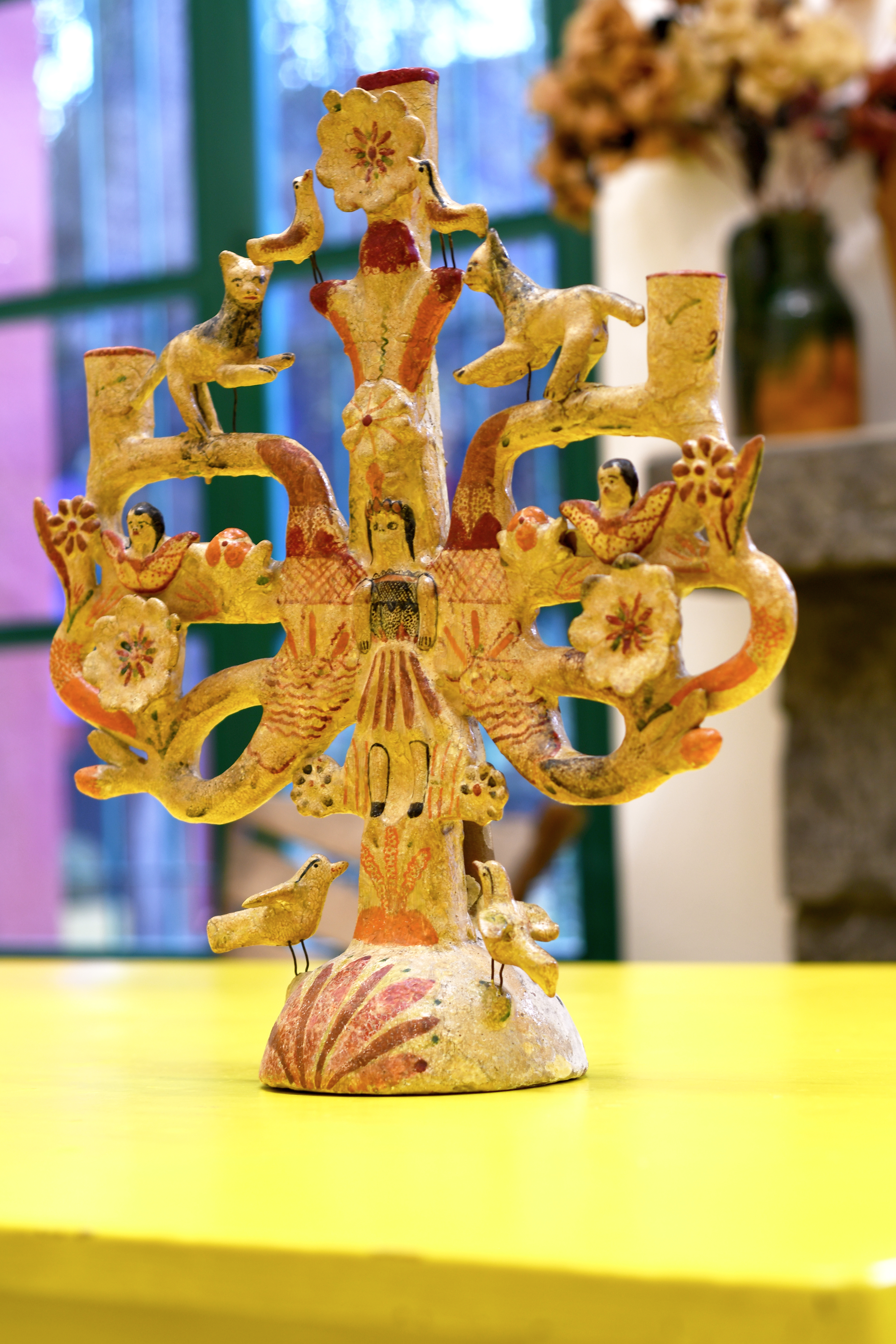
Tree of life candelabra of molded and modeled clay, appliqué, and post fire polychrome paint
Attributed to Aurelio Flores, this piece exemplifies the folk art of Izúcar de Matamoros, Puebla, (ca. 1940).
Trees of life generally illustrate the duality of existence, or the connection between humankind and nature. These themes—duality and human interaction with flora and fauna—are also present in Frida’s work.
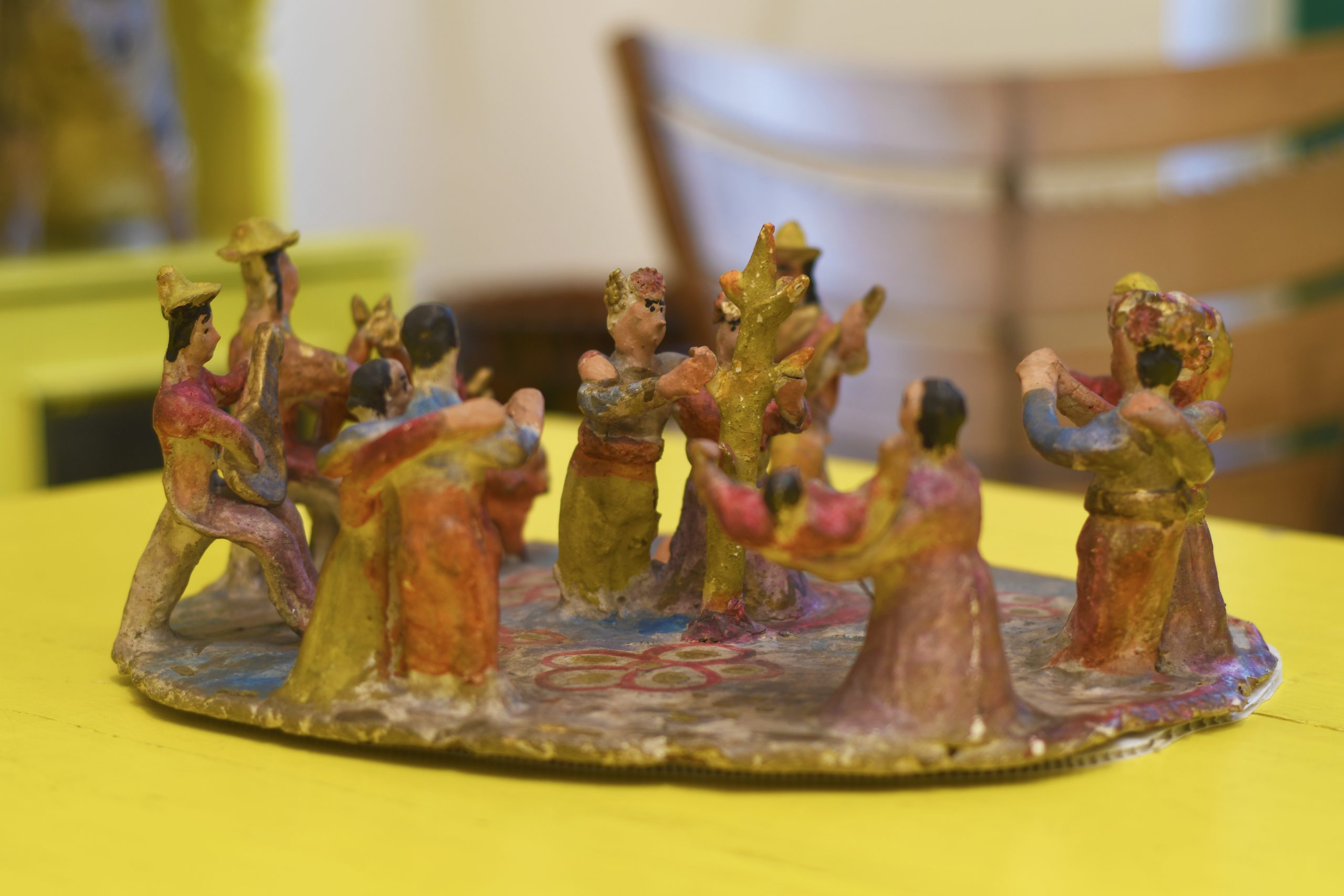
Ceramic composition depicting a folk celebration
Frida and Diego decorated their home with an array of folk art. They specifically liked pieces that alluded to the everyday and celebratory life of the Mexican people. Popular festivals and traditions passed down from generation to generation are vividly portrayed in pieces that Frida and Diego treasured.
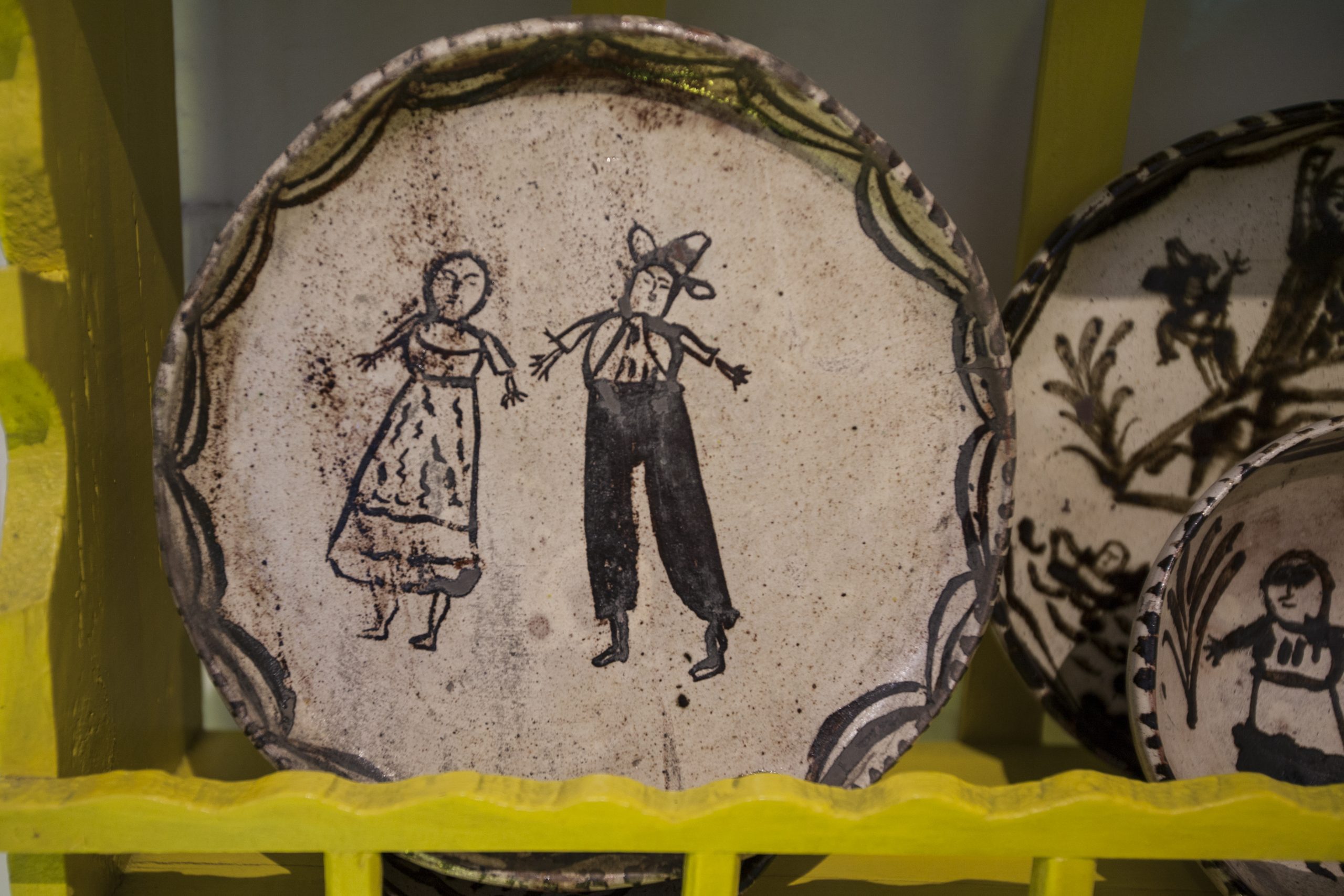
Ceramic plate with images of Frida and Diego
Frida and Diego made a distinction between essentially ornamental folk art and handicrafts, which were primarily functional. They admired both expressions equally, so much so that they are depicted on this ceramic plate that was part of the decoration in their home.
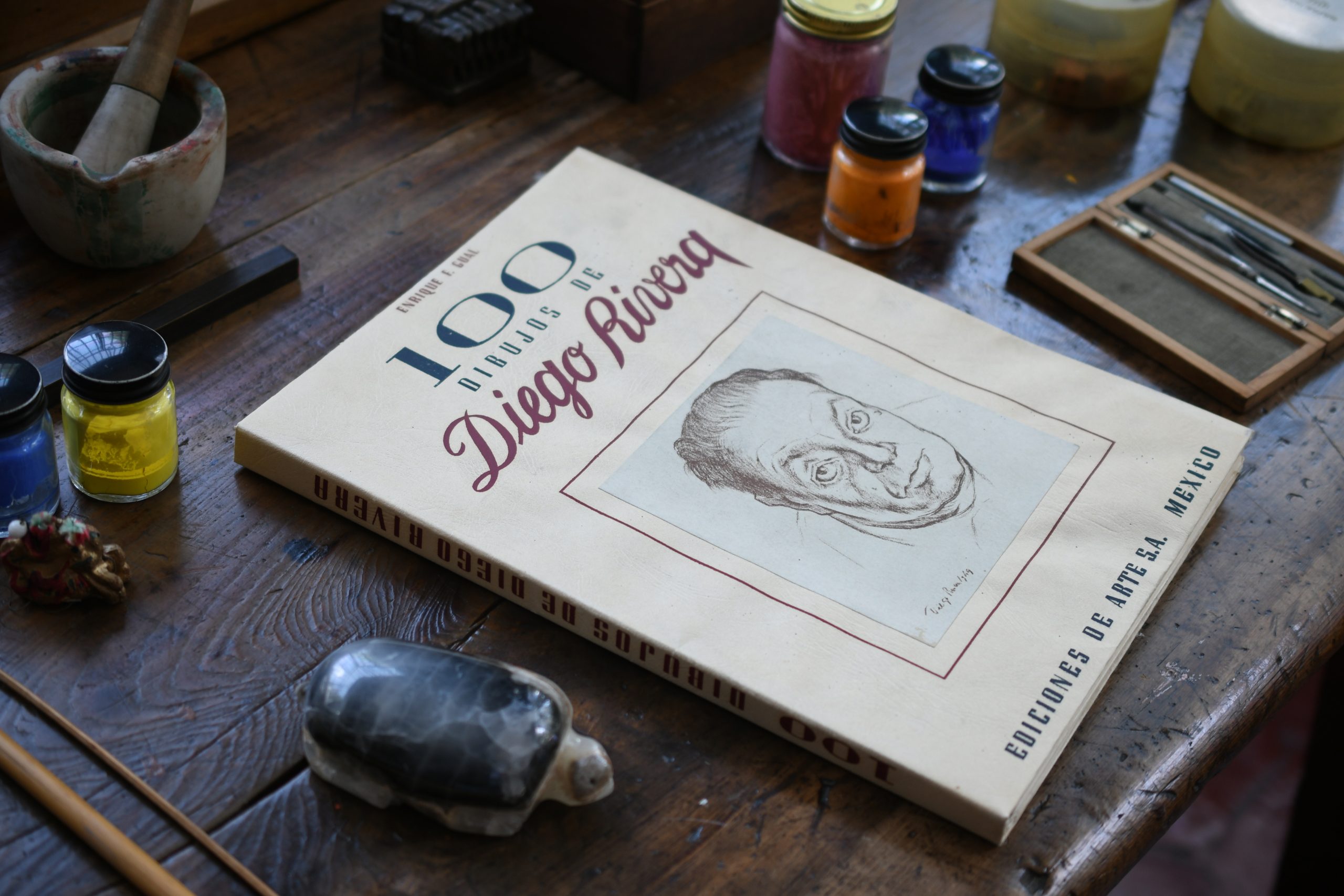
Enrique F. Gual, 100 dibujos de Diego Rivera, Ediciones de Arte, Mexico City, 1949
This book was illustrated with Rivera’s drawings in Frida’s collection. Diego dedicated this volume to his
“little girl Fisita Kahlo de Rivera with all my love . . . ”
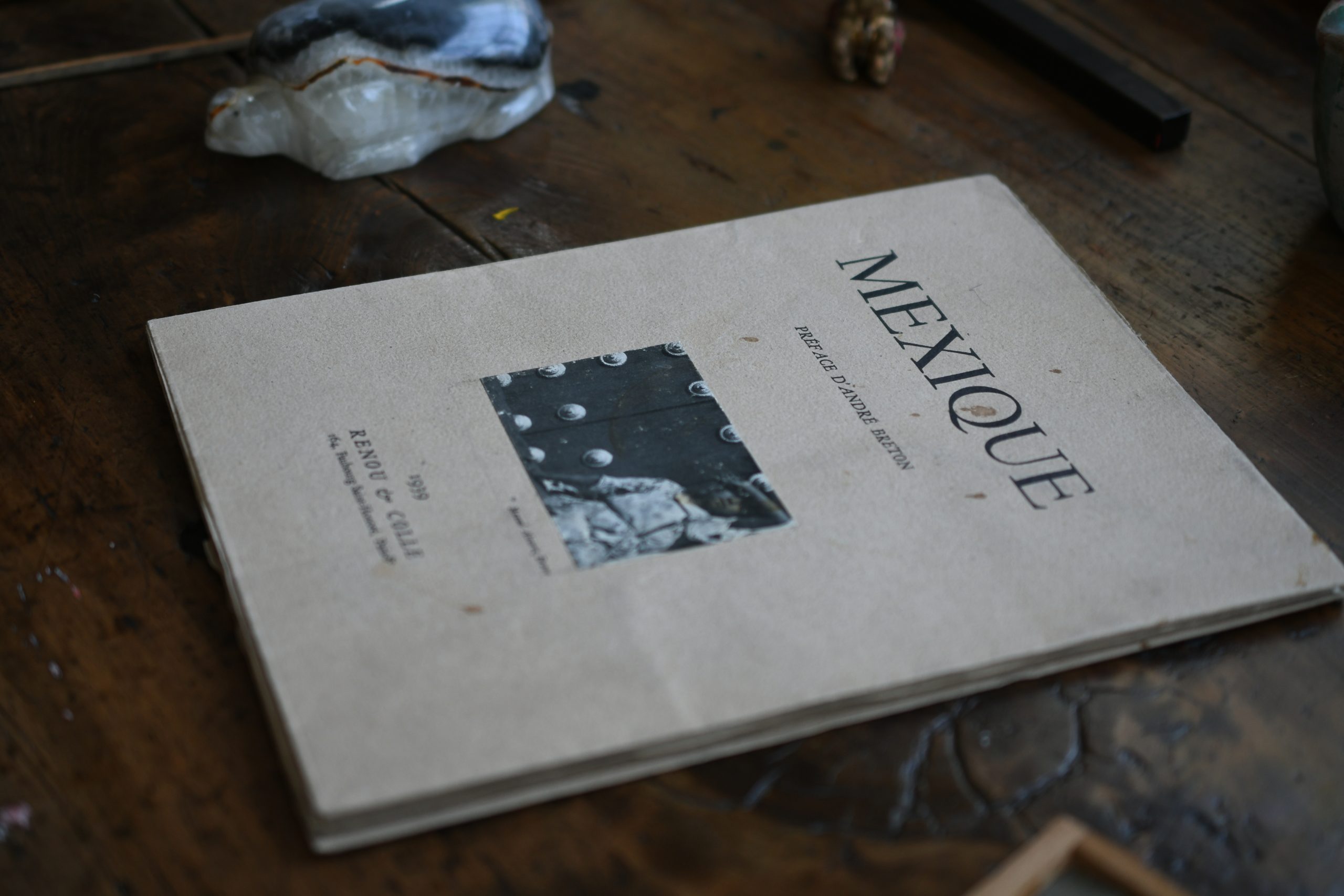
Catalogue for the exhibition Mexique, held in Paris in 1939
In 1939, Frida participated in a collective exhibition in Paris, alongside famous artists like photographer Manuel Álvarez Bravo. The catalogue from his historical exhibition is part of our holdings in the Casa Azul. In conjunction with that exhibition, the French government bought from Frida the self-portrait
The Frame, today on permanent display in the Pompidou Center.
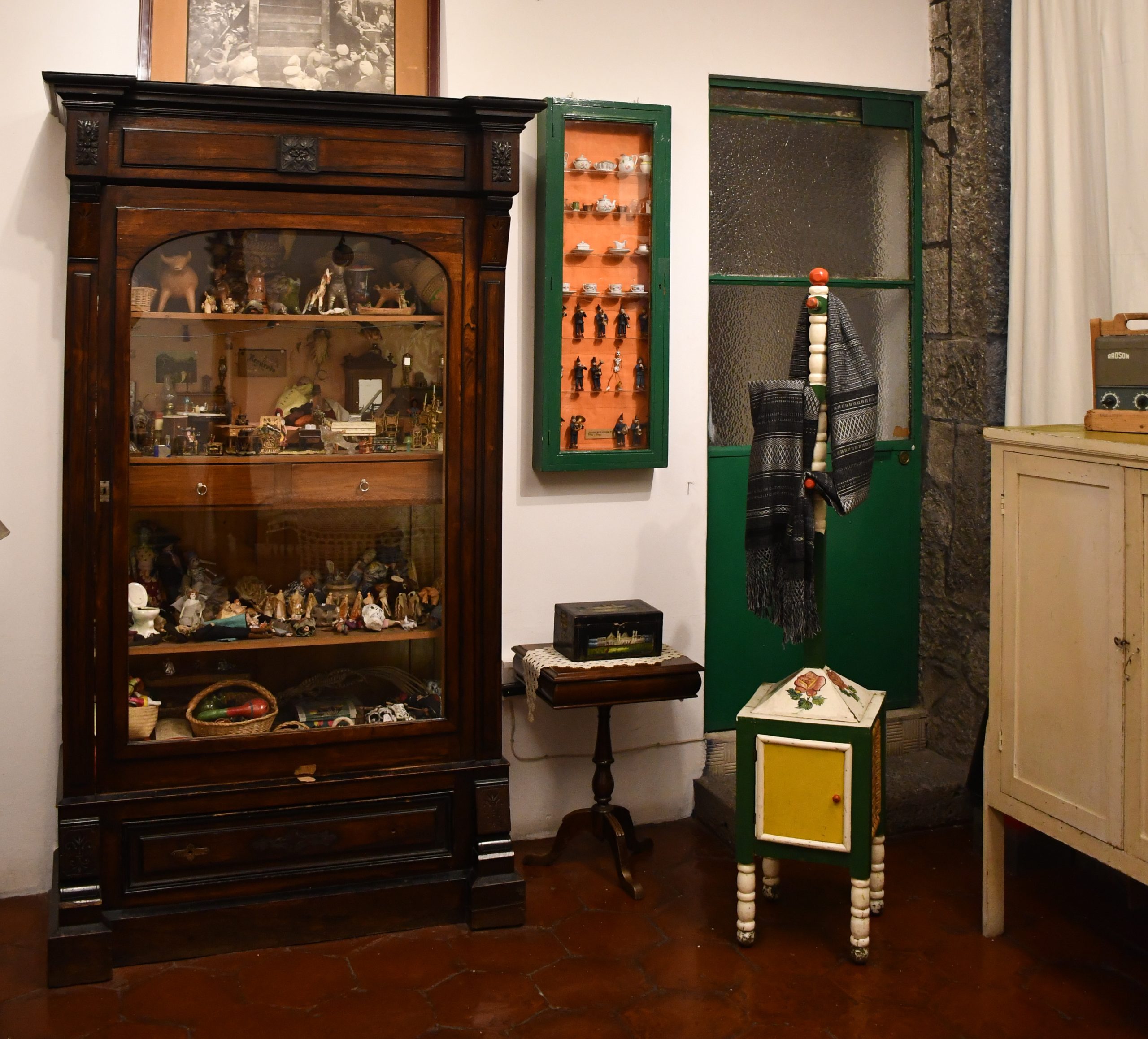
Toy chest, which contains pieces such as dolls and miniatures
Frida collected all types of figures: from palm leaf to rag dolls, and those made of ceramic, ribbons, as well as miniatures: tiny animals, metal pitchers . . . Some of these pieces are illustrated in her paintings; others were part of her puppet theater; she shared several others with her niece and nephew. Frida kept these small treasures in this toy chest.
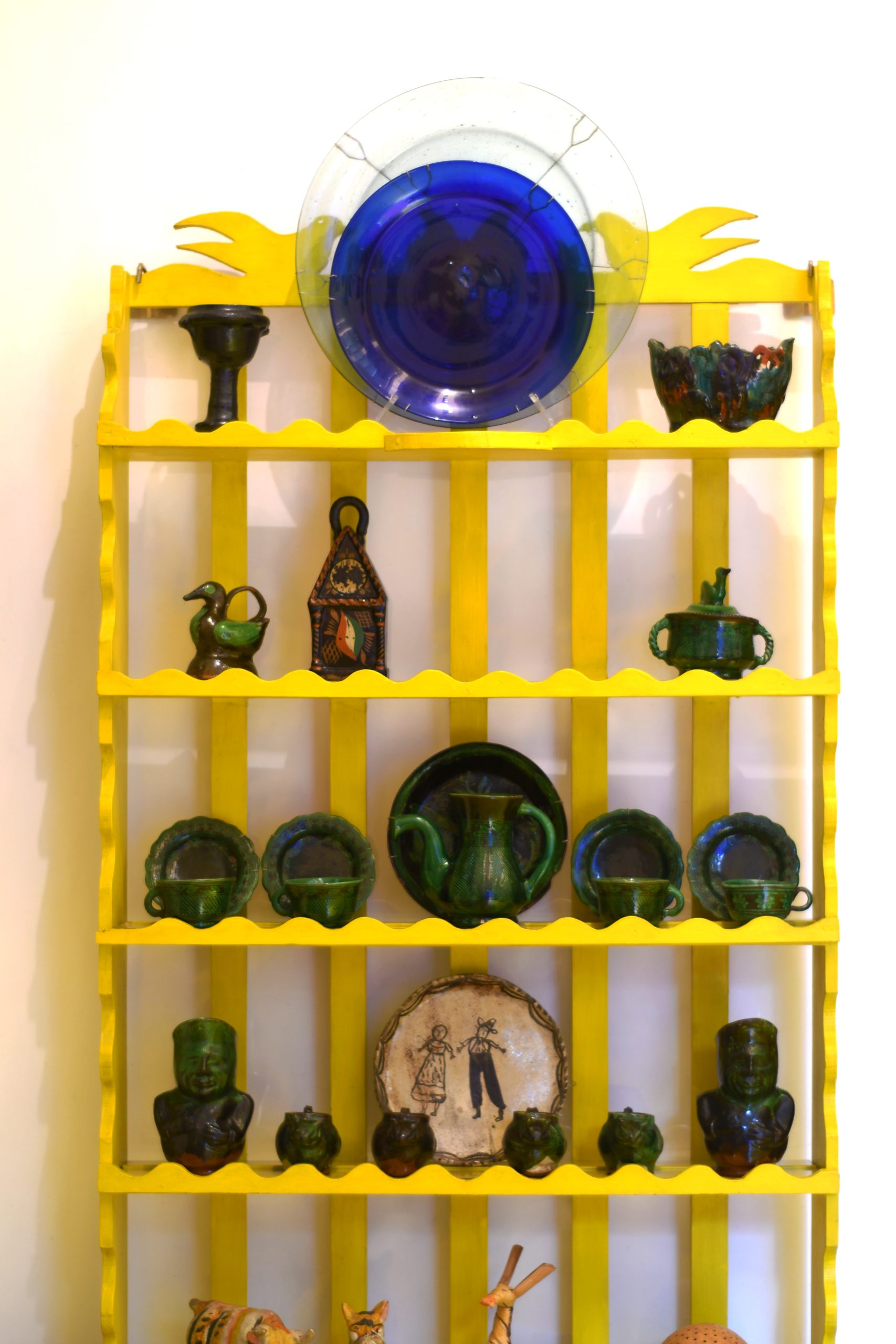
Dish cupboard, furniture that displays ceramic and glass handicrafts
When Frida and Diego designed and painted the Casa Azul, the artists switched the European-style furnishings that decorated her childhood spaces to Mexican folk furniture. This dish cupboard attests to the aesthetic coherence of her choices and displays treasures of folk art that both artists collected.
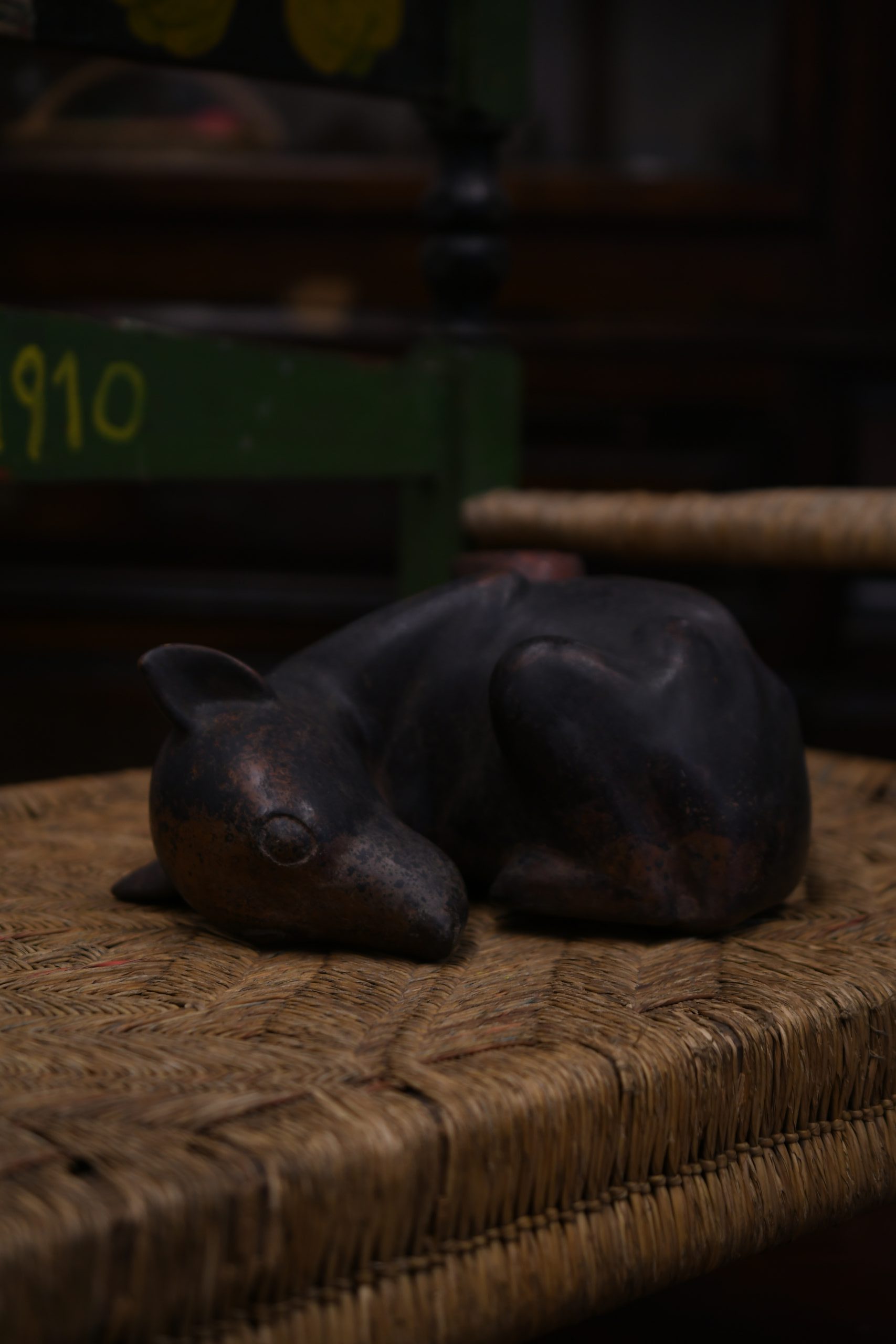
Pre-Hispanic piece in the shape of a dog accompanying Frida’s ashes on her altar
One of Frida’s favorite pets was Mr. Xolotl, a Xoloitzcuintle or Mexican hairless dog. In Mexica tradition, these animals guided the dead on the journey to the underworld. Therefore, it sits on the dressing table that Frida used and that now serves as an altar where her ashes rest.
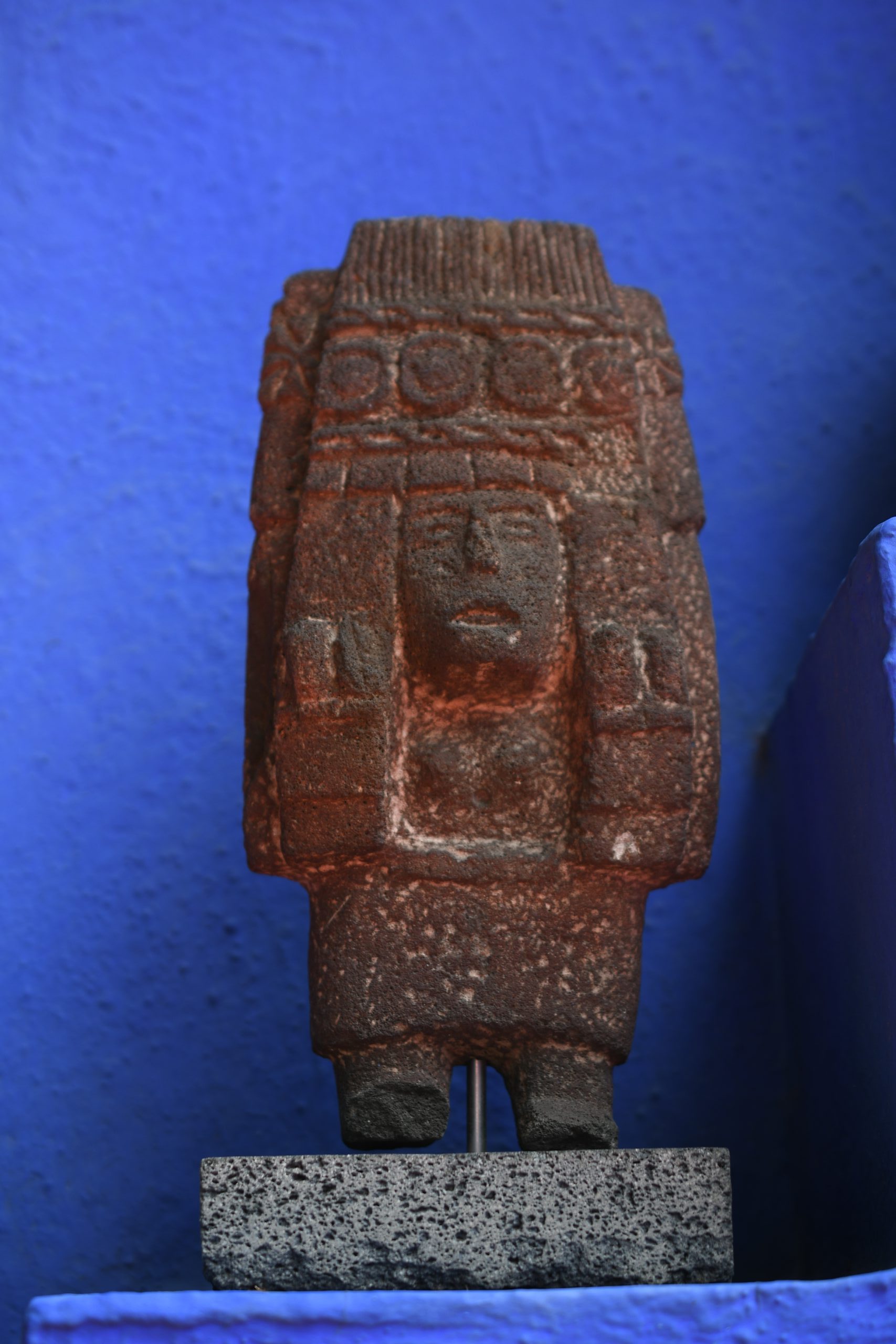
Chicomecoatl, a basalt sculpture of the Mexica maize and fertility goddess
Frida and Diego admired pre-Hispanic art, which Rivera assiduously collected and amassed more than 60 thousand pieces. In the Casa Azul garden, they installed Pre-Columbian sculptures, such as this maize and fertility goddess. As tradition would have it, she was the creator of tortillas.
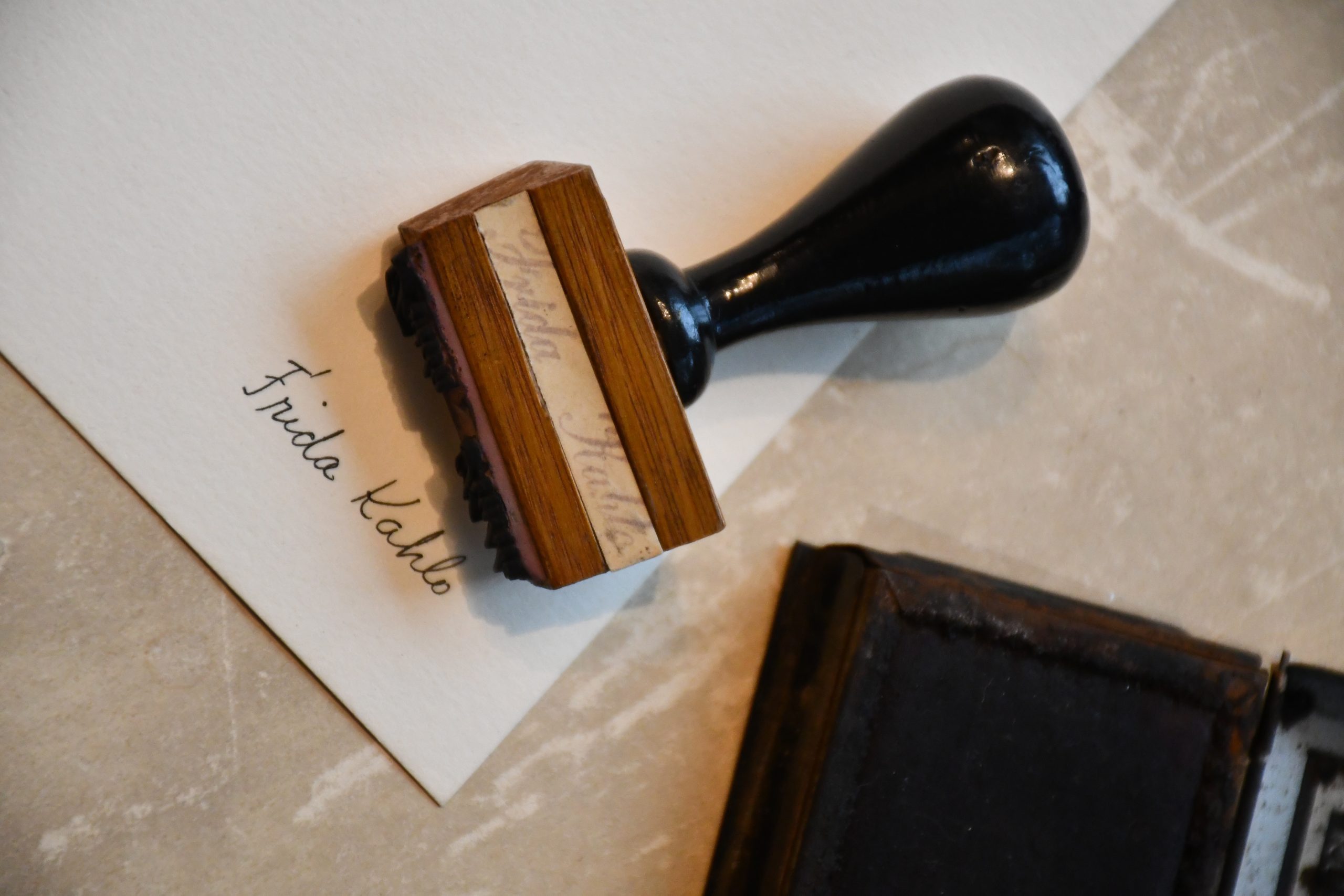
Stamp with Frida’s name, perhaps a gift
In Frida’s lifetime, these stamps were commonly used to sign documents elegantly and uniformly. The artist rarely used hers because she preferred to sign her documents by hand. So, it was probably received as a gift that she nevertheless carefully tucked

Canvas by Diego Rivera, The Alarm Clock, oil on canvas from his Cubist period, 1914
Diego Rivera lived in Paris in the 1910s when he was in contact with avant-garde movements. He experimented with Cubism for several years. This work is one of the most significant in his Cubist phase for its “Mexican-style” palette, which triggered such controversy among critics that Rivera decided to abandon this style shortly thereafter.
© D.R. Banco de México, fiduciario en el Fideicomiso Museos Diego Rivera y Frida Kahlo

Drawing by Diego Rivera, Portrait of Nahui Olin (Carmen Mondragón), sanguine and charcoal on paper, 1921
This portrait of Mexican painter and poet Carmen Mondragón, better known as Nahui Olin, and the partner of Dr. Atl, attests to Rivera’s distinctive style. The muralist usually altered his models through interpretation, rather than adhering to resemblance with the sitter.
© D.R. Banco de México, Fiduciario en el Fideicomiso Museos Diego Rivera y Frida Kahlo
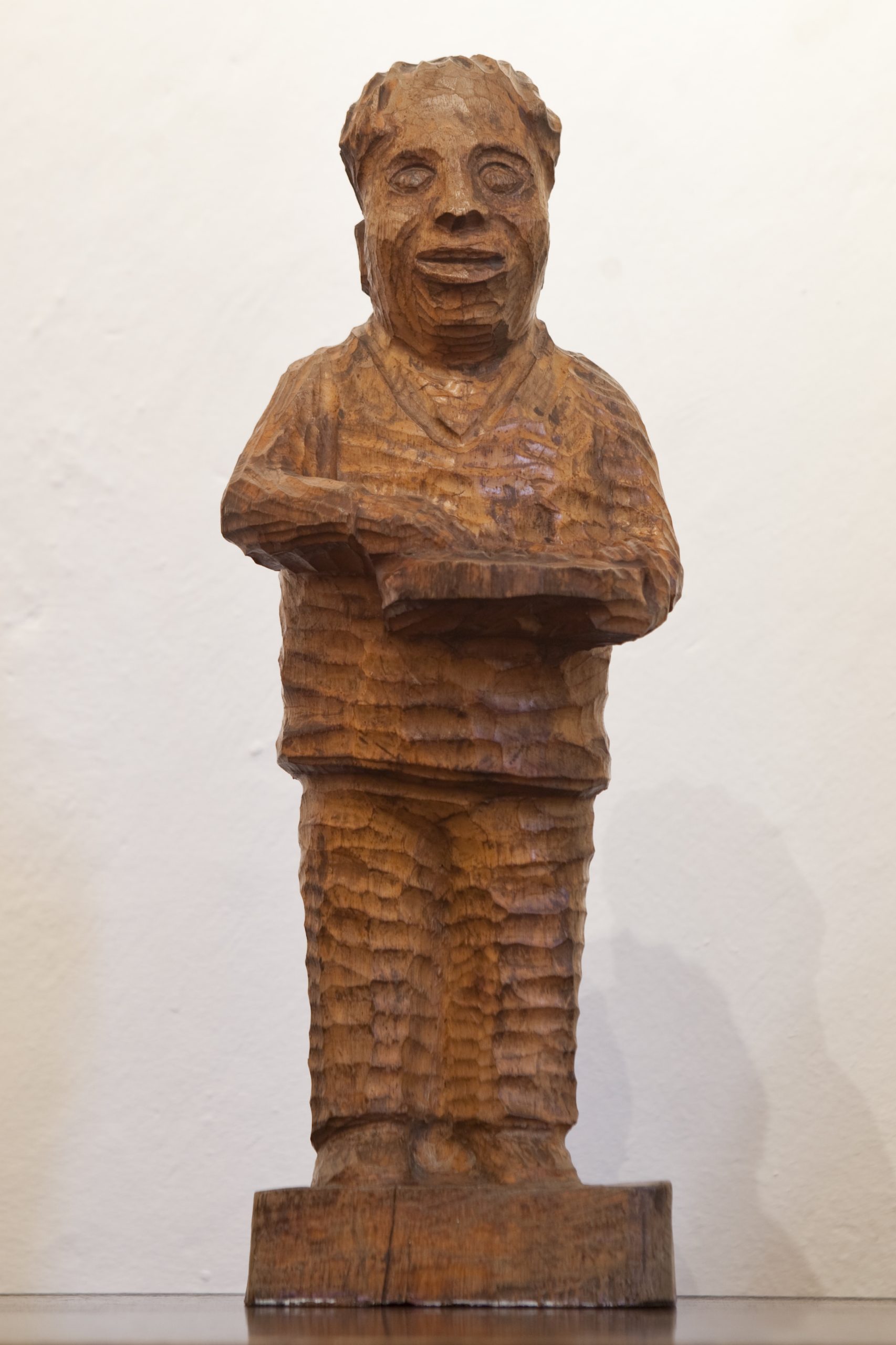
Wooden sculpture representing Diego Rivera, by the artist Mardonio Magaña
When he left his hometown of Guanajuato to live in Mexico City, Mardonio Magaña began to work as a janitor in the Open-Air Painting School in Coyoacán. In his free time, he carved stone and wood. At the age of fifty-five, he was discovered by Diego, who successfully promoted his work. Today Mardonio Magaña’s pieces are found in museums worldwide. Probably in thanks, the sculptor carved Rivera this expressive figure.

Various medicine bottles
Throughout her life, especially after each of the more than twenty surgeries that she underwent, Frida had to take a variety of analgesics, antibiotics, and food supplements. These bottles are associated with the pharmacology used to address her ailments.

Frida’s makeup: lipstick, nail polish and files, eyeliner, blush
Despite her precarious health, Frida made an effort to look her best. Her favorite color for nails and face was red, as seen in the nail polish and lipstick she used.
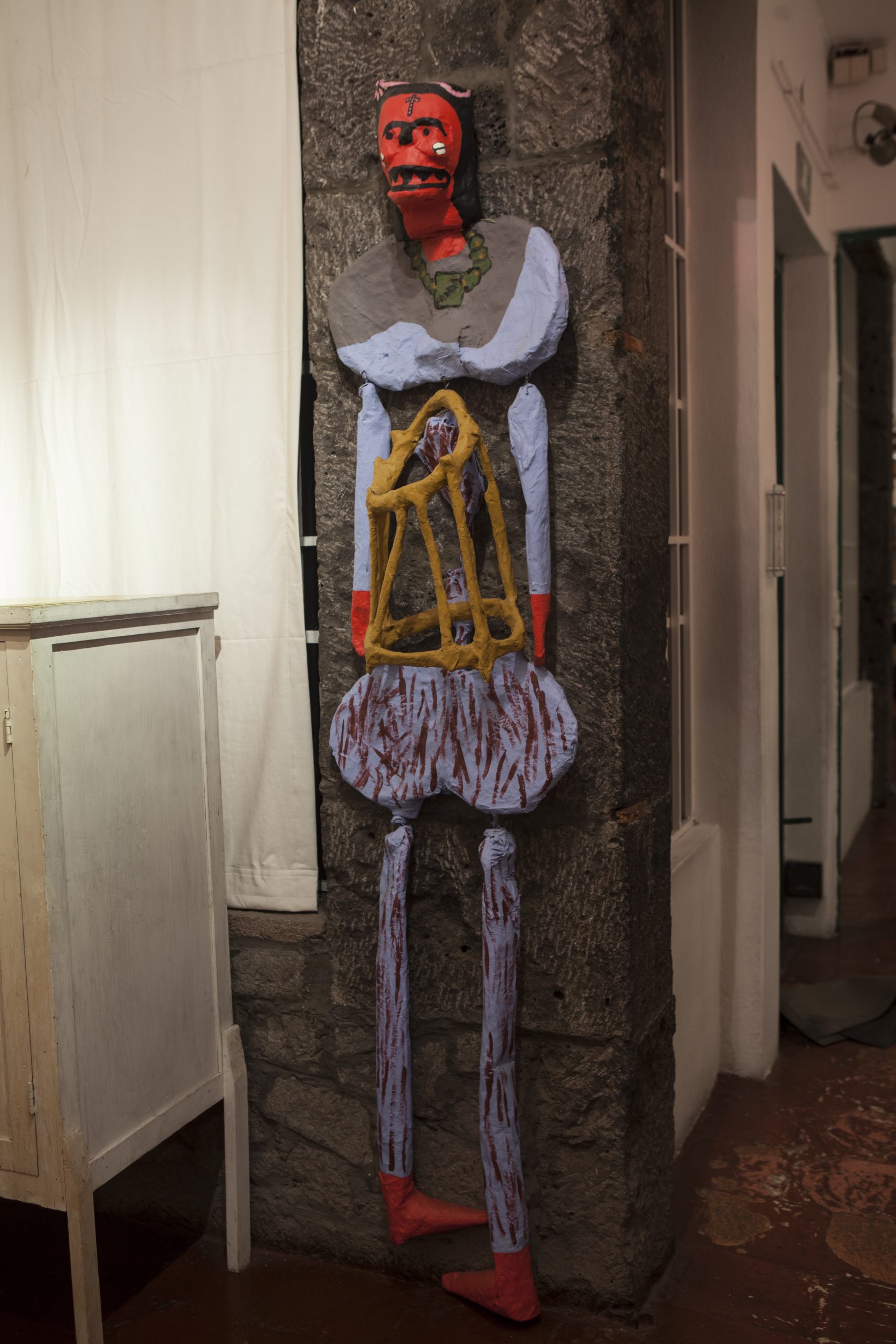
Judas figure depicting Frida, made of wire and papier mâché
This is the only Judas figure in our collection with a name written on it: Frida. The figure has joined eyebrows and a necklace of the type worn by the painter. In addition, it has a shorter right leg just as the artist. It is likely that Frida had intervened this piece to accentuate its similarities with her.
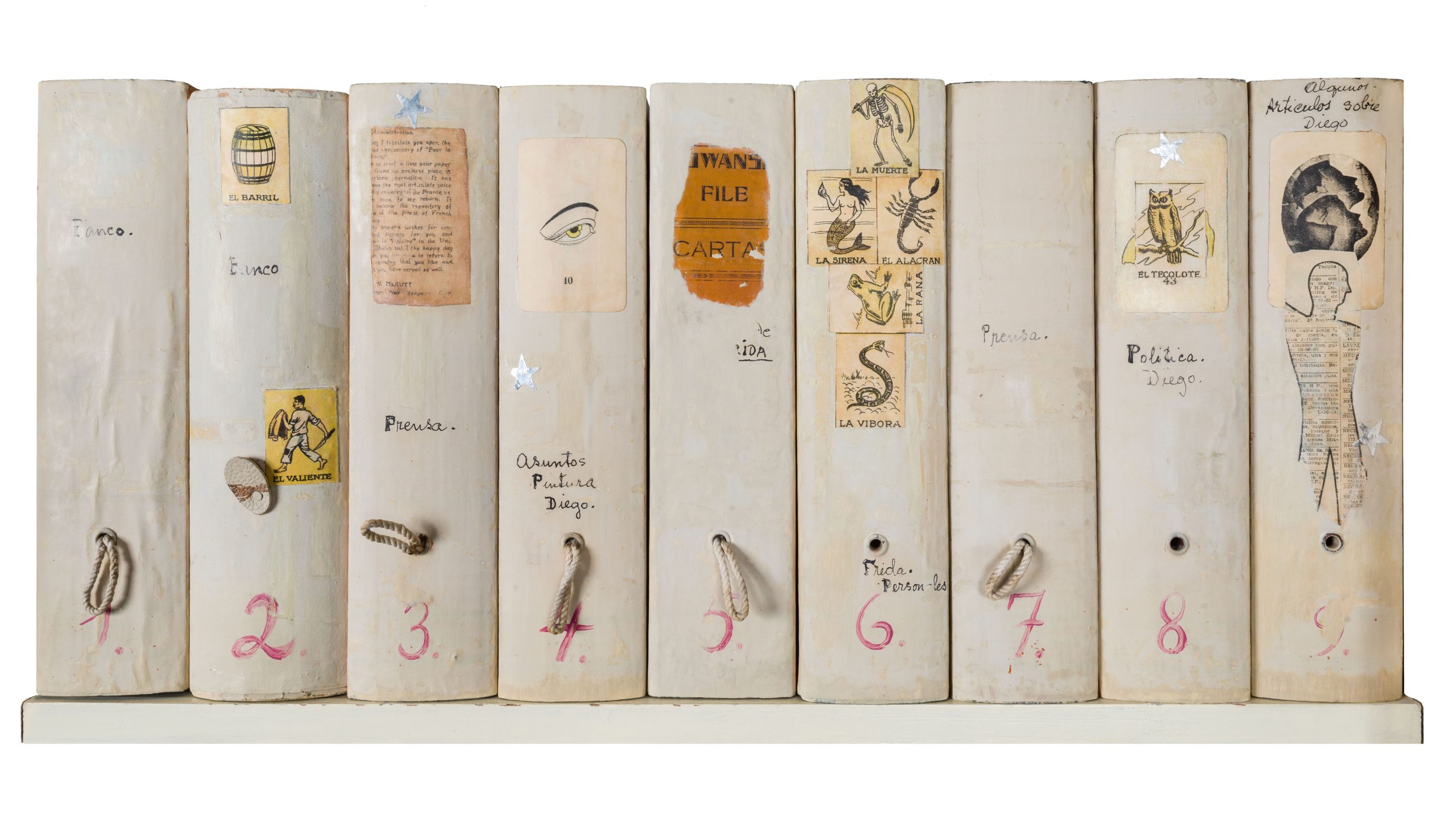
Notebooks of documents, decorated with popular illustrations
With her usual rigor and creativity, Frida organized Diego’s papers and household documents in these notebooks. Organized by subject—friends, work, various—the painter cut out illustrations from lottery game cards or postcards to decorate the spines of each file. Thanks to these originals, today we can better recognize the professional and personal lives of both artists.

Ex-voto that tells of a cart accident, with Saint Nicholas Tolentino to the right, helping the victims
Frida and Diego’s ex-voto collection is composed of more than 450 pieces and is regarded as one of the most complete in the country. Most of these popular ex-votos express gratitude for having overcome some illness, misfortune, or accident, as in this case, which reads:
“I give thanks to God Our Lord for [the] intercession of St Nicholas of Tolentino [who] saved the life of Jesús García, Antonio Ávila y Benito, for his cart overturned with everything and the mules . . . and it happened in in the month of Nar (sic) 1934, La Barca, July 1936. Jesús García”
Frida probably identified with these images, equating them with her own life.

Ex-voto that tells of a man attacking a woman in bed. On the left is the Virgin of Talpa
The ex-votos that Frida collected were done between 1842 and 1934. Most of them are painted on sheet metal. She preferred those that told of accidents in vehicles or containing beds, women, and animals. In this case the text reads: “I give thanks to the Blessed Virgin of Talpa for the miracle that she performed by having saved my life on October 3, 1934. M Aragón, Guadalajara, October 3, 1934.”
The composition of this ex-voto is recognizable in Frida’s work
A Few Small Nips. The virtually flat perspective of the image contrasts with the atrocity of the subject matter.

Photo of the Casa Azul, taken by Gisèle Freund, Ex-votos in the Casa Azul, Coyoacán, Mexico City, 1951
Images such as this, forming part of our photo collection, show that today as in the past ex-votos, folk art, and typical Mexican furniture have been the leading components in the Casa Azul aesthetic.
Archivo Diego Rivera y Frida Kahlo.
Banco de México, fiduciario en el Fideicomiso Museos Diego Rivera y Frida Kahlo

Photo Frida Kahlo and Diego Rivera in the Casa Azul, (ca. 1952)
Frida and Diego liked to be photographed by artists who were generally also their friends. As a result, the museum has a number of emblematic photos such as this, in which the couple posed with pride in the Casa Azul.
Archivo Diego Rivera y Frida Kahlo.
Banco de México, fiduciario en el Fideicomiso Museos Diego Rivera y Frida Kahlo

Frida Kahlo and Diego Rivera on their wedding day (August 21, 1929)
Frida and Diego were wed in 1929. The artist described how she asked the servant who worked in her house to lend her a dress. In this photo, Frida looks serious and stands smoking alongside her husband.
Archivo Diego Rivera y Frida Kahlo.
Banco de México, fiduciario en el Fideicomiso Museos Diego Rivera y Frida Kahlo

Sketch for Frida’s work The Love Embrace of the Universe, the Earth (Mexico), Myself, Diego and Mr. Xolotl, (1949)
Frida usually planned out her compositions and ideas for her paintings in sketches, such as this example. The drawing is for one of her most complex works:
The Love Embrace of the Universe, the Earth (Mexico), Myself, Diego, and Mr. Xolotl. © D.R. Banco de México, fiduciario en el Fideicomiso Museos Diego Rivera y Frida Kahlo

Frida Kahlo’s passport, 1938
Given her physical condition, Frida found it difficult to travel. Nevertheless, she had to go abroad when she had an exhibition, as in the case of those in New York and Paris. To go to these cities, Frida crossed the Atlantic by ship. Her decisive character and her interest in art led her to overcome these obstacles with determination.
Archivo Diego Rivera y Frida Kahlo. Banco de México, fiduciario en el Fideicomiso Museos Diego Rivera y Frida Kahlo
